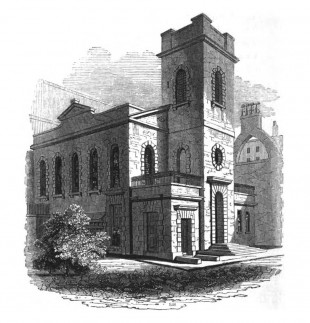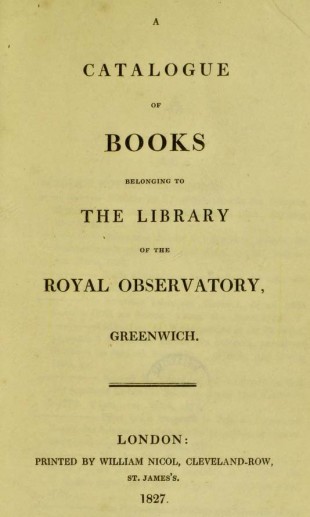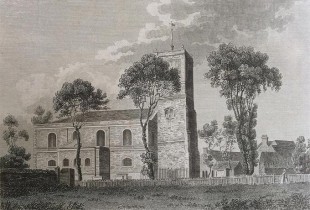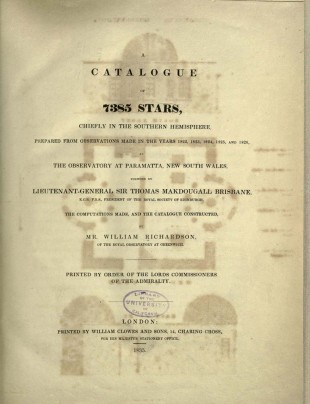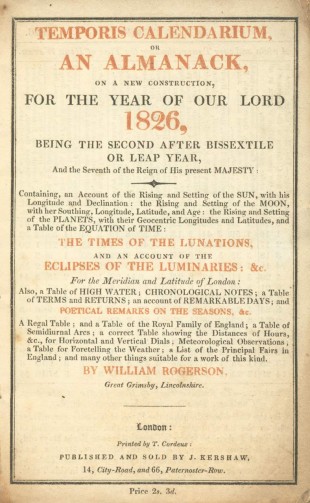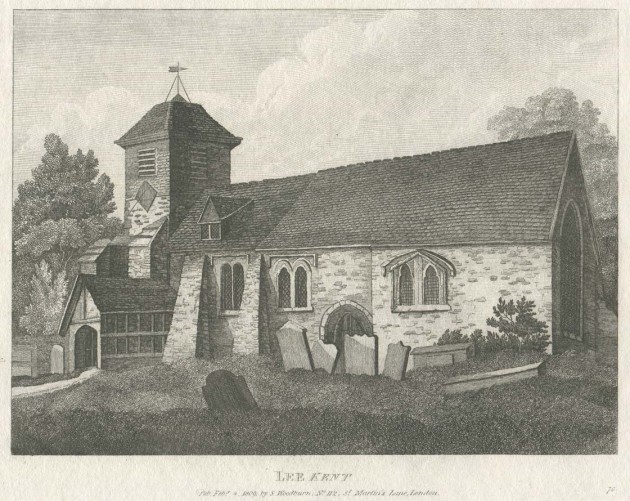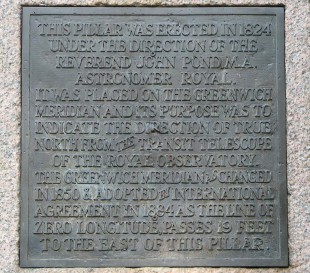…where east meets west
- Home
- Brief History
- The Greenwich Meridian
- Greenwich
(1675–1958) - Herstmonceux
(1948–1990) - Cambridge
(1990–1998) - Outstations (1822–1971)…
- – Chingford (1822–1924)
- – Deal
(1864–1927) - – Abinger
(1923–1957) - – Bristol & Bradford on Avon
(1939–1948) - – Bath
(1939–1949) - – Hartland
(1955–1967) - – Cape of Good Hope
(1959–1971)
- Administration…
- – Funding
- – Governance
- – Inventories
- – Pay
- – Regulations
- – Royal Warrants
- Contemporary Accounts
- People
- Publications
- Science
- Technology
- Telescopes
- Chronometers
- Clocks & Time
- Board of Longitude
- Libraries & Archives
- Visit
- Search
People: John Pond, the sixth Astronomer Royal
| Name | Pond, John | |
|
| Place of Work | Greenwich | ||
| Post | Astronomer Royal |
18 Feb 1811 – 11 August / 31 Sep 1835 (see notes below) | |
| Previous appointments | None | ||
| Born | 1767 |
London, baptised twice. Nov 18 (privately), Nov 23 (publikly) at St Katharine Coleman, City of London | |
| Died | 1836, Sep 7 |
At home; interred 13 Sep at St Margaret’s Churchyard, Lee Terrace, Blackheath |
|
| Marriage | 1807, Apr 16 | Anne Gordon Bradley (1789–1871); St Martin-in-the-Fields, Westminster. No known children |
|
| Known addresses | 1799–1803 | Bendle and Collier’s, Westbury, Somerset (see below) |
|
| |
1806, 1807 | 29 Henrietta Street, Covent Garden (RS EC/1806/15, MS/391/243 & RGO218/2/12) |
|
| 1807? | Bells, Little Scotland Yard (RGO218/2/12) | ||
| |
1811–1835 | Flamsteed House, Royal Observatory Greenwich | |
| |
1835–1836 | 2 Valentine Terrace, Blackheath Road (71 Blackheath Road)(RGO6/53/1) |
|
| |
|||
| Wealth at death | Unknown | Probate: 4 Oct 1836 |
|
| |
‘Mr. Pond, though independent in temper, was remarkably mild and gentle in his manners; and his health and disposition, together with his attention to his office, and his dislike to every thing like contention, which almost amounted to a failing, kept him very much at home, and out of the reach of general acquaintance.’
Obituary. MNRAS (1837)
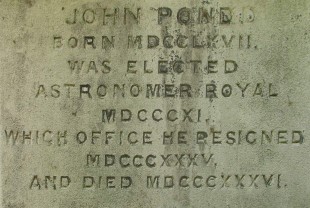
There are no known images of John Pond. Nor is there any known physical description. The inscription shown here is taken from the grave he shares with the second Astronomer Royal, Edmond Halley
Pond’s story is an interesting one that has several parallels with that of Margaret Burbidge who became Director of the Observatory in 1972. Burbidge was regarded as the best optical astronomer of her generation and Pond the best positional astronomer of his. Neither had the temperament to run a major observatory and both were in charge at key turning points in the Observatory’s history.
Pond was a skilled observer and it was on his watch as Astronomer Royal that some of the most significant new telescopes and improvements in observing techniques were introduced. It was also under Pond that the Observatory underwent (in percentage terms) its greatest expansion in staffing – the number of assistants being increased from one to six. It was under Pond, that the foundations of the modern Observatory were laid, that enabled it to meet the demands of modern science in the decades that followed.
Airy has a reputation for being a good record keeper and administrator. Rightly or wrongly, Maskelyne also has a good reputation, but Pond does not. When Airy was appointed, he was already Director of the Cambridge Observatory and had proven experience as a highly efficient administrator. Pond’s background was entirely different. It was that of an independently wealthy gentleman astronomer, who, bar a few lectures given at the Royal Institution, is not known to have worked for anyone else in his life. He was appointed, so it seems, almost entirely on the strength of a paper published in 1806 and two events that followed: the friendship that subsequently developed with Maskelyne and the advice he gave to the Observatory’s Board of Visitors on the upgrading of the Observatory’s telescopes.
As well as taking over the Royal Observatory, Pond also ‘offered’ to take on the responsibility for overseeing the production of the Nautical Almanac (RGO14/7/146). A greater number of errors crept into the printed text and the Almanac was brought into disrepute – something for which Pond has been unfairly blamed by later commentators. The 1818 Longitude Act made provision for two new paid positions to be created: a Superintendent of the Nautical Almanac and a Superintendent of Chronometers to be held either concurrently with that of Secretary to the Board of Longitude or as separate posts. The first holders of the posts were Thomas Young, who became Superintendent of the Nautical Almanac and Secretary of the Board in 1818 and Thomas Hurd, who became Superintendent of Chronometers in 1819. The lightening of Pond’s administrative load did not last long. In July 1821, his burden increased massively when the post of Superintendent of Chronometers was suddenly transferred to him. Overnight and with no extra staff, Pond suddenly became responsible for the distribution of chronometers to the Royal Navy together with the conduct of annual chronometer trials. To make matters worse, when Young died in 1829, Pond was required by the Admiralty to resume his previous responsibility for the Nautical Almanac.
The 1820s were a turbulent time in British science as battles and power struggles played out between the supporters and detractors of the Royal Society, the newly established Astronomical Society (which received its Royal Charter in 1831), the Board of Longitude and the Admiralty. Part of what was at stake was influence with government and a role in the dispensing of patronage for science. Amongst the key powerbrokers were the President of the Royal Society, who was chairman of the Observatory’s Board of Visitors and a member of the Board of Longitude, and the two Secretaries of the Admiralty: John Croker (1780–1857) and John Barrow (1764–1848), both of whom sat on the Board of Longitude and who between them, always had a seat on the Council of the Royal Society. Although Pond held key positions in all four organisations, his voice is seldom heard. As Rebekah Higgitt has observed: there is a sense that history took place around him. As the battles raged, their impact was felt not only by Pond, but by the rest of the Observatory staff as well. The powers secured by the fledgling (Royal) Astronomical Society, lead to the Observatory coming under intense scrutiny, especially after the Board of Longitude was abolished in 1828 and the Board of Visitors was reconstituted in 1830. But that was not all, Pond also found himself caught up in protracted arguments and discussions about the type of Assistants that should be appointed at the Observatory. It is here that his ‘dislike to every thing like contention’ becomes particularly apparent. In addition to this, Pond also had to defend himself against the very public accusations of incompetence by Stephen Lee as well as well as a damaging diatribe from Charles Babbage. These topics are dealt with in more detail below.
Pond’s life and work are full of enigmas and contradictions, made all the harder to understand by a dearth of documents of a personal nature. All too often Pond and his assistants have no voice of their own. We know nothing at all about Pond’s relationship with his wife Anne and far too little about the true nature of his relationships with his members of staff. Some of what we know in this area comes from documents available through genealogy web sites. Most of the rest, comes from Airy’s records relating to his own appointment as Astronomer Royal, together with information Airy gleaned after Pond’s death, from his widow and his assistants. Hugely important as this last source is, some of the original material does not survive, leaving us to rely instead on Airy’s selective and partial transcripts.
Pond’s name occasionally appears amongst the private correspondence of the Herschels and other individuals. Unfortunately, it was not possible to properly access much of this material while this page was being constructed due to the restrictions in place as a result of Covid-19. It is hoped to redress this shortcoming as soon as circumstances allow. In the meantime, specific references in the text to the Herschel letters have been taken from the catalogue compiled by the Adler Planetarium. A list of the relevant letters is appended towards the bottom of the page.
In the beginning (1767–c.1800)
Much of what has been written about the early life of John Pond is little more than a rewriting of the first four paragraphs of his obituary as published by the Royal Astronomical Society. Much of the information those paragraphs contain has been impossible to independently verify, so rather than attempt a further rewriting, their contents are transcribed below.
‘Mr. Pond was born in London about the year 1767. His father realised in trade a fortune sufficient to enable him to retire in the prime of life, and to settle at Dulwich, where he passed the remainder of his days. When about seven years old, Mr. Pond was sent to school, under the Rev. Mr. Garrow, at Hadleigh, near Barnet; and, two or three years afterwards, to Mr. Cherry, then master of the free grammar-school at Maidstone. Mr. Cherry was afterwards head master of Merchant Tailors’ School.
At the age of fourteen, he resided at home with his family, and attended as a private pupil Mr. Wales, then mathematical teacher at Christ’s Hospital, better known as the nautical astronomer who accompanied Capt. Cook in his voyages of discovery. To Mr. Wales, Mr. Pond remarked an appearance of discrepancy in the Greenwich Observations, implying some imperfection in the instruments, but his suggestion was, naturally enough, neglected by the veteran mathematician, himself a friend and admirer of Dr. Maskelyne. At a subsequent period, Mr. Pond verified his early suspicion.
At sixteen, he was entered at Trinity College, Cambridge, with a particular introduction to Dr. Waring, the Lucasian professor of mathematics. Mr. Jones was his public, and the late Professor Lax his private tutor. Unfortunately, his attention was not directed to the studies of the university as steadily as it should have been. His mathematical taste and talents were of a high order, and so esteemed by his fellow students; but he had all along been extremely fond of chemistry, and this distracted his application to geometry. He had erected a furnace and laboratory at his father’s house; and at Cambridge he attended with a delight, which he never forgot, the lectures of Dean Milner, who then filled the chair of chemistry with great ability. It is more to our purpose to notice that he was one of three students who united to induce the Plumian professor, Mr. Vince, to give a course of lectures on practical astronomy.
His health, however, gave way, and a severe pulmonary attack compelled him to seek a warmer climate. He spent two or three years in the south of France and in Spain, and then returned to college, where, during a residence of two or three years, he formed many valuable friendships, which were only dissolved by death. To this part of his life he always reverted with great pleasure; and, among her numerous sons, Trinity College had none more zealous and affectionate than Mr. Pond. A second attack of illness obliged him to go abroad, and he resided for some time in Portugal, Constantinople, and Egypt. On his return he settled at Westbury, in Somersetshire.’
Although it is not known who wrote the obituary, it does contain details that were possibly culled from the speech given by Humphry Davy (1778–1829) when presenting the Royal Society’s Copley Medal to Pond in 1823.
Some of the information conflicts with that recorded by Venn in Alumni Cantabrigienses from the earliest times to 1900, which is said to have been compiled from College and University records, Venn states that Pond attended Carshalton School in Surrey, making no mention of any schools elsewhere. He also states that Pond was admitted to the Inner Temple on 3 November 1794, (this would have been a year after the death of his father), but withdrew on account of ill health. Venn also states that Pond moved to Westbury in 1798, a year earlier than appears to be the case. Information Venn has given on other alumni studied for this website has been found to be inaccurate, so other things which he has said about Pond should be viewed with a degree of caution. Alternative link to Alumni Cantabrigienses.
Pond’s parents
John Pond, the Astronomer Royal, is thought to be the second child of John Pond (1734–1793). Pond senior married Arabella Raven when he was 31. A licence was obtained on 16 December 1765, the wedding taking place three days later, on 19 December, at All Hallows, Barking by the Tower. His profession was recorded on the marriage licence as linen draper and his age as ‘upwards of tweny eight’ – that of Arabella being recorded as ‘upwards of twenty two’. The Ponds’ first child Arabella was born in 1766 and their second, John, (the future Astronomer Royal), in 1767. Both John Ponds were baptised at St Katherine Coleman (LMA via Ancestry): Pond senior on 14 February 1734 and Pond junior on 18 November 1767 (privately) and again on 25 November (publickly). Pond’s mother seems to have died while he was an infant as his father remarried in 1770, the marriage to Mary Smith taking place on 3 May at the church of St John the Baptist in Croydon.The Land Tax records available online in 2020 show that the family had settled in Dulwich by 1780 at the latest. When his father died in 1793, Pond was about 25 years old. His father’s will suggests that he received a large inheritance and that his sister was already dead. A transcript of the Will can be found at the bottom of this page.
Pond’s health
Pond’s precarious health is a recurring theme throughout his life. Hunt (A&G, 1999) states that Pond suffered from asthma. His symptoms, as described in the paragraphs above, suggest that rather than asthma, Pond was suffering from pulmonary tuberculosis (consumption) which, at the end of the eighteenth century, was the cause of death of a third of those who died in some parts of the country. Time in the open air in a resort in the south of France was often prescribed for wealthy individuals who had suffered a severe pulmonary attack. Other places on the recommended lists of places to go included Malta and Egypt, both of which were visited by Pond before he returned to England and settled in Westbury.
It has to be wondered if Pond’s interest in practical astronomy may have come about in part, because unlike work at the bar or in a chemical laboratory, it could be conducted in the open air.
Pond’s retirement as Astronomer Royal was largely due to his failing health. That he survived in post for so long may have come as a surprise to some of those around him as there seems to have been speculation in 1818 (Babbage to Herschel (RS:HS 2.100)) and again in 1823/4 (South to Herschel (RS:HS 16.424), Herschel to South (RS:HS 16.425 & RS:HS 16.426a (C: 20.173)), Herschel to Babbage (RS:HS 2.192)) that the state of his health was about to lead to the post of Astronomer Royal becoming vacant.
During a severe bout of illness in 1831, Pond spent four months convalescing at Hastings, which had become a fashionable resort for the treatment of consumption (more on this below). Towards the end of the stay, in a letter to the Admiralty about chronometers, he wrote ‘I fear my wish for tranquil retirement cannot be indulged’ (UKHO/LP 1857 17/P).
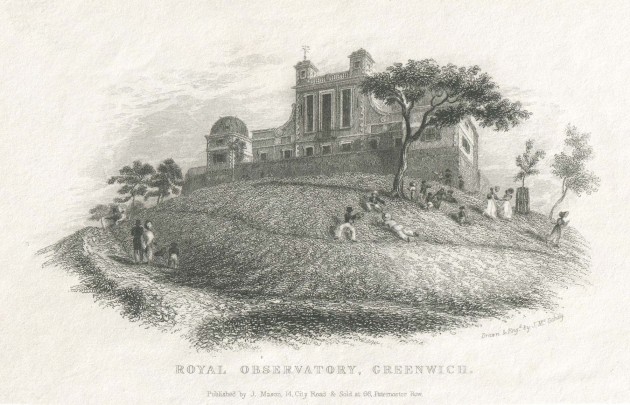
The Observatory from the north-west. Drawn and engraved by J. Mc.Gahey. From The youth's instructor and guardian for 1831
Although it has been stated by Maunder (The Royal Observatory Greenwich, 1900) and subsequently repeated by Forbes (Greenwich Observatory, 1975) and Murray (ODNB, 2005), that Pond was absent from the Observatory for long periods during his final years, none of the authors have supported this claim with any evidence. More on this below.
Westbury, the Westbury Circle and election as a fellow of the Royal Society
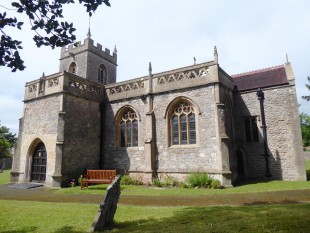
The church of St Lawrence at Westbury (now known as Westbury-sub-Mendip). Dating from the 12th century, it underwent a major restoration in 1887 when the church tower was rebuilt. Located about four miles to the north-west of Wells, the village sits on the southern slopes of the Mendip Hills. Photo: August 2020
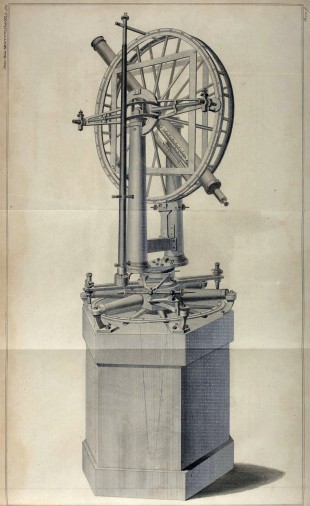
The Westbury Circle. Engraved by J Basire. Plate XX from Philosophical Transactions of the Royal Society of London, Vol. 96. Digitised by Internet Archive from the library of the Natural History Museum, London
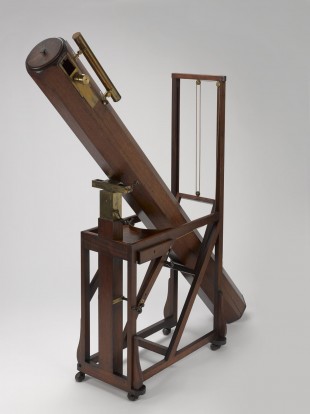
The 7-foot reflector made by Herschel for Sir William Watson. The one he made for Pond would have been similar. © The Board of Trustees of the Science Museum. Reproduced under the terms of a Creative Commons Attribution-NonCommercial-ShareAlike 4.0 Licence (CC BY-NC-SA 4.0), details below
The Rent Book kept by Knyfton and preserved in the Somerset Archives shows that Pond leased the ‘messuage or dwelling house late Bendle and Collier’s, reserving the nut tree, at £10 per year’ from Michaelmas (29 September) 1799 until Lady Day (25 March) 1803. Lane suggests that as well as the house, the rent may have included the adjacent field. This seems highly likely as it is probably where Pond set up his private observatory – the garden surrounding the house being too enclosed. It probably took the form of a temporary wooden building with shuttered openings in the roof and walls.
The main instrument it housed was the telescope now known as the Westbury Circle – an Altazimuth Circle that had been made specially for Pond by ‘Mr. Troughton‘ (Pond does not specify which, but there seems to be definitive evidence that it was Edward rather than John (see below)). It was mounted on a substantial stone pier that would have been bedded onto a firm foundation. Pond would also have needed an astronomical regulator attached to an independent stone or brick pier. No details are known, but as the Westbury Circle ended up initially at the Hakin Observatory in Wales and then at the Garnet Hill Observatory in Glasgow (see below), Pond’s regulator may have ended up in one of these observatories as well. Howse (1986), records that Garnet Hill had two regulators, one by Arnold and the other by Hardy.
Pond also owned a 7-foot reflecting telescope that was made for him by William Herschel. Most of what is known about it derives from six letters that he wrote to Herschel between 1795 and 1799 that are preserved with two others in the archives of the Royal Astronomical Society (RAS MSS Herschel W.13.P.56-63). Ordered from Herschel in the summer of 1794, Pond moved abroad before it was delivered. In August 1795, Pond asked to have it delivered to him at Lisbon (Portugal) where he had been residing for the past eight months. After a year‘s delay stuck in a warehouse in Plymouth, the telescope arrived in December 1796. It seems to have been ordered primarily because Pond was interested in observing double stars. The telescope returned from Lisbon some time after Pond himself had returned to England, reaching him in August 1799 with both the rackwork and the finder missing. Writing from Wells on 22 August, Pond asked Herschel if he would send replacements. On 22 October he was able to report that the telescope was ‘ in excellent order‘. According to Spaight, (2004), it cost £31.10s. A list of those to whom Herschel supplied telescopes included by Dreyer in The scientific papers of Sir William Herschel (Volume 1), would suggest that Spaight is incorrect in regard to the cost as it appears to state that Pond was charged £105 for the instrument. All the payments made to Herschel, including an order for additional eyepieces and the replacement parts were handled by Tennant on Pond‘s behalf. As well as the Westbury Circle and the 7-foot reflecting telescope, Pond may also have owned a Repeating Circle by Troughton, which it was claimed in 1813, was about to be acquired for a new observatory in the grounds of the home of John Fuller at Brightling in Sussex (The Monthly Magazine, Vol 36, 1813).
Although it is not known when Pond ordered the Westbury Circle, it is likely to have cost him between 200 and 300 guineas. After commissioning the instrument, which probably took several months, Pond used it to make a series of repeated observations of 31 of the brightest stars. Taken over a period of about 14 months, his observations were published in 1806. The first was made on 31 October 1800 and the last on 19 December 1801. No observations are recorded as having been made during the months of May, August, September and October 1801, with only a handful having been made in June and July, suggesting that either Pond was away from Westbury or that he was a creature of habit who did not like to go to bed too late (or both).
Although the telescope could be pointed at any part of the sky, all the published observations were taken with it aligned to the meridian (i.e. pointing in a north-south direction). The alignment would have been carried out in the standard way from observations of the circumpolar stars. These stars are always present in the sky and transit (pass over) the meridian twice each (sidereal) day as the Earth spins on its axis. When the telescope was correctly aligned, the measured time between successive transits of a given star would have been constant. Once aligned, the telescope would have been locked in position in azimuth. It was then used by Pond to measure the zenith distance of each star (the angular distance from the point vertically overhead). From this, he computed its North Polar Distance.
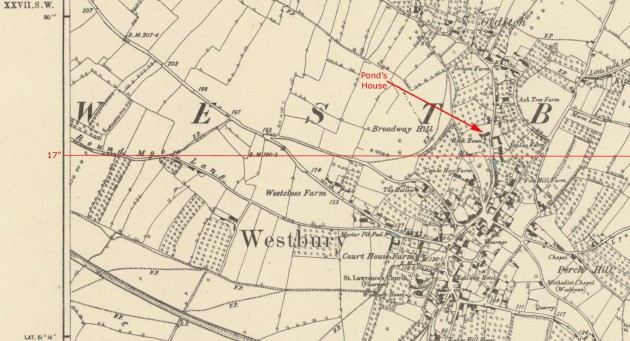
The published latitude of the Westbury Circle as determined by Pond, by astronomical means, is 51°14’17.0” N (51.238056° N). The red horizontal line represents the same latitude as determined through later surveys and would have differed slightly from that determined astronomically. When the map was published, the house where Pond had lived was known as Rock House. Adapted detail from the Ordnance Survey 6-inch to the mile map (Sheet 27. S.E.), surveyed and published in 1884. Reproduced with the permission of the National Library of Scotland under a Creative Commons Attribution 4.0 International (CC BY 4.0) licence, see below
After careful analysis and comparison of his own measurements with those made around the same time at Greenwich, Armagh and Palermo, Pond produced a paper that was read at the Royal Society on 26 June 1806. As Pond was not himself a fellow of the Society, the paper was communicated on his behalf by Tennant (who had been a fellow since 1785):
On the declinations of some of the principal fixed stars: with a description of an astronomical circle, and some remarks on the construction of circular instruments. John Pond, Phil. Trans. R. Soc.96420–454 (1806)
The significance of Pond’s paper was that it provided unequivocal evidence that by the nature of their construction, observations made with a circle were likely to be superior to those made with a mural quadrant. Pond’s findings had immediate implications for the Observatory at Greenwich as they also demonstrated a marked deterioration in the accuracy of Bradley’s 8-foot Mural Quadrant which, although over 50 years old, was still in daily use as one of the fundamental instruments.
Taking what Pond said at the start of his paper at face value, it would appear that he had no particular observing programme in mind when he placed the order for the Westbury Circle and that he only decided on a programme to measure the declinations of the principal fixed stars once the instrument ‘came into’ his possession. The decision to compare his measurements with those taken elsewhere comes across as an afterthought that occurred to him only once he had completed his observing programme. A sceptic might think otherwise. Given that Pond’s obituary says that he made the assertion at the age of 14 about ‘an appearance of discrepancy in the Greenwich Observations, implying some imperfection in the instruments’, it is quite possible that he ordered the Westbury Circle solely with the intention of putting this assertion to the test ... but choose to state otherwise in order to avoid ruffling any feathers.
Whatever Pond’s motives, Maskelyne wasted no time in taking action. At the Visitation held at Greenwich on 11 July (just two weeks after Pond’s paper had been read), he raised the matter of acquiring a divided circle with the Visitors (RGO6/22/52 & RS MS600/75). Unlike his unsuccessful attempt to acquire one in 1792 (RGO6/22/28), this time he was successful. Unfortunately for him though, the new Mural Circle ordered from Troughton in 1807, wasn’t completed in his lifetime. The scale divisions were engraved in two bands set into the rim of the circle: one of platinum, the other of four parts gold and one part palladium – the metals having been supplied by a company set up in 1800 by Tennant in partnership with William Hyde Wollaston, who as well as being a chemist, was one of Pond’s College friends from Cambridge. One of Pond’s earliest uses of the new instrument was to fully investigate the ‘derangement’ of the Mural Quadrant. Click here to view his comments on this together with the published results.
A second consequence of Pond’s paper was his election as a fellow of the Royal Society on 26 February 1807. At the head of his list of proposers was William Herschel. Amongst the nine others were: Nevil Maskelyne, Humphry Davy (who had visited Pond at Westbury, in 1800), Davies Giddy and Smithson Tennant. Click here to view the nomination paper. As well as being elected a fellow of the Royal Society in 1807, Pond also got married at St Martin-in-the-Fields, Westminster on 16 April.
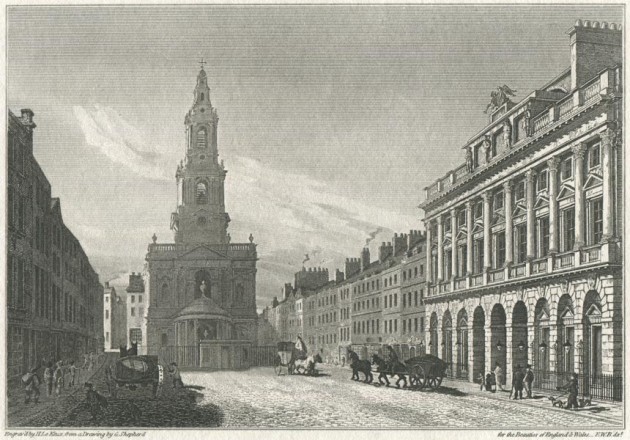
From 1780–1856, the Royal Society held its meetings in the north wing of Somerset House (right). View in the Strand, engraved by H. Le Keux from a drawing by G Shepherd and published for the Beauties of England & Wales by Vernor, Hood & Sharpe, 1 July 1810
Soon after he became a fellow, Pond was asked to attend a committee of the Society on 30 April 1807 to consider the plans for the new circle at Greenwich (RGO6/22/54). He was also one of 12 fellows of the Society who were not members of Council who were invited to attend the Observatory as a Visitor on 10 July 1807 (RGO6/22/56). Although Pond was also invited to all the later Visitations, the only ones he attended prior to his appointment as Astronomer Royal were those in 1807 and 1810 (RGO6/22). We also know that by 1809 at the very latest, Pond had disposed of the Westbury Circle. To have disposed of such a fine instrument, rather begs the question as to what Pond thought the future held for him at the time that he did so.
Maskelyne’s Memorandum Books (formerly: GB190/1390/2/K, now RGO218/2/12) reveal that he invited Pond to dinner at the Royal Observatory on at least seven occasions. It would appear that Pond was also commissioned to work on the preparation of Maskelyne’s observations for the press as at a meeting of Council held on 28 March 1808, Maskelyne presented his bill for £5.5.0. for payment (RGO6/22/57). We also know that he was at the Observatory on 11 January 1811, as this is the date of his earliest recorded observation there (Howse: Nevil Maskelyne, 1989).
| Date | Maskelyne’s dinner guests |
||
| 1806 | Aug 8 | Baron Maseres, Colonel Etherington, Mr Wilson, Mr Howell, Mr Wright, Mr Pond | |
| 1806 | Aug 13 | Lady Booth (his sister-in-law), Miss Haycock, Miss Tomer [?] General Davies, Mrs Davies, Mr Teller, Colonel Campbell, Dr Burney, Mr J Wright, Mr Pond | |
| 1806 | Dec 9 | Colonel Mudge (Ordnance Trigonometrical Survey), Mr Dawes, Mr Pond | |
| 1807 | May 19 | Dr & Miss Wilson, Mrs Herschel & son, Miss Baldwin, Mr & Mrs Pond | |
| 1807 | Jul 17 | Mr Pond, Captain Horsbury, Mr Wright | |
| 1808 | Sep 12 | Lady Booth, Mrs Hovel [?], Mr & Mrs Pond, Dr Wollaston, Mr Glenie, Mr Fellows | |
| 1809 | Aug 29 | Colonel Campbell, General Davis, Dr Burney, Mr & Mrs Pond (haunch of venision) |
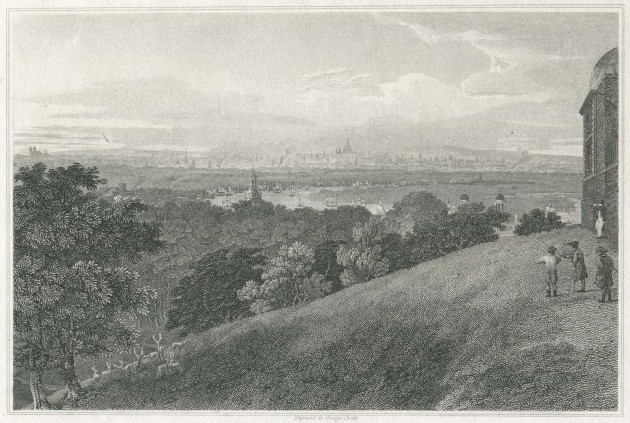
In this contemporary view from outside the north-west corner of the Observatory, St Paul's is in on the horizon in the centre and Westminster Abbey is on the extreme left. Note the large number of sailing ships moored on the Thames and in the London Docks. View of London (from Greenwich), engraved by George Cooke and published by Longman, Hurst, Rees & Orme, 1 April 1809.
Stephen Lee, who had been invited to all the Visitations since becoming a fellow in 1798, became a member of Council in 1810, but had to resign a few months later on his appointment as the Society’s Clerk, Housekeeper and Librarian. Since Pond attended the Council meeting held on 13 December 1810, it would appear that he was brought onto Council as Lee’s replacement (RGO6/22/62). According to Charles Babbage, Pond was still a member of Council in 1827 and appears to have remained so until at least 1830. He was also one of the Society’s six Vice-President in 1830–31. Altogether, Pond served under five different Presidents. Their periods of office were as follows:
1778–1820 Sir Joseph Banks
1820–1820 William Hyde Wollaston
1820–1827 Sir Humphry Davy
1827–1830 Davies Gilbert (formerly Giddy)
1830–1838 HRH The Duke of Sussex
The formation of the (Royal) Astronomical Society in 1820 did not go down well with Banks who thought it would diminish the Influence of the Royal Society. At its second meeting, the Duke of Somerset was elected President and Pond elected as one of four vice-presidents. Banks however managed to induce the Duke to decline the Presidency. He was also not happy about Pond. According to the History of the Royal Astronomical Society (1923), Baily (one of the key founding members) wrote:
‘A similar attack was made by Sir Jos Banks on the Astronomer Royal, who, if report be true, made a very spirited reply.’
1802–1806, the missing years
One of the many mysteries surrounding Pond is where he spent his time after taking his last published Observation at Westbury in December 1801 and his definitive appearance in London in November 1806 when he signed his nomination paper for fellowship of the Royal Society and was living in Henrietta Street, Covent Garden. Although he retained the lease on the house in Westbury until March 1803, it is not known if he remained there or moved elsewhere once his observing programme with the Westbury Circle was completed. Although the fate of his 7-foot reflector is unknown, the Westbury Circle, as mentioned above, was later sold and moved to Glasgow in the 1810s (see below).
Writings and lectures before becoming and after becoming Astronomer Royal
‘by nature a retiring man, he unwillingly appeared in print, and when called upon to take up his pen, was as brief as the nature of his subject would allow; though neatness and perspicuity characterise whatever he produced.’
(Obituary, Morning Chronicle, 1836)
In 1809, Pond translated into English and then published Laplace’sSystème du monde. He also translated a substantial work by La Croix that was used by John Pinkerton in 1811 as the Introduction to the new editions of his Modern Geography in place of one by Samuel Vince. He also contributed ‘many scientific articles’ to Rees’ Cyclopaedia which, according to an article about the Cyclopaedia published in the September 1820 edition of The Philosophical Magazine and Journal, included those on: ‘Algebra, Analysis, Astronomy, Degree, Diophantine, Force, &c’. In the late 1820s, Pond also contributed to Dr Lardner’s Cabinet Cyclopaedia. A partial list of contributors can be seen here. Two letters relating to Pond’s contributions are held at the Welcome Library (MS.5490).
In 1809, Pond gave a series of 10 lectures on Physical Astronomy and its applications as part of a programme of public lectures at the recently founded Royal Institution. This was followed by a further 10 lectures on Popular astronomy in 1810 (Hsiang-Fu Huang, PhD, 2015).
As Astronomer Royal, Pond’s main output was the published volumes of Greenwich Observations and papers published in the journals of the Royal Society and (Royal) Astronomical Society (more on these below).
Appointment as Astronomer Royal and the wording of the Royal Warrants
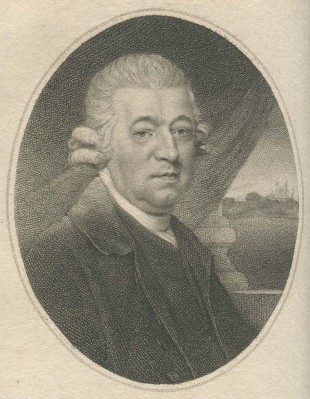
Nevil Maskelyne. Engraved from a pastel drawing by John Russell and published by J. Asperne, 1 March 1804
‘Mr. Pond’s appointment as Astronomer Royal arose out of his having, while residing in the country, and but little known, communicated to Dr. Maskelyne – who was a stranger to him – several corrections of errors in the Greenwich Observations, and in the Nautical Almanac. These induced the latter within a very few months of his decease, to mention Mr. Pond to the council of the Royal Society, as the fittest man to succeed him. An opinion from such a quarter necessarily had great weight; and having been strongly supported by Mr. Pond’s fellow-collegian, the late highly esteemed philosopher, Dr. Wollaston, the former was, on the death of Dr. Maskelyne, appointed to the vacant office, on the recommendation of Sir Joseph Banks, to whose discernment and impartiality, the government of that period very wisely entrusted its scientific patronage.’ (Obituary, Morning Chronicle, 1836)
The wording of the Royal Warrant by which Pond was appointed harked back to Flamsteed’s time. Flamsteed was appointed as ‘Our Astronomical Observator’ and so too, were all the Astronomers Royal up to and including Airy.
The exact date of Pond’s appointment is uncertain as there is no known copy of the Warrant. However, the Navy Estimates for 1812 (ADM181/20) show that he was paid from 18 February 1811 (nine days after Maskelyne had died). The official announcement however wasn't made until five days later, when The London Gazette (Issue 16457), which covered the period 19–23 February, carried the following announcement on p.336:
‘Whitehall February 23, 1811.
His Royal Highness the Prince Regent has been pleased, in the Name and on Behalf of his Majesty, to appoint John Pond; Esq; to be Astronomical Observator in the Observatory at Greenwich, in the Room of Nivil [Nevil] Maskelyne; Esq; deceased.’
Unfortunately, The London Gazette is not a reliable guide as to when the Warrant might have been issued as is illustrated by the announcements relating to Airy and Maskelyne. The announcement of Airy’s appointment is dated 11 August 1835, the same date that his Warrant was issued. In the case of Maskelyne however, the Warrant is dated 8 February 1765, but the announcement in the Gazette is dated 26 February. In light of this, the most likely date of Pond’s appointment seems to be 18 February 1811, the date from which his salary was paid.
Forbes (1975), without giving references, states that ‘Pond took up his appointment as sixth Astronomer Royal on 13 April 1811’. The date is incorrect as the Warrant would have contained the words ‘it is our Will and Pleasure that you forthwith take possession of our said Observatory’. In other words, Pond would have taken up his appointment on the date that the Warrant was signed. Indeed, the confirmed minutes of the meeting of the Board of Longitude held on 7 March list him as being present in his capacity as Astronomer Royal. The date when he took up residence at the Observatory is an entirely different matter. As can be seen from the letter below, Maskelyne’s widow, Margaret, seemed to be in no hurry to leave the Observatory.
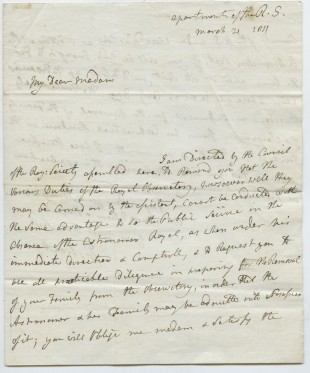
Letter from Joseph Banks to Maskelyne's widow Margaret (dated 21 March 1811 and sent following a resolution passed by the Council of the Royal Society earlier that day) politely asking her to hurry up and move out of the Observatory so that Pond can move in.
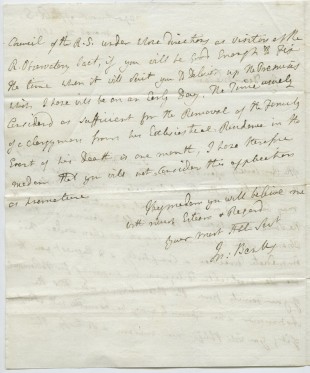
Collection of papers relating to Nevil Maskelyne (NMM/REG09-000037). Reproduced under the terms of a Creative Commons Attribution-Non-Commercial 3.0 Unported License (CC BY-NC 3.0) courtesy of Cambridge Digital Library (see below)
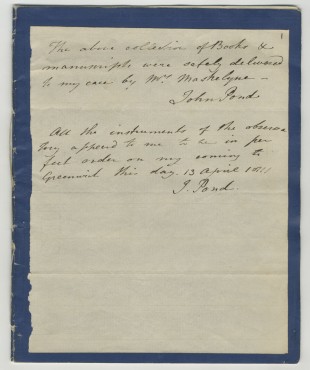
Collection of papers relating to Nevil Maskelyne. REG09-000037. Reproduced under the terms of a Creative Commons Attribution-Non-Commercial 3.0 Unported License (CC BY-NC 3.0) courtesy of Cambridge Digital Library (see below)
Pond’s appointment in 1811 was as Astronomical Observator to George III. Following his death on 29 January 1820, Pond’s appointment would have technically lapsed, as would that of the Board of Visitors. We know that a that a new Warrant reappointing the Board was issued on 19 May 1820 (RS MS/371/65), but we don't know for sure if one was also issued to reappoint Pond. However, given that the President of the Royal Society was sent not just the Warrant reappointing the Board, but also a copy of the ‘ Regulations for the Astronomical Observator at Greenwich’ carrying the same date, it seems likely that Pond also received a new Warrant at this time (RS MS371/64). Unfortunately, it has not yet proved possible to verify this through the online version of The London Gazette as the relevant volume is missing from the archive.
When Geroge IV died on 26 June 1830, Pond’s appointment once again would have technically lapsed. It fell upon his successor, King William IV, to either reappoint Pond or to take the unprecedented step of appointing someone else. The former path was adopted. The London Gazette (Issue 18715 p.1689) carried the following announcement:
‘Whitehall August 6, 1830
The King has been pleased to appoint John Pond. Esq. to be Astronomical Observator in the Observatory at Greenwich.’
No copy of the accompanying Warrant has been discovered. The Board of Visitors was reconstituted at the same time, the Warrant being issued on 9 September 1830 (RS MS/371/68).
The Board of Visitors
In much the same way that a school has a Board of Governors, the Royal Observatory had a Board of Visitors, whose function was similar. Whilst the Astronomer Royal was responsible for the day-to-day running and management of the Observatory, it fell to the Visitors to ensure that it operated within the constraints of the Royal Warrants and to lobby on its behalf when needed.
When the Observatory was founded, no thought was given as to how it should be overseen. The Board of Visitors did not come into being for a further 35 years. Set up by Royal Warrant on 12 December 1710, the Board initially consisted of the President of the Royal Society (at that time Newton), and in his absence the Vice-President, ‘together with such others as the Council of our said Royal Society shall think fit to join with you’.
In 1830, when a new Warrant was required on the accession of William IV, the composition was changed to incorporate members of the recently formed Royal Astronomical Society. For the future, it was to consist of the Presidents of the two societies, any former presidents, five further fellows from each, together with (as ex officio members), the Savilian Professor of Astronomy from Oxford and the Plumian Professor of Astronomy from Cambridge.
Owing to the fact that, until 1830, the composition of the Board was effectively that of the Royal Society Council, its business (apart from Visitations) was conducted as part of general Council business, the minutes of which are preserved in the Society’s Minute Books. Extracts from the Minute Books together with minutes of some of the Visitations from 1763–1815 are preserved in MS600 at the Royal Society. Other important documents relating to the Observatory are held at the Royal Society in MS371, MS372 and DM5. They contain a wealth of information including several inventories. Their organisation is somewhat chaotic.
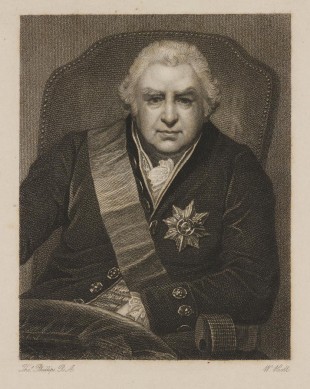
Sir Joseph Banks. Engraving by W. Holl from the 1815 oil painting by Thomas Phillips. © The Board of Trustees of the Science Museum. Reproduced under the terms of a Creative Commons Attribution-NonCommercial-ShareAlike 4.0 Licence (CC BY-NC-SA 4.0), details below
In 1852, Airy reported to the Visitors that he had borrowed from the Royal Society a manuscript book that appeared to be ‘an official copy of the minutes of the Board of Visitors from their institution in 1710 to 1784’. The receipt for this is preserved in MS372/159. Over the following decade, he made exhaustive enquires as to the whereabouts of the volume(s) of minutes for the years 1784 to 1830, before coming to the conclusion in 1863/4 that separate volumes for those years had never existed. Airy reported this to the Visitors along with the fact that he had arranged to have the relevant extracts copied from the Council’s Minute Books.
Preserved in the RGO archives at Cambridge are two volumes containing Airy’s copies of the minutes for the years 1710 to 1830. RGO6/21 covers the years 1710 to 1784 (with a couple of later items). RGO6/22 covers the years 1784 to 1830. There is an assumption that RGO6/21 is a copy of the material that Airy borrowed – a transcript of Airy’s receipt (dated 2 May 1966) having been pasted on its inside cover. Still in Airy’s possession in 1859, the original volume can no longer be located. Between them, RGO6/21 and RGO6/22 include much material not present in MS371, 372, 600 and DM5. Despite the fact that they contain additional material, they are not however a complete record of the Board’s business as many of the minutes of the Visitations are missing (as they are from MS371, 372, 600 and DM5). Whilst decisions were made in good faith as to which entries in the Council’s Minute Books were relevant to the Visitors, it is likely that if the task of trawling them were to be repeated today, additional material would be deemed to be relevant.
Minutes of the Board for the years 1831 to 1964 were much better organised and are held at the National Archives in Kew in two volumes (ADM190/4 and ADM190/6).
Click here to read more about the Board of Visitors
The Board of Longitude
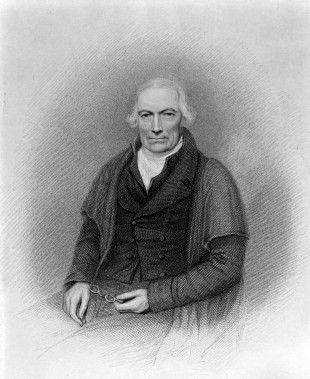
Samuel Vince (1749–1821), Plumian Professor of Astronomy and Commissioner of the Board of Longitude from 1796 until 1821. Engraved by R. Cooper, drawn by T. Wageman, published by T. Clay, London 1821. Whilst an undergraduate at Cambridge, Pond was instrumental in persuading Vince to give a course of lectures on practical astronomy. Pond's private tutor at Cambridge, William Lax, was also a Commissioner having been appointed as Lowndean Professor in 1795. He served until the Board was dissolved in 1828. Image cropped and reproduced under the terms of a Creative Commons Attribution 4.0 International (CC BY 4.0) licence courtesy of the University of Cambridge, Institute of Astronomy Library (see below)
Prior to 1818, although none of the Commissioners received a salary, expenses of £25 a meeting were paid to the Astronomer Royal and the five Commissioners who held professorships at Oxford and Cambridge. After 1818, these allowances continued, but in addition, a salary of £100 a year was paid to three ‘Resident Commissioners’ whose posts were created as a result of the Act. An analysis of the records shows that prior to 1818, the most consistent attendees at meetings of the Board were Pond and the five Oxford and Cambridge professors.
When Pond was appointed, the role of the Commissioners was to publish the Nautical Almanac and to consider proposals sent to them for improving navigation for which they were empowered to make financial rewards. At his first meeting, Pond
‘offered his services towards carrying on the business of the Board’s Publication of the Nautical Almanac in the same manner as his predecessor had done if it were the wish of the Board.’
And it was resolved:
‘That the Astronomer Royal be requested to conduct the business of the Nautical Almanac by superintending & paying the Computers and Comparer in the manner that has been heretofore done & that the Secretary be requested to allow him access to the Minutes of the Board in order that he may collect from them the mode in which that business has been hitherto carried on.’
The 1818 Longitude Act altered both the remit and composition of the Board. Clause xxi of the Act provided for
‘some Person of competent Skill and Ability shall be nominated and appointed by the Lord High Admiral or Commissioners of the Admiralty to be Secretary to the said Board of Commissioners, and for superintending, under the Directions of the Board in general, and the Astronomer Royal in particular, the due and correct Publication of the Nautical Almanack, and for taking care of and regulating such Timekeepers as may be intrusted to his care by the Lord High Admiral or Commissioners of the Admiralty.’
By Order of Council dated 27 May 1818, the salary of the Secretary was fixed at £500 a year (RGO14/7/251)
However, Clause xxii went on to add that
‘if it shall so happen that a Person shall not be found competent to execute the Three several Duties of Secretary to the said Board, and of superintending the Publication of the Nautical Almanac, and the Care and Regulation of Timekeepers, it shall be lawful to the said Commissioners to propose to His Majesty in Council to divide the said Duties, and assign them to several Persons, and to apportion to each Person such Part of the Salary established for the performance of the united Duties as may seem to them fit and proportionate to the several Duty or Duties to be performed by such Person.’
In the event, a single person could not be found to fulfil all the duties. At a meeting of Council at the Court at Carlton House held on 31 October 1818 a memorial dated 27 October 1818 was read from the Right Honourable the Lords Commissioners of the Admiralty, in which it was proposed to divided the post into three with the following salaries (RGO14/7/253)
- Secretary (£100)
- Superintendent of the Nautical Almanac (£300)
- Superintendent of Chronometers (£100)
Approval was given and Thomas Young was immediately appointed as both Secretary and Superintendent of the Nautical Almanac. By comparison with Maskelyne and Pond, who had superintended the Almanac for nothing, Young was exceedingly well paid. Thomas Hurd, who had lost his position as Secretary with the passing of the 1818 Act, was appointed Superintendent of Chronometers in 1819. In July 1821 however, the post was transferred to Pond (more on this below).
Bearing in mind that Pond was not paid a salary by the Board, an awful lot of its time consuming work fell to him – just as it had to his predecessor Nevil Maskelyne. This included carrying out investigations at the Observatory into mechanical objects submitted to the Board such as regulators, chronometers and other equipment.
Pond was also one of the original members of the Royal Society’s Pendulum Committee which was set up in 1816 and in 1828 and 1830 cooperated with Edward Sabine who conducted pendulum experiments at the Observatory. He also cooperated with Captain Henry Kater in various longitude surveys that the Society organised.
A more in depth look at Pond’s role in the production of the Nautical Almanac can be found towards the bottom of the page.
The Analytical Society and the influence of John Herschel, Charles Babbage and George Peacock
In 1812, just a year after Pond became Astronomer Royal, a group of Cambridge Students formed the short-lived Analytical Society which became the precursor to a movement to reform mathematics at Cambridge. Consisting of 16 known members, it had John Herschel as its President and Charles Babbage and George Peacock as its leading members. All three not only sought reform of mathematics at Cambridge, but also sought the reform of the Royal Society – Herschel was elected a fellow of the Royal Society on 27 May 1813, Babbage on 14 March 1816 and Peacock on 29 Jan 1818. Herschel and Babbage were founding fellows of the (Royal) Astronomical Society, as was Pond, whilst Peacock became a fellow just a few weeks later. Although Pond had known Herschel since at least 1807 when both were dinner guests of Maskelyne at the Observatory, their paths began to cross on a professional basis when Herschel was appointed one of the ‘Resident Commissioners’ of the Board of Longitude in June 1821.
Herschel, Babbage and Peacock all became Visitors to the Royal Observatory when the Board was reformed in 1830 – Peacock being a representative of the Royal Society and Herschel and Babbage being representatives of the (Royal) Astronomical Society. Babbage and Herschel were also instrumental in founding the British Association for the Advancement of Science in 1831, with Herschel and Peacock both becoming President in the 1840s. Ashworth writes that Herschel, Babbage and Peacock also played important roles in establishing the Cambridge Philosophical Society in 1819.
Directly or indirectly, Herschel, Babbage and Peacock all exerted their influence on the Observatory.
Analytical Society. William J Ashworth. ODNB (2008)
Analytical Society. Wikipedia
A switch in funding and a significant increase in responsibility
Originally funded though the Board of Ordnance, the Observatory began to receive a top-up from the Civil List in 1752. This joint funding continued until 1811 when the Board of Admiralty started to make a contribution as well. As a result, between 1811 and 1818, the Observatory was funded by no less than three different Government Departments.
In 1818 the Board of Ordnance’s responsibilities transferred to the Board of Admiralty with payments from the Civil List continuing as before. In 1830 payments from the Civil List were ended, with responsibility for making up the subsequent shortfall being transferred to the Admiralty which became the Observatory’s sole source of government funds.
The Admiralty first became directly involved in the Observatory’s financial affairs when John Pond was appointed Astronomer Royal in February 1811. Pond’s predecessor Maskelyne had earlier asked for a rise in salary, but been declined in part because of his considerable personal wealth. With Pond’s appointment, the salary of the Astronomer Royal was raised from £350 to £600 a year. Maskelyne’s salary of £350 had been made up of £100 from the Board of Ordnance and £250 from the Civil List. These payments were continued for Pond, with the top-up coming from the Admiralty – the extra money being initially allocated via the 1812 Navy Vote with a backdated amount for the year 1811. A full breakdown of the salary and allowances paid to Pond is given in the next section.
In 1811 an extra assistant was taken on (ADM/BP/40B/48 also referenced as ADM359/40B/48 and held at the National Maritime Museum. See also RS MS600/69-72). This was Pond’s ward John Henry Belville. His salary appears to have been paid either by Pond himself, or possibly the Ordnance, until 19 March 1814 when he was put on the establishment list as Second Assistant with his salary being paid by the Admiralty (ADM181/24). Meanwhile the First Assistant continued to have his salary paid by the Board of Ordnance (£26) and the Civil List (£173. 16s.).
There was a great deal of confusion amongst those in authority in the early days of Pond’s tenure, as to how the salaries were being paid. Even the Board of Visitors who had oversight of the running of the Observatory and who scrutinised bills before they were sent to the Ordnance for payment didn’t have a proper picture of what amounts were being paid and by whom. It wasn’t until 1814 for example that Joseph Banks, President of the Royal Society and chairman of the Board of Visitors since 1778, understood how things worked (and what he understood seems only an approximation to the truth) (RS MS372/157). An explanation of how Pond’s salary was made up (also incorrect) was later given to MPs in the House of Commons in April 1815.
The First Assistant was awarded a salary rise in 1816, the additional salary being paid by the Admiralty. Recognising the potential difficulties of the general management of the Observatory being shared between three government departments (the Treasury (who administered the Civil List), the Admiralty and the Board of Ordnance), the Observatory’s Board of Visitors recommended in November 1816 that the Lords Commissioners of the Admiralty should become responsible for the management of the Observatory as in their opinion ‘it would save much trouble to the Public Offices … and at the same time be of essential advantage to the observatory and to the interest of Astronomical Science’ (RGO6/1/41).
On 27 June 1818, a letter was sent from the Treasury to the Admiralty, saying that the whole of the expenses of the establishment with the exception of the sum of £420 paid from the civil list towards the salaries (of the Astronomer Royal and First Assistant) were to be transferred from the Board of Ordinance to the Admiralty as soon as was practicable. Steps to put this in place were completed by that December (RGO6/1/49&50).
On the accession of William IV in 1830, the link between the Sovereign and the cost of civil government was removed when the sum voted by parliament for the Civil List was restricted to the expenses of the Royal Household. The Navy Estimates show that the Civil List responsibility for paying part of the salaries of the AR and First Assistant was transferred to the Admiralty on 12 January 1831 (ADM181/40).
Click here to read more about the different source of funding at the Observatory
Pond’s salary and allowances as Astronomer Royal
When Maskelyne died, he was receiving a consolidated salary of £350 a year plus expenses of £15 (increased to £25 at the end of 1806 (RGO14/2/5) for each meeting of the Board of Longitude he attended. Pond’s salary on his appointment in 1811 was £600 a year. He was also paid various allowances at different times. Initially, the £600 came from three different sources. In 1811, he received the same salary of £100 from the Board of Ordnance plus a pension of £250 a year that Maskelyne had received, but his salary was augmented by the Admiralty to the tune of £292.10s a year, in order to bring his total emolument to £600 a year – the £250 pension having being reduced in valued to only £207.10s a year because of fees and taxes. Responsibility for the Board of Ordnance’s contribution to the Astronomer Royal’s salary was transferred from the Board of Ordnance to the Admiralty in 1820, the amount contributed by the Admiralty rising from £292.10s to £376.8s a year and staying at that level until 1830. How the figure of £376.8s was arrived at is not clear – the difference being only £83.18s rather than the £100 that had been previously paid by the Ordinance. The shortfall may be a result of deductions that had previously been made from the £100 for fees and taxes. By 1831, the whole £600 was being shouldered by the Admiralty. The Admiralty were also responsible for funding the Cape Observatory (established 1820), and it is interesting to note that at this point in time, The Astronomer at the Cape was paid at the same basic rate as the Astronomer Royal. Pond’s income was enhanced as he was also paid expenses as a commissioner of the Board of Longitude until it was dissolved in 1828. There were normally three meetings of the Board a year prior to 1818 and four after that date (See RGO14/2/5 re: these expenses).
In 1821, Pond was required to take on the role of Superintendent of Chronometers for which he was paid a further £100 a year. He was also paid an allowance for coals and candles (probably from the date he was appointed, but certainly by 1815 and worth £200 a year in 1835), from which he was also expected to provide for the non-residential as well as the residential parts of the Observatory.
Airy was first sounded out about his willingness to take on the office of Astronomer Royal in May 1834. He provisionally accepted the appointment on 10 October 1834, accepting it formally on 17 June 1835. He was paid at a new consolidated rate of £800 a year, with no separate allowance for coals or as Superintendent of Chronometers.
Pond’s Assistants
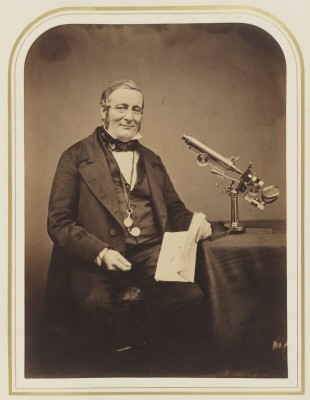
Frederick Walter Simms by Maull & Polyblank. Albumen print, arched top, 1855. Simms is the only one of Pond’s assistants of whom there is a known portrait. © National Portrait Gallery, London. Reproduced under a Creative Commons Attribution-NonCommercial-NoDerivs 3.0 Unported (CC BY-NC-ND 3.0) licence (see below)
After the Admiralty took over responsibility for the Observatory from the Board of Ordnance in 1818, the extra work associated with a new requirement to test and rate chronometers, the introduction of a second mural circle (which was used simultaneously with the first), together with pressure for observing to take place during more hours of the day, lead to an increase in the number of assistants to six – two additional second assistants being appointed in 1822, and two supernumerary computers in 1825. The later were referred to as ‘extra assistants’ and became established in about 1830. Three of Pond’s assistants came from Yorkshire: William Richardson, Thomas Ellis and William Rogerson, (the last two having been recommended by the first), with both Rogerson and Richardson, coming from the town of Pocklington.
As the longest serving Assistant, Taylor became, by default, the First or Chief Assistant. He was also sometimes referred to as the Deputy Astronomer Royal. As well as the number of assistants increasing under Pond from one to six, there was another important change. In the past, just a handful of assistants had served for five or more years. Under Pond, a new pattern emerged with many remaining at the Observatory for their entire working life.
Pond’s assistants were:
1807–1835 Thomas Taylor
1811–1856 John Henry Belville (Mr. Henry)
1822–1830 Thomas Glanville Taylor*
1822–1845 William Richardson
1825–1852 Thomas Ellis
1825–1853 William Rogerson
1830–1835 Frederick Walter Simms
* Son of Thomas Taylor & according to his obituary, initially appointed as a supernumerary in 1820.
The appointment of new Assistants was not without controversy. The type of Assistant to be appointed was a constant item of discussion by the Visitors over a period of four year period commencing in 1822. This topic is covered in detail in a section below.
See also:
Other staff at the Observatory
Little is known about other individuals that worked at the Observatory as there seems to be virtually no mention of them in Pond’s surviving papers (RGO5). Just one reference from 1835 has been found. Before he resigned, Pond provided Airy with a spreadsheet titled: Statement respecting the assistants at the Royal Observatory, at the bottom of which he added: ‘There is also a labourer employed to keep the premises clean, and to go on messages]’. Although Pond gave his salary as 18s. a week’, he failed to mention his name (RGO6/72/223&226).
The names of two of Pond’s employees however are recorded by Airy in his correspondence. They are Joseph Gale and Thomas Halley (also recorded as Hally). Gale appears to have joined the Observatory in about 1823 as a labourer, transferring to the post of night watchman in about 1830. Halley took over the job of labourer in 1830, dying in office on 29 June 1840 (RGO6/72/9–12), RGO6/72/109, RGO6/24). He was also sometimes referred to as the gardener. Gale lived rather longer, dying in office on 26 February 1853 (RGO6/72/9–12, RGO6/3/80 & RGO6/25/81).
Newspaper reports from January 1830 mention a John Garlick, who was described as a carpenter and also Thomas Halley, who on this ocassion was described as a gardener. Both were called to give evidence at an inquest held on 22 January 1830 into the death of John Eaglestone, the Park Keeper of Greenwich Park who had been killed in the garden of his cottage (now demolished) in the centre of the Park some 300 metres to the east of the Observatory. The inquest took place in the Octagon Room of Flamsteed House where Halley refused to be sworn in in the usual way, taking the oath in conformity with the Church of Scotland instead. After a short periond of deliberation, the Jury decided that he Eaglestone had ‘shot himself, being at the time in a state of temporary derangement.’
It seems probable that Garlick was employed as and when required rather than as a permanent employee. He was possibly related to Thomas Garlick (who was possibly his son) and although said to have been ‘one of the chief officials at the Royal Observatory’ (date unknown) seems more likely to have been a carpenter as well.
Housing the Assistants
Until the nineteenth century, there was normally only one assistant employed at any one time. It has always been believed that accommodation was provided for them on the Observatory site. Before the building in 1750 of ‘Bradley’s New Observatory’ (the western end of the current Meridian Building), this would have been in Flamsteed House. After that date, the accommodation provided was a small apartment on the top floor of the new building.
When Thomas Taylor was taken on by Maskelyne in 1807, he was married with two children. The accommodation at the Observatory was not sufficient for his family and it would appear that most of the Taylor household resided down the hill in Greenwich (UKHO LP39/209). Like the first assistant, the young Belville also resided at the Observatory. New apartment rooms completed in 1815 seem to have been initially shared between him and the First Assistant (RGO6/44/9). However a plan from 1831, indicates that by then, one of the rooms had been divided and that the whole suite of about 400 square feet was in use by Taylor (RGO6/45).
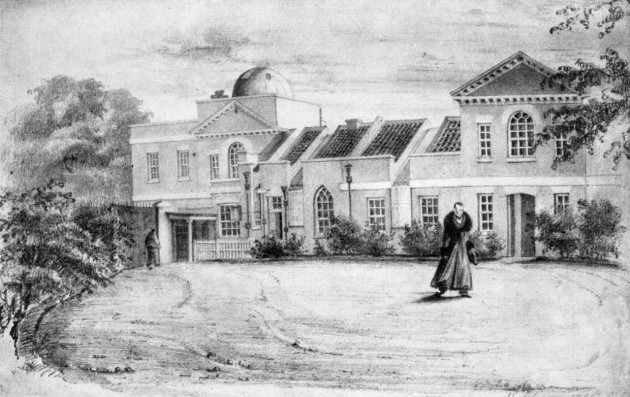
Although drawn in 1839, this is how the Meridian Building would have appeared from 1824 until 1849/50 when alterations were made to accommodate the Airy Transit Circle. The original assistant's apartment was located on the first floor on the right of the image. The new apartment completed in 1815 was on the ground floor at the left end of the building. From a drawing by Elizabeth Smith, 11 February 1839
In 1819 Belville married Sarah Dixon and started a family. The pattern of living in at the Observatory was broken in 1822 when Belville and his wife and children moved into nearby accommodation paid for by the Admiralty on the edge of the Park at 16 Park Row (now demolished). This move coincided with the doubling of the number of assistants from two to four. Of the two new assistants, William Richardson was accommodated alongside Belville at 16 Park Row and Thomas Taylor at the Observatory where his father was already in occupation (as First Assistant).
In 1825, plans were formed to build further accommodation at the Observatory and in 1826 procedures were put in place to enclose an additional part of Greenwich Park to build three houses (Work16/126). By 1827, Admiralty approval had been given for the work to proceed (ADM359/47B/60). But meanwhile, Belville had moved in 1825 into a house in the newly built Park Terrace at the western end of what is now Park Vista, with arrangements being made for the Admiralty to pay his rent, together with his bills for coals and candles and certain of the smaller expenses. The arrangement proved rather convenient and as a result, all plans for erecting new accommodation at the Observatory were abandoned. They were revived for a while in the 1830s, but were again abandoned (RGO6/44/25).
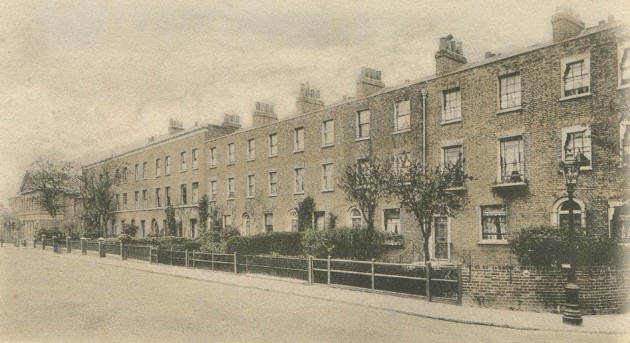
Park Terrace. Directly facing the north side of Greenwich Park, the terrace (now known as 1–12 Park Vista) was grade 2 listed in 1973. According to the listing, the six houses on the right are the earliest, with the six taller houses being added in about 1840. Belville moved into one of the smaller houses in 1825 and was possibly its first occupant. He remained there until 1833. Robert Main, who replaced Taylor as First Assistant in 1835 also lived in the terrace. He is recorded as living at number 4 in 1840, number 6 in 1849 and number 9 in 1852. From a postcard published by Perkins Son & Venimore and posted in 1905
Documentation detailing the provision of accommodation between1822 and 1835 is sketchy. Free housing seems to have been provided for the four assistants who were in post in 1822, but not for any later appointees. These arrangements were altered in 1836, when rather than paying the bills, the Admiralty was persuaded by Airy to alter them for his administrative convenience, and to pay a rent allowance instead.
More about staff housing can be found via the link below:
Changes in Greenwich while Pond was Astronomer Royal
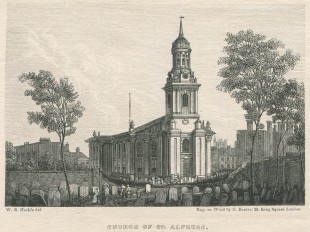
The parish church of St Alphage with the Observatory in the distance to it right. Engraved by George Baxter from a drawing by WB Mackie. From Henry Richardson's Greenwich: its history antiquities ... (1834)
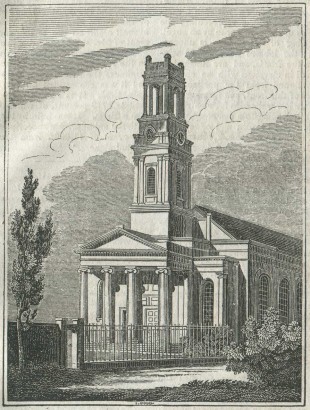
St Mary's Church, Greenwich (engraved by I. Dodd). Designed by George Basevi, the church was consecrated on 25 July 1825 and demolished in 1936. From the 18 September 1830 edition of The Mirror of Literature, Amusement, and Instruction
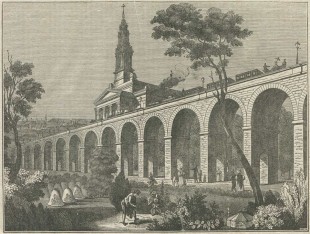
The London and Greenwich Railway, near Bermondsey New Church (Vasey Sc.). The line partially opened on 8 February 1836 (Spa Road to Deptford), and was fully open by 24 December 1838. From the 9 January 1836 edition of The Penny Magazine
Although the east side of the Park remained largely undeveloped, new roads to the west of the Park were gradually being developed. Writing in 1834, local publisher Henry Richardson, described the recent changes that had occurred up to that point in time:
‘The Town is well paved; lighted with gas (for which an Act of Parliament was obtained in 1823); and supplied with water by the Kent Water-works at Deptford. Numerous improvements have been made in the Town during the last few years, which have greatly altered its appearance: to show the rural character of the place to a very recent period, it may be mentioned that within the last twenty years there were posts and rails to divide the footpath from the road on Croom’s Hill, and that till the year 1813 there were trees standing in the very centre of the Town, nearly opposite the Church. London Street, the leading thoroughfare on entering the Town from the Metropolis, has also, within the last thirty years, assumed a much altered appearance in its change of character from a street of private residences to one of commerce, almost every house within it now presenting a shop frontage; whereas, at the period alluded to, the shops were very few in number, and almost wholly confined to that end of the street nearest the centre of the Town.
Among the most prominent improvements may he noticed the following. The erection of the Creek Bridge [1804] and Bridge Street, the passage over the Ravensbourne at that place having previously been by a ferry, the approach to which was through Lamb Lane. The erection of Vansittart Terrace and Bexley Place. The re-building of Queen Elizabeth’s College. The widening of Maize Hill. The erection of Park Street, Park Terrace, and Maize Hill Chapel on a piece of ground on which stood a mansion formerly in the occupation of Sir Gregory Page, Sir Walter James, and more recently of Dr. Crombie, and which was pulled down in 1822. The new cut called Hyde Vale, leading from Royal Hill to Conduit Vale. The alteration at the foot of Blackheath Hill where the roads to Blackheath, Lewisham, Deptford, and Greenwich meet, the previous abrupt turning of the road having occasioned numerous accidents. The improvement of Limekiln Lane now called South Street. The formation of Nelson Street, leading direct from Church Street to the Royal Hospital and Woolwich; and the continuation of this improvement in the formation of Trafalgar Road, by which the former circuitous route to Woolwich is avoided. The lower Woolwich Road has also been materially improved since it was made a turnpike road, as previous to that the trees on each side of the road nearly met, and in some places the footpath was considerably above the road.’
Richardson also gave the following statistics which he stated had been taken from the last three returns to Parliament:
InhabitedHouses |
UninhabitedHouses |
HousesBuilding |
Total |
||
| 1811 | 2,315 | 66 | 47 | 2,428 | |
| 1821 | 3,007 | 346 | 17 | 3,370 | |
| 1831 | 3,665 | 245 | 570 | 3,967 | |
No. ofFamilies |
No. ofMales |
No. ofFemales |
TotalPopulation |
||
| 1811 | 3,276 | 8,723 | 8,224 | 16,947 | |
| 1821 | 4,002 | 10,740 | 9,972 | 20,712 | |
| 1831 | 4.839 | 12.800 | 11,753 | 24,553 | |
Richardson also noted that the population of Greenwich had grown faster than in the ‘adjoining towns’, quoting the following figures:
1811 |
1821 |
1831 |
||
| Greenwich | 16,947 | 20,712 | 24,553 | |
| St. Paul Deptford | 12,748 | 13,525 | 13,759 | |
| St. Nicholas Deptford | 7,085 | 6,337 | 6,036 | |
| Woolwich | 17,054 | 17,008 | 17,661 | |
Click here to read the rest of Richardson’s book.
Click here for historic maps of Greenwich.
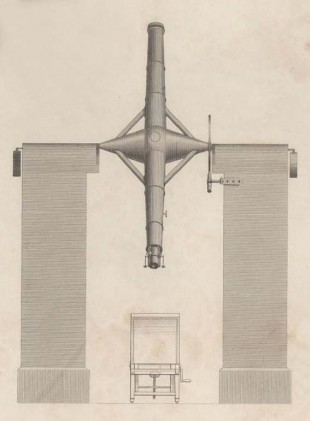
The Troughton 10-foot Transit Instrument. Drawn by J Farey and engraved by T Bradley. Plate 16 (adapted detail) from Pearson's An introduction to practical astronomy (London, 1829). Image courtesy of Robert B. Ariail Collection of Historical Astronomy, Irvin Department of Rare Books and Special Collections, University of South Carolina Libraries
Telescopes and clocks acquired during Pond’s tenure
Mural Instruments
Troughton 6-foot Mural Circle (1810)
Jones 6-foot Mural Circles (1821 & 1822)
Troughton 10-foot Transit Instrument (1816)
Zenith instruments
Pond’s 9½-foot Zenith Tube (1812)
Pond’s 8-foot Achromatic Zenith Telescope (c.1820?)
Pond’s 25-foot Great Zenith Tube (1833)
Fixed telescopes for special investigations
α Aquilae and α Cygni Telescopes (1816)
Large equatorial telescopes
The Shuckburgh Equatorial (erected 1816)
The Western Equatorial (c.1824)
Large Herschelian reflectors
Ramage's 25-foot telescope (c.1820)
******
Regulators
Arnold & Son Degree Clock, 3-month (c.1793)
Grimalde & Johnson, 8-day (c.1818)
Other timing devices
Johnson, Journeyman Clock, (1818)
2 Alarm clocks designed by Thomas Taylor (1812)
Greenwich Time Ball (1833)
Innovations in observing techniques
‘As a practical astronomer Mr. Pond had no superior; few, if any, equals. His perception of the capabilities of instruments generally, and of the mode of so using them as to render all their strong points available and their weak ones unprejudicial, formed a very striking feature in his professional character.’
Obituary, Morning Chronicle (1836)
Pond’s mastery of the Mural Circle was second to none. The 6-foot Mural Circle by Troughton ordered in 1807 by Maskelyne was finally erected at Greenwich in 1812 and put into use. On 8 July 1819, a bill for £15.11.10 from a ‘Mr Allen for distilled quicksilver [mercury] for observing by reflection’ was transmitted to the Admiralty for payment (RGO6/22/98) and on 14 September 1821, the first published observation by reflection from a tray of mercury with the Circle was made. Three years later, in 1824, a second virtually identical Circle ordered from Jones for the Cape Observatory was erected at Greenwich for trial before being shipped overseas. Used in parallel with the Troughton Circle, it allowed simultaneous direct observations and observations by reflection to be made and in so doing, brought measurements of NPD to a new level of accuracy. So successful was the trial, that the Jones instrument was retained at Greenwich and the Cape had to wait for a second instrument by Jones to be completed.
On 12 May 1826, Pond read his paper Explanation of the Method of Observing with the Two Mural Circles, as Practised at Present at the Royal Observatory of Greenwich at the (Royal) Astronomical Society. It was subsequently published in
Memoirs of the Royal Astronomical Society, Vol 2.pp. 499-502
and republished in the
1826 volume of Greenwich Observations
Pond’s observing instruments and observing techniques were described in 1850 by Robert Main (Airy's First Assistant) in London and its Vicinity exhibited:
‘Mr. Pond’s idea of the use of two circles together may perhaps be rendered sufficiently clear to the unscientific reader. Imagine a certain number of stars to be observed on any evening with one instrument by direct vision, and with the other by reflexion in a trough of mercury; on the following evening suppose that the same stars are observed directly with both instruments. The mean of the differences of the second set of observations will give very accurately the difference of the readings of the circles for the same object, or the difference of their index errors or zenith-points. If this difference, thus found, be applied therefore to the direct readings of the circle which did not observe at all by reflexion, we shall reduce them to the direct readings which would have been found for those objects observed by reflexion with the other circle. We have therefore virtually a series of objects observed directly and by reflexion with the same circle; and it is clear that half the sum of each pair of direct and reflexion readings will give the reading for a point situated in the horizon, called, technically, the “horizontal point;” and the mean will give the horizontal point very accurately, from whence, by the application of 90º, the zenith point is found.’
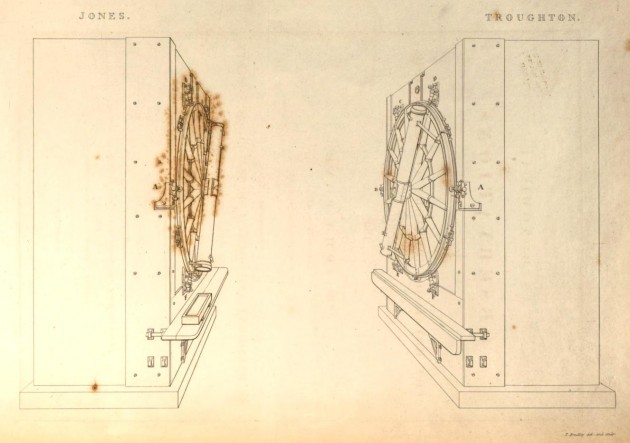
The Jones and Troughton Mural Circles. Note the shelves located beneath each instrument which were designed to hold the trays of mercury for observation by reflection. Although each telescope is annotated with the letters A–F, Pond did not provide an accompanying key. Drawn and engraved by T Bradley and published in the 1826 volume of Greenwich Observations. Digitised by Google from the collections of Princeton University
Pond also proposed a new way of observing with his new zenith sector:
Some suggestions relative to the best method of employing the new zenith telescope lately erected at the Royal Observatory (Phil. Trans. R. Soc.124, pp.209–212 (1834)
Continuation of a former paper on the twenty-five feet zenith telescope lately erected at the Royal Observatory (Phil. Trans. R. Soc.125, pp.145–151 (1834))
Published Observations
Like those of Maskelyne, Pond’s observations were also published under the title: Astronomical observations, made at the Royal Observatory at Greenwich. The first to be published were from 1811 and 1812. The subsequent observations were published annually until 1824. From the beginning, Pond made the decision to group consecutive years together into single volumes as far as the page numbering is concerned. Volume 1 covers the three years 1811–13. Volume 2 covers 1814–16; volume 3, 1817–19; Volume 4, 1820–22; but Volume 5 covers just the years 1823 and 1824. After this, the observations were published quarterly along with an annual supplement (from 1830 onwards), and all attempts at assigning them to a particular volume ceased. Because of the way the observations were released different owners bound them in different ways. As a result, there is an inconsistency in the way they appear in library catalogues. The 1811–12 observations were priced at two guineas; the annual observations cost one guinea and the quarterly observations five shillings.
The names of the person making each observation were only published from 30 April 1825 onwards.
Index to Pond’s Observations for the period 1811–1832
Pond’s Observations 1811–1813 (Volume 1)
Pond’s Observations 1814–1816 (Volume 2)
Pond’s Observations 1817 (Part 1 of Volume 3)
Pond’s Observations 1818 (Part 2 of Volume 3)
Pond’s Observations 1819 (Part 3 of Volume 3)
Pond’s Observations 1820 & 1821 (Parts 1 & 2 of Volume 4)
Pond’s Observations 1822 (Part 3 of Volume 4)
Pond’s Observations 1823 (Part 1 of Volume 5)
Pond’s Observations 1824 (Part 2 of Volume 5)
Pond’s Observations 1825
Pond’s Observations 1826
Pond’s Observations 1827
Pond’s Observations 1828
Pond’s Observations 1829
Pond’s Observations 1830
Pond’s Observations 1831
Pond’s Observations 1832
Pond’s Observations 1833
Pond’s Observations 1834
Pond’s Observations 1835 (includes Airy’s 1835 Observations)
Higher resolution and full colour versions of all of the above (via Hathi Trust)
Of particular importance in later years were his double-altitude observations of stars made between 1825 and 1835 which were used by Chandler in the 1890s for his studies of variation of latitude. Chandler was forthright in his praise writing (Astronomical Journal, vol. 14, iss. 313, p. 1-6 (1894)):
‘This beautiful series of observations may be regarded as one of the most remarkable in modern astronomy. ...
Nothing could better illustrate Pond’s peculiar genius as an astronomical observer than the sagacious common-sense displayed in this simple scheme, and the industry and pertinacity with which it was carried out for more than a decade. The rich mine of stellar measurements thus provided has remained practically unworked for sixty years, only now to yield a part of its priceless information, and to emphasize Bessel’s profound characterization of Pond’s work as the “ne plus ultra of astronomical observation.”
Pond‘s method of operating these admirable instruments was continued after his retirement and death, but, after a year or two, in a more desultory and less well-balanced fashion, and ultimately fell into practical desuetude.‘
Click here and Click here for more papers relating to Chandler’s work on variation of latititude.
Another of Pond’s highly regarded publications is his Catalogue of 1112 stars which was published in 1833. Writing in 1850, Airy's First Assistant Robert Main described it as ‘the most valuable contribution of that period to sidereal astronomy’ and yielding to no modern catalogue in accuracy. The Catalogue had a short introduction, which ended with the following paragraphs under the heading On some other possible Causes of Disturbance in the proper Motion of Stars, in which Pond considered the secular aberration resulting from the motion of the solar system in free space:
‘Amongst the possible, but not very probable, causes of discordance in the proper motions of the fixed stars, it occurred to me, many years ago, that perhaps the aberration of light, due to the motion of the solar system in free space, might have some influence on their positions. The effect of such a supposition I will endeavour to state as briefly as possible.
The point of the heavens towards which the Sun moves, and the opposite point from which it recedes, will be stationary; the great circle, equally distant from these points, will be thrown forwards, and all stars situated in it will suffer the maximum of distortion, all being equally affected. Stars situated in smaller circles will be less affected, as they are placed nearer the points above mentioned.
So long as the motion of the Sun continues uniform and rectilinear, this aberration or distortion from their true places will be constant: it will not affect our observations; nor am I aware that we possess any means of determining whether it exist or not. If the motion of the Sun be uniformly accelerated, or uniformly retarded, then the great circle of maximum of aberration will be thrown gradually forward in the case of accelerated motion, and backward by retarded motion.
The effects of either of these suppositions would be, to produce uniform motion in every star according to its position, and might in time be discoverable by our observations, if the stars had no proper motions of their own: but as the stars have a proper motion of their own, and that probably not uniform, these effects would be extremely complicated and confused, requiring an immense length of time for their development by astronomical observation.
If the motion of the Sun should not be uniformly accelerated, but of the nature of a body falling to a fixed point of attraction, (as if a stone fell from the Moon to the Earth) then the motion of the stars would not be uniform; and the confusion of this with their proper motion would be so great, that ages might elapse before data could be collected sufficient to extricate the effects of one cause from that of another.
Any change of direction in the Sun’s motion might produce a sensible effect in a much shorter time. But it is needless to enter into further speculation on questions that appear at present not likely to lead to the least practical utility, though it may become a subject of interest to future ages.’
As the authors of Gaia Early Data Release 3: Acceleration of the solar system from Gaia astrometry were to note in 2020, ‘this was a simple, but clever, realisation of the consequences of aberration, really new at that time and totally outside the technical capabilities of the time.’ before going on to explain further the significance of Pond’s idea to the work discussed in their paper.
Published papers
The SAO/NASA Astrophysics Data System (ADS) lists 29 scientific papers by Pond in addition to those that were published in the volumes in the section above. Of these, 20 were published in the Philosophical Transactions of the Royal Society (RSPT), four in the Monthly Notices of the Royal Astronomical Society, three in the Memoirs of the Royal Astronomical Society (MmRAS) and two in Astronomische Nachrichten (AN). Interestingly, although Pond was a founding member of he Royal Astronomical Society it wasn’t until 1827 that he had a paper published by them (one was read in March 1826).
The SAO/NASA Astrophysics Data System (ADS) list of papers
Papers published by the Royal Society can be downloaded from here
Chronometers
The Observatory’s involvement with Chronometers dates back to 26 April 1766 when the Board of Longitude resolved that Harrison’s longitude watch (H4) along with his three earlier seagoing clocks should be tested there. Over the next 50 years, a small number of other chronometers were also tested mainly for the Board (these included Kendal No.1, Mudge “Green” and Mudge “Blue”).
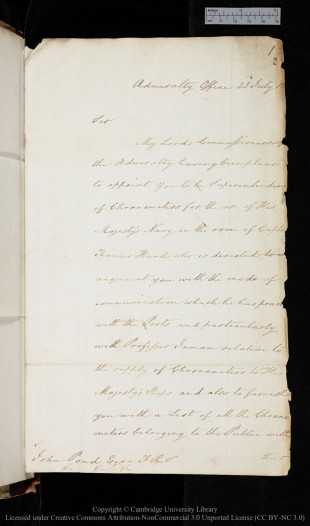
Part of the letter notifying Pond of his appointment as Superintendent of Chronometers. Reproduced under the terms of a Creative Commons Attribution-Non-Commercial 3.0 Unported License (CC BY-NC 3.0) courtesy of Cambridge Digital Library (see below)
A month earlier, on the 22 June, following up a suggestion from the chronometer maker WJ Frodsham, the Admiralty instigated a series of annual trials at the Observatory ‘for the purpose of further encouraging the improvement of chronometers’, details of which were published by Croker in the 26 June 1821 edition of the London Gazette (p.1351). To encourage makers to submit their instruments, it was announced that the Admiralty would ‘purchase, at the end of each year, the chronometer which shall have kept the best time, at the price of £300, and the second best at the price of £200’.
The first trial began in 1822, and was followed by twelve others. From 1828 instead of agreeing to purchase the two best chronometers, the Admiralty instead purchased the best three for £200, £170, and £130 respectively. Each of the trials, which became known as the ‘Premium Trials’, lasted for a period of 12 months. They were discontinued in 1836 at the end of the thirteenth trial as no useful purpose seemed likely to be served by continuing them. Over the course of the trials, there had been no marked improvement after the first four trials nor had there been any new inventions or discoveries. Worse still, some individuals had abused the system by entering chronometers that they had not made. In 1840, a new series of trials in a different format was begun by Pond’s successor, George Airy.
As well as being responsible for conducting the trials Pond was also required to run the complete administration for the issuing and receiving of chronometers. Airy objected to this arrangement and managed to ditch much of the administrative work as he told the Visitors when he presented his Annual Report in June 1836:
‘ I have on a former occasion expressed to the Visitors my belief, that the oppression of business arising from the care of chronometers has been most injurious to the astronomical efficiency and general reputation of the Royal Observatory: and I take this opportunity of repeating that belief. I also beg to remark, that this oppression has not been produced by that part of the business which relates to the rating or reporting upon or experimenting upon chronometers, but by that which relates to the money accounts, the accounts of chronometers in store, &c., and the delivery of chronometers to ships. At my representation, alterations have been made in several of the arrangements, the effect of which has been to diminish in some degree the various interruptions to the astronomical business of the place. If at any subsequent time it should be necessary for me to request an expression of opinion from this Board, I trust that I may represent their sentiments correctly by saying, that the persons of this establishment are astronomical observers and calculators, not clerks; that the Observatory is an astronomical institution, not a storehouse; and that any regulation which makes the account-keeping and storekeeping department predominant over the astronomical is an unjustifiable and injurious diversion of its powers.’
Click here to read more about the Chronometer Trials
The building of a Magnetic Observatory, pendulum experiments and other changes to the buildings and grounds
Pond not having any children, meant that there was no pressure on the living accommodation in Flamsteed House which had been extended only twenty years earlier for Maskelyne. Apart from the addition of the time ball on the roof in 1833, he made only one other change to Flamsteed House. The ground between the western summerhouse, the boundary wall and Flamsteed’s study on which Halley’s transit instrument had stood, was excavated in 1820 to create a room ready to receive his 25-foot Great Zenith Tube. It was described by Airy as ‘a square tower like a steeple’. At the same time, to give uniformity to the appearance of the important north front of Flamsteed House, the wall was built which connects Flamsteed House to the eastern summerhouse.
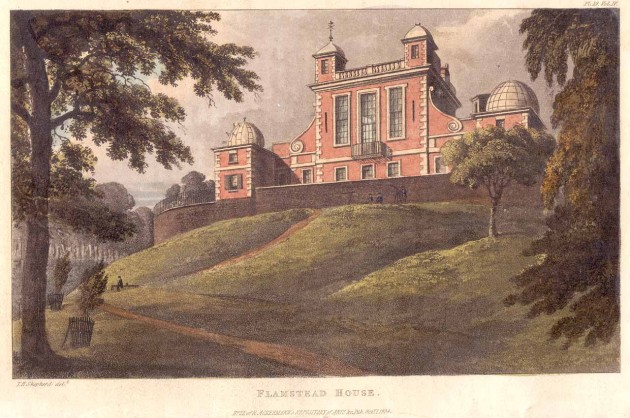
Flamsteed House. Drawn by TH Shepherd and published on 1 October 1824 by R Ackermann in his Repository of Arts, Literature, Fashions &c. The two converted summerhouses with their domes can be seen to the left and right. By 1824 (or soon after), the east dome (left) housed the Shuckburgh and the west dome the Western Equatorial. Each had a restricted view of the sky due to the presence of the Octagon Room (centre). The lantern on the top of the room created by Pond for the Great Zenith Tube is just visible between the Octagon Room and the western dome
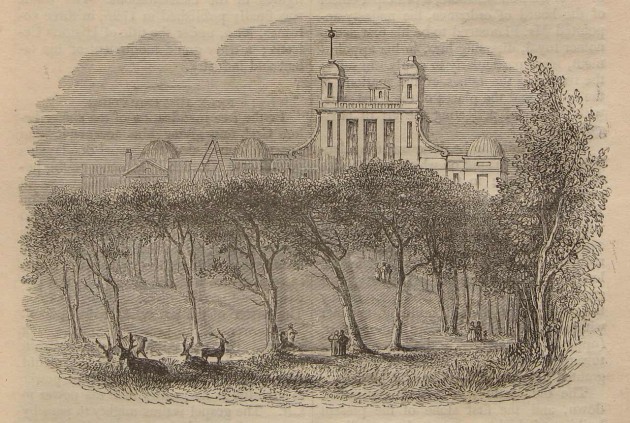
The Royal Observatory from the north with Ramage's 25-foot telescope rising up from the Courtyard and the newly installed time ball on the roof of Flamsteed House. Curiously, the 1820 addition to Flamsteed House for the Great Zenith Tube has been omitted. From The Weekly Visitor, (3 Feb, 1835)
In 1813, the footprint of the Meridian building was increased by an extension to the east of the Circle Room. The foundation stone was laid on 8 July and the architect was Mr Full from the Ordnance a (RGO6/1/53). The extension was of two stories where it joined the existing building (echoing the central section of the earlier Bradley Observatory), and of single story at its eastern end. Unlike the extension built in 1808/9 for the Mural Circles, the new extension could only be accessed from the outside, not from the existing building, a situation that remained until the late 1840s. The two story part contained a conical shaped pier and was surmounted by a dome for the Shuckburgh Equatorial. The pier proved defective and the telescope was never mounted there, being mounted instead, in 1816, in the east dome that had been created from one of the Summer Houses. The single story section contained apartment rooms. These were the last part of the extension to be completed and were finished in February 1815. When Airy took over as Astronomer Royal in 1835, when all the assistants were required to live out.
When in 1821, charge of the chronometers of the Royal Navy was transferred from the Hydrographic Office to the Observatory. The library housed on the upper floor of the 1813 extension was appropriated for the chronometers and an additional floor built above the single story apartment to accommodate the displaced library (RGO6/1/55). In 1824, a second mural circle was erected alongside the first, necessitating an alteration to the layout of the Circle Room and its roof.
By the late 1820s, the western side of the Bradley's Quadrant Room at the other end of the building was sometimes referred to as the Pendulum Room. It was here that Edward Sabine carried out his pendulum experiments with the help of Thomas Glanville Taylor in 1828 and 1830. One of the clocks by Graham and the iron pendulum frame were fixed to the south wall and a vacuum apparatus set up in the south-west corner. Click here to read about the 1828 experiments and click here to read about those carried out in 1830.
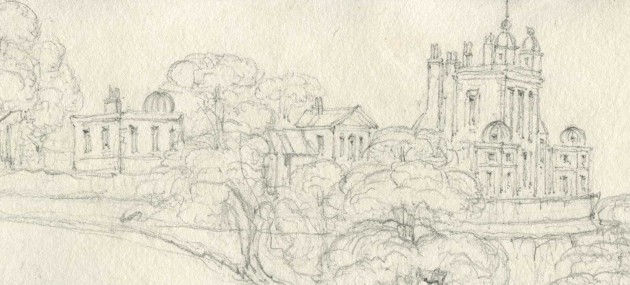
The Meridian Building (left) with Flamsteed House to the right. Detail from a pencil drawing by an unknown artist, 1838–1840. The left end of the Meridian Building with the dome on the roof is Pond's extension of 1813/182
Under Pond, as under both his predecessor and his successor, the grounds were also extended. In Pond's case, the additional land enclosed was to the south of the Meridian Building. Enclosed in 1814, it was put to use as a kitchen garden.
Although magnetic observations had been sporadically made since Flamsteed’s time, it wasn’t until Pond was Astronomer Royal that a permanent observatory was set up at Greenwich. In 1816, the Admiralty asked Pond, to make regular observations of magnetic variation (declination) (RS MSS 371/15). A Magnetic House was put up in the newly enclosed ground during April and May 1817 (RGO6/1/54), and observations commenced in 1818. Since the level part of the ground was in use as a kitchen garden, it was perhaps for this reason, that Pond made the unwise decision to place the observatory on the east side on the slope of the hill. The foundations rapidly gave way, causing the building to become so dangerous, that the instruments were removed (RS MS372/171/10). The building was demolished in 1824 and magnetic observations ceased until a new observatory was established on a new site by Airy in 1838.
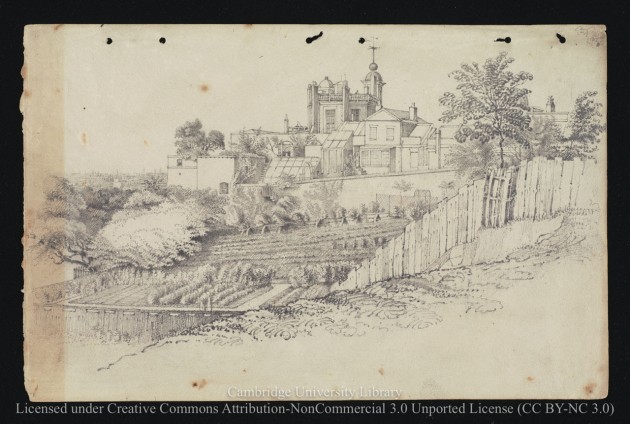
The Kitchen Garden as it existed between 1814 and 1837 when the Magnetic Ground was enclosed for Airy. Pond's Magnetic House (demolished 1824) was located on the slopes just to the left of the tree on the right. Bounded by the existing south facing wall (middle distance, centre) and a wooden fence, the garden was highly visible to members of the public in the Park. Pencil drawing by Caroline Smith, 1836. Reproduced under the terms of a Creative Commons Attribution-Non-Commercial 3.0 Unported License (CC BY-NC 3.0) courtesy of Cambridge Digital Library (see below)
More about the buildings and grounds and their evolution can be read here:
Flamsteed House and the Summerhouses
The Meridian Building
The Magnetic Observatory
The Kitchen Garden (known later as the lower Garden)
The Observatory Library
Although Pond inherited Maskelyne’s Assistant and a set of functioning (though time-expired) meridional instruments, he inherited little by way of a library. Prior to Pond’s time as Astronomer Royal, there was no Observatory library that was handed on from one Astronomer Royal to the next. Maskelyne had an extensive personal library. Bar just a few titles that were left for Pond or retained by the family (79 of which were donated to the Observatory in 1911 (1912 Report of the Astronomer Royal)), most of the astronomical and mathematical volumes were sold at auction after he died.
Amongst Maskelyne’s records is his list of all the ‘Books bought or given me since my first coming to the University Novr 5 1749’ (WSHC 1390/13). Following his death, his library was valued on 7 March 1811 by the bookseller Thomas Paine at £530 (NMM/REG/9/37). It is not clear at present if this was a valuation for the whole library or just the part that was sent to auction. The library was sold by Leigh and Sotherby in a three-day sale of 757 lots that commenced on 27 May 1811 and raised £451.18.6. A copy of the auction catalogue which claimed to be ‘of the entire and very valuable Astronomical and Mathematical library’ survives among Maskelyne’s papers and has been annotated with the hammer price of each lot. An interesting (though uncorroborated) claim was made about the auction in the September 1820 edition of The Philosophical Magazine and Journal.
‘On the death of Dr. Maskelyne in 1811 some of his friends informed Mrs. Maskelyne that his library, which contained a judicious selection of the best books connected with astronomy in all languages, would be a valuable acquisition to the Doctor's successor, whoever he might be. She therefore offered the whole library to Government on a fair valuation. The members of administration to whom this proposal was made were at first disposed to accede to it: but, on consulting Sir Joseph Banks on the subject, who, as President of the Royal Society, was one of the visitors of the Observatory, he depreciated the value of the library, and persuaded them to decline the offer. The consequence was, that the library was sold by auction, and agents employed by Sir Joseph selected during the sale those books which they thought most valuable.’
Although published under the anonymous authorship of ‘A Correspondent’, Howse has identified the author as Olinthus Gregory (Nevil Maskelyne, 1989). Published as part of an attempt to smear Banks following his death in 1820, how much weight it should be given is left for the reader to judge in light of what follows below.
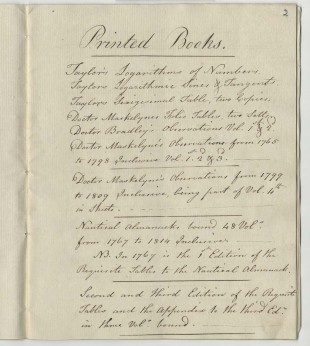
The complete list of books left by Mrs Maskelyne for the Observatory according to the inventory that she retained (NMM REG09-000037). Reproduced under the terms of a Creative Commons Attribution-Non-Commercial 3.0 Unported License (CC BY-NC 3.0) courtesy of Cambridge Digital Library (see below)
Two other contemporary versions of the inventory have survived and are preserved in the archives of the Royal Society. One was delivered by Mrs Maskelyne to Joseph Banks in his role as President of the Board of Visitors on 15 April 1811 (RS MS372/168). The other seems to be a draft from which the copies given to Banks and retained by Mrs Maskelyne were made. Unlike these other two inventories, the draft does not list the pictures, but importantly, lists the books and manuscripts on a closet by closet and a room by room basis and carries the following signed note of the last page (RS MS372/167):
‘The above collection of Books and manuscripts were safely delivered to my care by Mrs Maskelyne. John Pond’.
From it we discover that in 1811, all the original manuscripts and observations of Flamsteed, Halley and Bradley were stored in the Great Room (the Octagon Room). The inventories given to Banks and retained by Mrs Maskelyne differ from one another in both their ordering and content; that given to Banks indicating that a small number of additional books had been left. All three make reference to the Bradley Manuscripts. Two refer to them as the ‘Original Observations and Calculations’, whilst the third refers to them as the ‘Original Manuscripts and Observations’. This is all rather curious as following Bradley’s death in 1765, his observations were claimed from the executors by the Board of Longitude. This claim was abandoned in 1776, after Bradley's son-in-law, Samuel Peach, presented them to Lord North, Chancellor of the University of Oxford, who in turn presented them to the University on condition that they should be printed and published. Click here to read more. The manuscript observations were returned to Greenwich in 1861. In the meantime however in March 1843, Airy ‘wrote to Dr Wynter (Vice-Chancellor) at Oxford, requesting permission to see Bradley’s and Bliss’s manuscript Observations, with the view of taking a copy of them’, a wish that was apparently granted (autobiography). This request seems slightly odd since those of Bliss were supposedly already in the ownership of the Observatory having been acquired for it by the Board of Longitude in 1768 (RGO14/5/167&8, see also Board of Visitor Reports 1843–1846) . It is possible however that they were in Oxford at the time when Maskelyne died, not only because they don’t appear in the inventory, but also, because they appear to have been lent to the Clarendon Press so that they could be published in conjunction with the second volume of Bradley’s Observations (which was published in 1805).
Despite its apparently small beginnings, when an inventory was taken of the books in the Observatory library in 1827, it ran to 66 printed pages. Click here to see the full inventory as published. How these books arrived in the library is a subject for further research, though some details are given in the 1811 and later minutes of the Board of Visitors, including the fact that some were indeed purchased during the sale of Maskelyne’s library (RGO6/22).The first mention that the Observatory should start building a library comes on 25 April 1811, when at a meeting of Council of the Royal Society, it was proposed by the President in his role as Chairman of the Visitors that he should visit the Secretary of State of the Home Department with a view to putting a request to the Prince Regent
‘to order that the warrant for repairing and supplying Instruments to the Royal Observatory should be extended likewise to the supply of Books for the formation and increase of an astronomical library.’ (RGO6/22/63)
It was also agreed that the Royal Society should provide the Observatory with a complete a run as possible of Philosophical Transactions from the stocks that it held.
At the Visitation of the Observatory held on 7 May, the President informed the Council that he had seen the draft of a Warrant from the Prince Regent to enable the Board of Ordinance to purchase books for the Observatory and that although it was not yet signed; the Prince Regent had signified that it would be. In light of this, Council were of the view that the opportunity of purchasing books at the sale of Maskelyne’s library should not be lost and requested Pond to select and purchase such books as he thought necessary if sold at a reasonable price. Although not all the minutes have been examined for details of purchases, an examination of those for the four years 1811–15 shows a total expenditure on books of £733.2.8., the following bills having been presented to Council for payment by the Ordnance.
| 1811, July 11 | £133.19. | Mr Mackinlay’s bill for the purchase of books at the sale of Dr Maskelyne’s Library (RGO6/22/66) | |
| 1811, November 21 | £194.19. | Two bills for books from unspecified suppliers (RGO6/22/68) | |
| 1812, May 14 | £19.7. | Edward Troughton’s bill for the supply of Bodes and Flamsteed's celestial atlases and Smiths Optics (RGO6/22/71) | |
| £41.16. | Bill from Mr Priestly (RGO6/22/71) | ||
| 1813, February 25 | £68.1.2. | Bill from Messrs Dulan & Co (RGO6/22/74) | |
| £93.14. | Bill from Richard Priestly (RGO6/22/74) | ||
| 1813, March 18 | £146.18.6. | Bill for books from Dr Maskelyne’s Library purchased by the late Mr J. Mackinlay (RGO6/22/74) |
|
| 1815, January 26 | £168.14.6. | Bill from Messrs Dulan & Co (RGO6/22/81) | |
| 1815, March 9 | £12.12. | Bill from Richard Priestly (RGO6/22/82) | |
| Total, 1811–1815 | £880.0.2. |
More books continued to be added after the 1827 catalogue was produced. In 1828 for example, a bill for £65.1s.0d was submitted for books supplied to the Observatory by Dulan & Co of Soho Square between March and July. In this instance the actual bill survives and itemises the individual books (RS MS371/72).
Although Airy took charge of the Observatory on 1 October 1835, he remained living in Cambridge until the end of the year, leaving the Observatory in the hands of his newly appointed First Assistant, Robert Main, to whom he sent copious instructions. In early 1836, Airy appears to have conducted an audit of the library, which he found deficient (RGO6/72/32). In a letter to Charles Wood at the Admiralty, dated 29 February 1836, he wrote:
‘The Observatory Library is in a bad state. The number of missing books (from the Catalogue made in 1827) is great: and there appears to have been a total neglect, as to keeping up sets of books &c. for several years. May I request you to inform me whether a large sum of money – say £100 can be placed at my disposal ...’.
Wood replied the follow day saying that there would be no difficulty in giving him £100 (RGO6/72/33). Without sight of Airy’s audit (possibly contained in the copy of the 1827 catalogue held at the National Maritime Museum (PBG0889) that previously belonged to the Observatory), it is impossible to know how many books were missing, but it has to be said, that any more than a dozen books being unaccounted for would undoubtedly be described as a great number by Airy!
When the Royal Observatory was shut down in 1998, the more historic books in its library were transferred to the National Maritime Museum in Greenwich in its capacity as guardian of the former home of the Royal Observatory. Despite having been started under Pond, the collection of books became known as the Airy Collection of Rare Books. According to George Wilkins, the name Airy Collection was introduced at the beginning of 1981 by the then librarian, Janet Dudley, (who had been appointed in 1978) as Airy had collected many of them during his period as Astronomer Royal. Now known as the Airy Library Collection, it is incorrectly described in the Museum Blog as having started as the personal library of Airy. It is understood from another blog entry to include all those books in the library that were published up to and including 1881 when Airy retired.
Discussions with the Admiralty and Visitors on increasing the number of Assistants
‘Ill health, disinclination, or perhaps inability, to mix in the instructive eating and drinking parties of the [Royal] Society, and a determination to resist an Admiralty scheme (of providing gentlemen Observers with salaries of 400l. or 500l. a year), which, in his opinion, if carried into effect, would have destroyed the practical utility of the Observatory, has, among a certain set, and in certain quarters, perhaps rendered him somewhat unpopular; he has, however, the satisfaction of knowing, that he has averted from our Observatory, a calamity similar to that of which the Observatory of a neighbouring country has long felt the curse.’
‘Mr. Pond’s zeal led him to urge repeated increases of the establishment at Greenwich upon the government, … In these and similar attempts, Sir Joseph Banks, then President of the Royal Society, gave him effectual aid; but, after his death, it was only by repeated applications that Mr. Pond could obtain the amount of force absolutely necessary to carry his system of observation into full vigour. He also effectually resisted a well-meant, but injudicious attempt, to give him for assistants persons who, from the mode of their appointment and pretensions, were little likely to submit to the rigid subordination required in a well-ordered establishment. His firmness on this occasion probably saved the Greenwich Observatory from being a board of co-ordinate rivals, instead of the best-disciplined, most effective, and most economical institution in the country.’
Obituary. MNRAS (1837)
Between 1811 and 1825, five new assistant posts were created at the Observatory. The first of these was filled by John Belville who was taken on by Pond in 1811. In the Report of the Visitors dated 30 June 1815, there is a reference to ‘ the degree of necessity which compelled the Astronomer Royal to take upon himself the responsibility of engaging an Assistant before he was authorised to do so’ (RS MS600/69-72). Pond seems to have adopted a similar approach when he made two further appointments in 1822 and two more in 1825.
At a meeting of the Board of Longitude held on 4 December 1817:
‘The Astronomer Royal also Represented that the business of the Royal Observatory had of late so greatly increased that the present Assistants [Taylor & Belville] are unequal to make the required computations many of which are necessary for the Calculations & corrections of the Nautical almanacs; [and it was]
Resolved that the Board considers this representation highly deserving attention, and requests the Astronomer Royal do to seek an interview with the First Lord of the Admiralty on the subject.’ (RGO14/7/238)
According to the minutes of the next meeting, which was held on 3 March 1818, the meeting between Pond and the First Lord never took place (RGO14/7/245) and following the introduction three days later of the 1818 Longitude Act to Parliament, the subject of extra assistants seems to have been dropped.
Although several writers have looked into the discussions that took place about extra staffing in the 1820s, none to date, have told the complete story. This could be because Pond’s own records seem to be scanty to non existent and the records elsewhere are fragmented. The story below has been pieced together from the minutes of the Royal Society (which consist of little more than resolutions and transcripts of letters and reports), together with any known correspondence that exists elsewhere. It begins in 1822 and ends in 1831. As it unfolds, we see quite clearly what Pond’s obituarist meant when he referred to his ‘dislike to every thing like contention, which almost amounted to a failing’. The key Players, apart from Pond, were:
- Humphry Davy, President of the Royal Society (1820–1827),
- John Croker, First Secretary of the Admiralty and member of Council until St Andrews day 1825 (30 November)
- John Barrow, Second Secretary of the Admiralty and member of Council from St Andrews day 1825
- William Wollaston, member of Council and an old college friend of Pond
Like Pond, all four were also members of the Board of Longitude.
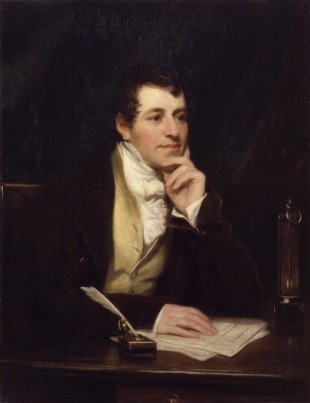
Sir Humphry Davy. President of the Royal Society, 1820–1827. Oil on Canvas, by Thomas Phillips, 1821. © National Portrait Gallery, London. Reproduced under a Creative Commons Attribution-NonCommercial-NoDerivs 3.0 Unported (CC BY-NC-ND 3.0) licence (see below)
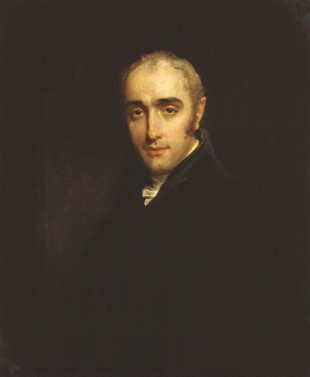
John Wilson Croker by William Owen. Oil on canvas, circa 1812. Croker was elected to parliament in 1807 and held the post of First Secretary to the Admiralty from 1809–1830. He was elected a fellow of the Royal Society in 1810. © National Portrait Gallery, London. Reproduced under a Creative Commons Attribution-NonCommercial-NoDerivs 3.0 Unported (CC BY-NC-ND 3.0) licence (see below)
Wearing his Admiralty hat, Croker sent the President of the Society (Humphry Davy) a draft reply to which Davy sent a reply on Thursday 13 March 1823:
‘I am very much obliged to you for giving me an opportunity of perusing the draft of the proposed letter on the new assistants at the Observatory. Nothing I think can be better both as to matter & form. I have no doubt if the plan is carried into effect it will be connected with important actual benefits, both in encouraging the cultivation of the higher mathematics & as securing & extending the utility & reputation of the Royal Observatory.
I had not intended to call a meeting of the Council till after Easter, but the interest of the subject is great & if you think it expedient to discuss it immediately a Council may be summoned for next Monday. Pray be so good as to give me a single line as to this point.’ (American Philosophical Society (file B.D315.1) via http://davy-letters.org.uk)
Having received Davy's approval, Croker sent a fomal response on behalf of the Admiralty to Council on 14 March 1823. Whilst agreeing in principle to two extra staff, they proposed that rather than the lowly type of assistant that was currently being employed, the new assistants should be of a superior class with a university education and great mathematical attainment and paid accordingly, with the salary of ‘the First Assistant to commence at £300 a year and to increase by £10 a year to [a maximum of] £500’ and that of 'the other three assistants to commence at £100 and to increase at the same rate of £10 a year up to £300. (RGO6/22/124). The proposal was, that the First Assistant should either be an outsider or should be selected from amongst the other assistants on the basis of merit rather than seniority; but crucially, that the opening would not be open to any of the existing assistants. What was being proposed was a completely new salary structure that took no account of the fact that all four posts were already filled, albeit with the last two appointments supposedly having been made only on a temporary basis (and which the Admiralty may or may not have known about). The letter was duly read at a Council on 20 March (Croker present), but as Pond was not present, he was sent a copy and asked for his opinion (RGO6/22/125). Pond did not attend the next meeting on 17 April. Nor had he responded to the request for his views on the matter. In light of this, he was written to again, and asked for an immediate reply. There is no evidence in the the Council minutes (or at least in RGO6/22, the copy made for Airy) that Pond ever did respond in writing. Indeed, there was no mention of the matter in the minutes of the meeting of Council held on 18 May from which Pond was also absent.
At their meeting on 12 June, which Pond but not Croker did attend, Council endorsed the Admiralty's proposal for assistants of a superior class to be employed and a short letter was dispatched to Croker to this effect stating:
'The President and Council entirely coincide in opinion with their Lordships respecting the propriety of appointing a new and superior class of assistants at the Royal Observatory and that they fully enter into the enlightened views of their lordships as to the advantages likely to arise from the proposed plan in promoting the cultivation & advancement of astronomy and of the higher mathematics. ...' (RGO6/22/127)
On 20 November 1823, it transpired at a meeting of Council attended by Pond (but not Croker) that the two temporary assistants had not yet received any pay (despite the fact that they had been employed for the past16 months). As a result, a letter was written to the Admiralty recommending that each be advanced £100 on account (RGO6/22/129).
On 8 December 1823, the Admiralty sent the proposal for approval to His Majesty in Council, suggesting to the Visitors that the posts should be filled as quickly as possible after approval was given. This was read to a meeting of Council (which Pond didn't attend) on 18 December (RGO6/22/130). Immediately after the meeting, letters were exchanged between James South and John Herschel in which Herschel advised ‘caution in countervening John Pond’s preferences in the appointment of Royal Observatory assistants.’ (RS:HS 16.424 & RS:HS 16.425).
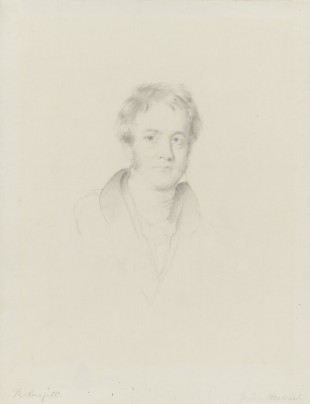
Sir John Frederick William Herschel, 1st Bt by Henry William Pickersgill, pencil, circa 1835. © National Portrait Gallery, London. Reproduced under a Creative Commons Attribution-NonCommercial-NoDerivs 3.0 Unported (CC BY-NC-ND 3.0) licence (see below)
At a meeting of Council on 18 March 1824 at which both Pond and Croker were present, it was resolved
‘That a letter be written to the Admiralty stating that the Astronomer Royal being of the opinion that the present senior assistant is likely to be incapable of conducting the business of the observatory upon an enlarged scale, the Council begs leave to recommend that Mr Taylor be allowed to retire with a suitable pension, and that a new assistant be appointed in his place of the superior class and that the Council being also informed by the Astronomer Royal, that Mr T [Glanville] Taylor and Mr Richardson having in the course of the last year considerably improved themselves in mathematical studies, are in his opinion fit to be retained as assistants do also recommend to the Admiralty to accede for the present to this proposal, submitting to the Board of Admiralty on what footing the appointment can be made.’ (RGO6/22/130).
The Admiralty replied a week later, their letter dated 25 March being read at a meeting of Council which Pond (but not Croker) attended on 6 May. In it Croker stated that their Lordships (of the Admiralty) concurred with what had been asked and that the two temporary assistants would be placed on the established staff on the understanding that they would not be put on the new pay scale, but would be paid at the old rate. (The Navy estimates (ADM180/34/6) indicate that they were put on the established staff the next day). Additionally, the President, Council and Astronomer Royal were asked to 'select and recommend a Gentleman qualified to hold the place of first assistant'. who would then be appointed and that when that happened, Taylor would be allowed to retire with a pension. At the same meeting, a memorial from Captain William Ronald offering his services as an assistant was laid before the Council at the request of Croker. (RGO6/22/132).
Meanwhile, on 1 April, the Admiralty had written to Pond asking him for the date on which Taylor junior and Richardson had started work (RGO5/233/7).
As far as appointing a Superior Assistant went, nothing further seems to have happened until Ronald wrote to the Admiralty on 6 November reiterating that he had previously offered himself as an assistant at Greenwich, but was now offering himself for the post of Assistant at the Cape as well, indicating his 'readiness to undergo any trial of examination as their lordships may be pleased to direct' (RGO6/22/135). On the 9 November, the Admiralty passed the letter on to the President of the Royal Society directing that Ronald should be examined by Pond to check out his abilities and qualifications for the job. Pond seems to have acted rather quickly replying to the Admiralty on 14 November that he had already had an interview with Ronald and was of the view that he was perfectly competent to undertake either the post at Greenwich or the Cape, but that he had no experience of handling large astronomical instruments and that he thought he could not fail to become a ‘valuable acquisition to ether establishment ...’ but that he (Pond) thought that he (Ronald) might prefer the Cape. And as if to make sure that Ronald didn’t come to Greenwich, Pond went on to say that he thought that
‘for Greenwich a young gentleman who should have distinguished himself at Cambridge would more decidedly meet their lordships wishes, as a university education implies something like scientific rank & the junior assistants would be more easily reconciled to the distinction But for these indirect considerations I would on my own account rather choose Captain Ronald than any other candidate I have seen or heard of.’
This letter too was forwarded by the Admiralty to the President where all the various letters were read at the next meeting of Council on 18 November (Pond was present, but not Croker), the secretary then being ordered to reply that ‘the President and Council see no necessity for any further recommendation than that contained in the letter of the Astronomer Royal.’ (RGO6/22/134-136).
On 3 March 1825, at a meeting of Council (Croker not present), with the second Mural Circle having finally been brought into use, Pond put forward a request for yet two more assistants (RGO6/22/138). The proposal was discussed at the next meeting of Council on 17 March (Croker not present) and Pond asked to produce a paper ‘stating the important results which he conceives will follow from continued observations with the two mural circles (RGO6/22/139). This was published on 20 April 1825 in the form of a four page printed memorandum (RGO6/1/51) and read by Pond at a meeting of Council on 5 May (Croker present) after which it was resolved ‘that further consideration of it be postponed’, the rest of the meeting being taken up with the accusations of Stephen Lee (see below).
In the meantime, Ronald, who had been duly appointed on 1 December 1824 as Assistant at the Cape (Warner, 1995) on a salary of £250 a year (ADM181) but not yet departed was taken on at Greenwich so that he could gain first hand observing experience with an identical instrument to the one that he was take to the Cape. Both he and a Mr Walker (of whom nothing else is known except that he appears to have arrived under similar circumstances to Ronald (RS MS371/49)) were put to work on the new Mural Circle at Greenwich in February 1825. Although Ronald was mentioned in the printed memorandum, Walker was not, suggesting that he arrived later. Both their sets of initials (R. & W.) appear in the published observations made with the Mural Circles. Each however only stayed only a few months. They both departed in June (RGO6/1/52).
Although the minutes of the annual Visitation that took place on 17 June 1825 are referred to in RGO6/22, they were not themselves transcribed into it. However, we know from the minutes of the meeting of Council held a few days later on 23 June (at which Pond but not Croker was present), that the matter was discussed as: ‘The suggestion of the Visitors that two temporary additional assistants [of the common class] be engaged’ was adopted as was the Visitors’ suggestion about accommodation for the assistants. It was ordered that these recommendations be transmitted to the Admiralty along with the recommendation that Taylor should be retained in his present position. The Admiralty was also reminded of ‘the representation of the Astronomer Royal respecting the inadequacy of the present salaries of the junior assistants’ (RGO6/22/168). This was done the following day. Although the Admiralty’s response is dated 19 July, there is no further reference to the Assistants in the minutes (or at least in Airy’s copy) until the meeting of Council that took place on 17 November (at which neither Pond nor Croker were present). It was there that the Admiralty’s reply was read out.
In it, their Lordships stated ‘that they have no objection to the addition of two temporary assistants as suggested, but before they finally sanction their appointment my Lords desire to know the names and qualifications of the persons who may be willing to accept such temporary employment.’ As far as the issue of salaries of the existing assistants were concerned, it was stated that ‘their lordships cannot recommend to His Majesty any deviation from the arrangement sanctioned by his order in Council of 19th January 1824.’ On the matter of lodgings, the Admiralty were willing to consult with the treasury, but in the meantime, were ‘glad to consider any plans for their temporary or permanent accommodation’ (RGO6/22/171).
Meanwhile, Ronald and Walker were replaced temporarily until the arrival of the two new assistants Thomas Ellis and William Rogerson in August by Mr G Bradley, who is thought to be Pond's brother-in-law James Gordon Bradley (RGO6/1/56), the observations made by Ellis and Rogerson being initialled E. & R. respectively. No initial has been found for Bradley, suggesting he was either used as a computer or for correcting copy for the press.
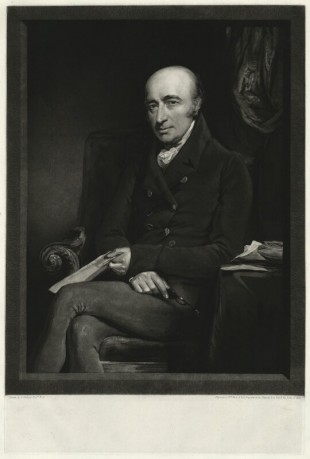
William Hyde Wollaston, by William Ward, after John Jackson. Mezzotint, early 19th century. © National Portrait Gallery, London. Reproduced under a Creative Commons Attribution-NonCommercial-NoDerivs 3.0 Unported (CC BY-NC-ND 3.0) licence (see below)
‘You have desired me to state to you confidentially, in case the question respecting the assistants, should again be considered by the council, what my real and undisguised opinion is, as to the class of persons from which for the interest of the observatory it is expedient to choose them.
I am and always have been extremely unwilling to offer or appear to offer resistance to what seemed to me to be the marked inclination of some of the members of the board of Admiralty and of the council, and actuated by this feeling I may have been less explicit at the council in expressing my real sentiments on this subject than I ought to have been – what that opinion is however and always has been I will now state’.
After re-explaining that the new methods of observing with two mural circles generated a large number of observations that needed to be reduced, Pond went on to say:
‘... I want indefatigable hard working and above all obedient drudges (for so I must call them, though they are drudges of a superior order) men who will be contented to pass half their day in using their hands and eyes in the mechanical act of observing, and the remainder of it in the dull process of calculation.’
He then went on to explain that these were not the characteristics he would expect to find 'in the highly educated class of our universities' and that he would feel ‘some compunction’, in asking them to undertake such mundane work. Nor he said, was there a need for ‘mathematical talent of a superior order’.
Pond then raised another important objection:
‘It does not appear to me conducive to the good feeling which I wish to see maintained among them to have two classes of servants performing the same duties, but rewarded in a very unequal manner.’
His letter continued:
‘In spite of these objections which I feel to the new plan I beg you to understand that should that plan be finally decided on, I am now as I always have been ready cheerfully to acquiesce on it and carry it into execution.’
After citing the readiness that he had showed the Admiralty by putting Ronald and Walker on trial at the Observatory he went on to remind Wollaston that the Council had backed his request for two additional assistants of the ‘common class’ and for the retention of Taylor and that this decision had been exonerated. He concluded by saying that he authorised Wollaston the make use of his views as expressed in the letter ‘in any way that your prudence may suggest.’
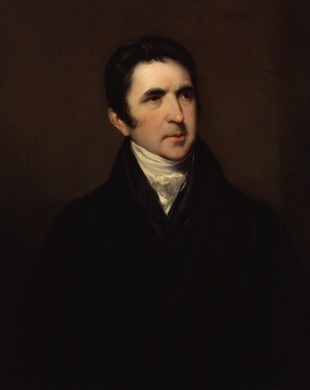
John Barrow. Attributed to John Jackson; oil on canvas, circa 1810. A Civil Servant, Barrow held the post of Second Secretary to the Admiralty from from 5 May 1804 until 28 January 1845, except for the period between 10 February 1806 and 7 April 1807. Elected a fellow of the Royal Society in 1805, he served on its Council for the first time in 1815, at the instigation of Joseph Banks. Over the next fifteen years, he alternated his Council membership with his Admiralty colleague John Wilson Croker. © National Portrait Gallery, London. Reproduced under a Creative Commons Attribution-NonCommercial-NoDerivs 3.0 Unported (CC BY-NC-ND 3.0) licence (see below)
The following day (6 April 1826), Wollaston took Pond’s letter along to a meeting of Council at which Pond wasn’t presents, but at which Barrow was (having takenover from Croker). There it was read and then put to one side for discussion at the next meeting. (RGO6/22/174–6). This took place on 13 April (Pond but not Barrow being present). At this point, there is another omission in the contents of RGO6/22. The extracted minutes begin:
‘Ordered that a subcommitte be appointed for the purpose of drawing up a reply to the above letter [not present in RGO6/22] consisting of the President, Dr. Wollaston & the Secretaries’.
The copy of the reply transcribed into the minute book (RGO6/22/176–8) suggests it was written in response to a letter dated 5 April from John Barrow at the Admiralty that appears to have enquired about the state of play with regards to the appointment of the assistants. In a slightly grovelling way, the letter, which appears to have been written on 17 April went through all the steps that had been taken since the offer of a new class of Assistant Post was made by the Admiralty back in March 1823 and saying since neither they nor the Admiralty had come up with a suitable candidate to take up the offer, they had 'concurred with the Astronomer Royal in advising Mr Taylor be retained as an experienced & useful assistant'. There then followed a paragraph that appears to be an attempt to deflect any blame for what had happened from the Royal Society onto the Visitors:
‘It may perhaps be right that I should remind you that an application which you state Mr Taylor to have made to their Lordships about the Midsummer 1825 & any expression of approbation from the Astronomer Royal of Captn. Ronald’s assiduity which you may have received are not to be regarded as coming from the President & Council of the Royal Society but should be carefully distinguished from the acts of the Visitors’.
The letter ended by mentioning the letter written by Pond on 5 April (of which they forwarded a copy) and continued. ‘They think under the present circumstances that it will be for the interest of practical & nautical astronomy that the system which is now pursued at Greenwich should be continued particularly as they are convinced of its utility & of the very efficient industry of the present class of assistants ....’
The Admiralty was not amused by the change of view of the Council of the Royal Society with regard to a superior class of assistant as they made clear in their considered and generally polite reply ended as follows
‘Their Lordships altho’ still retaining their own impression in favour of the superior class, feel themselves bound to defer to that opinion but in pursuance of the principle original declared & subsequently sanctioned by His Majesty’s Order in Council. The assistants are to continue on their present rates of salary no increase to which my Lords have any authority nor under all the circumstances any disposition to sanction’. (RGO6/22/178).
Despite this very clear statement about the scale of salaries, at the meeting of Council on 25 June 1827 (Pond but not Barrow present), Council resolved to recommended that the salary of Belville be increased from £140 to £200, that of T.G. Taylor and Richardson be increased from £110 to £150 and that the two supernumeraries (Rogerson and Ellis) be made permanent and paid a salary of not less than £150 each (RGO6/22/184).
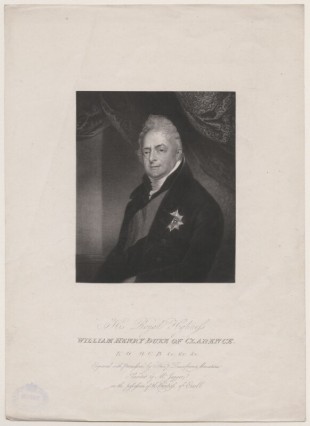
William Henry, Duke of Clarence. Mezzotint by Henry Edward Dawe after Charles Jagger, circa 1830s. © National Portrait Gallery, London. Reproduced under a Creative Commons Attribution-NonCommercial-NoDerivs 3.0 Unported (CC BY-NC-ND 3.0) licence (see below)
Not prepared to take no for an answer, the assistants wrote a memorial about their ‘inadequate remuneration’ which was presented to Council (Pond, but not Barrow present) on 26 June 1828 who then resolved:
‘That the memorial be transmitted to the Admiralty by the President accompanied by a strong expression of the opinion which the Council entertain if the justice and reasonableness of the claims of the assistants of the Observatory to increased remunerations, to an amount of at least £50 per annum beyond what they are now entitled to by the present regulations & which claims they have for the last years continually pressed upon the attention of Government’ (RGO6/22/189).
Unusually, there was a delay in sending the letter (which was seemingly sent on 10 July). The Admiralty referred the matter to the treasury, sending a copy of the treasury’s reply together with a covering letter to the President of 15 August 1828. They were shared with Council at their meeting of 13 November (Pond and Barrow not present), when both were read and transcribed into the minutes. (RGO6/22/190). In short, once again, the answer was that no increase would be authorised (the Lord Commissioners of the Treasury having stated that they did not think it advisable to sanction an increase).
In a critical rant about the state of the Nautical Almanac written on 10 December 1828 and published in the Morning Chronicle on 12 December, the irascible James South wrote:
‘That the British Government ... keeps the four junior Assistants of the Royal Observatory, notwithstanding repeated remonstrance’s from the visitors of the Royal Observatory, and the President and Council of the Royal Society in a state approaching to starvation.’
This unhelpful washing of the linen in public did nothing to increase the salaries of the Assistants!
Although there is no mention of the fact in the Minutes, it would appear that the two supernumeraries (Rogerson and Ellis) became established members of staff at the start of 1831 when their new positions (as ‘Extra Assistants’) appear in the Navy Estimates for the first time. (ADM181/40/11).
In 1831, the New Board of Visitors met for the first time. Under the new system, the Astronomer Royal was not a Board member, so Pond was excluded from meetings unless specifically invited. At their seventh meeting, which was held on 4 June (the day of the annual Visitation), Pond was asked a number of questions by the Visitors (ADM190/4/62). Given his previous stance on the assistants, some of his answers must have raised a few eye-brows. They included the following:
‘That in any future arrangement the assistants should be formed into three classes, consisting of one of the first class, two of the second class, three of the third class ... That the first assistant should commence with a salary of £300, to be gradually increased to £500, per annum. That, the two assistants of the second class, should be well skilled in computations, and the necessary reductions. Their salaries to commence with £200, and rise to £300 per annum, but not to exceed that sum. That the third class of assistants commence with £120, and rise to £200 per annum. That in addition to the above salaries, they be lodged in the Observatory. ... that provided the above arrangements are carried into effect, no assistant should be allowed, on any account whatever, to undertake any other business than that connected with the immediate duties of the observatory’.
What is striking throughout the whole saga surrounding the appointment of the Assistants, is the abdication of responsibility and a failure of leadership on the part of Pond. Seemingly not in a position to negotiate directly with the Admiralty on the matter, (which is what broadly what seems to have subsequently happened under Airy’s leadership), Pond’s negotiations all took place indirectly though the President and Council of the Royal Society which included, as we have seen, one or other of the two secretaries of the Admiralty – the very same people, who when wearing their Admiralty hat, were largely responsible for deciding the outcome. The end result was that the waters became muddied and nobody took ownership of control of the process in order to see it to a timely conclusion. In these circumstances, it is perhaps no surprise that the negotiations dragged on for four years and were carried on without proper consideration as to how they might be put into effect. It must have been highly demoralising for the Assistants affected by the dithering, in particular Taylor, Rogerson and Ellis. To put oneself in Taylor’s shoes; how might we feel if our job was suddenly advertised while we were still in post, or if we were offered early retirement only to have the offer effectively withdrawn? One suspects that most of us would not be overly happy. Nor one suspects was Taylor. Of the six assistants that Pond appointed, all, with the possible exception of Simms (who was appointed in 1830), were initially taken on without proper authorisation from the Admiralty.
And who was to blame for the way things progressed? Was it Pond who could have fought his corner openly but chose instead to fight it by stealth? The Royal Society, who arguably overstepped their role as Visitors since there is nothing in the Royal Warrants to give them any role in the matters of staffing? The Admiralty and the Royal Society together for bulldozing the Astronomer Royal rather than properly engage him in discussion? Or should the blame instead be placed on the shoulders of the deceased Joseph Banks and the system of patronage that he promoted? The saga is most often remembered for Pond’s reference to ‘obedient drudges’. Perhaps instead, it should be remembered for both Pond’s abdication of responsibility in order to avoid conflict and as an unfortunate legacy of the failed Banksian regime. In the end, no assistants of a superior class were appointed while Pond remained Astronomer Royal.
When Airy became Astronomer Royal in 1835, the six assistants were no longer referred to as First, Second and Extra Assistants, but as First, Second, Third, Fourth, Fifth and Sixth Assistant, the ranking (but not the pay) of all but the First Assistant being determined by length of service. Taylor was retired on a pension (RGO6/1/177) and Robert Main, a high achieving mathematician from Cambridge, was appointed to replace him as First Assistant on a salary of £300 a year - the same salary that had been potentially on offer to a suitable applicant back in 1823. There was one key difference though. By order of council dated 30 September 1835 (two days after Main was appointed), limits were put on salaries as follows: First assistant, £400 (down from the £500 envisaged in 1823): Second and Third £150, Fourth, Fifth and Sixth £100, each with a moderate allowance for house rent. (RGO6/72/137)
On 17 November 1835, the awarding of any number of triennial increments to the Belville and Richardson came to an abrupt halt when the Admiralty decided to cap their salaries. The decision appears to have come from the Admiralty rather than Airy (RGO6/72/3), who was told that the Second Assistant Belville’s salary was to stop at £180 (which it was already at) and that that of the Third (Richardson) was to stop at £150 (it rose to this level in 1838). These two assistants were told of the new arrangements by Airy in a letter. Belville did not challenge this at the time, but did enquire in 1838 as to why the latest increment had not been paid. Airy wrote to the Admiralty on his behalf, but they were adamant that no further increment should be paid (RGO6/72/93-95). Airy intervened again on both Belville’s and Richardson’s behalf in 1841 (RGO6/72/147), but was again rebuffed. Following a further appeal in 1843 by Belville to Airy, and then Airy to the Admiralty, increments were reinstated for both assistants (RGO6/72/195&248). This involved paying a double increment as so many years had lapsed. Rather curiously though, there is no correspondence in the archives from Richardson on this matter. Without dwelling too much here on what happened to Pond's assistants under Airy, it is worth pointing out that when Rogerson died in 1853, his salary was £100 a year, the same as had been in 1825 when he was appointed. Rogerson was the only one of Pond's assistants never to receive a pay rise.
Click here to read more about the salary reviews and pay structures that were in place at the Observatory from 1836–1871.
Copies of the following documents could not be found in the archives
1825 June 17: Visitation minutes
1826 April 5: Letter to President of RS from Admiralty
1826 June 2: Visitation minutes
The Ponds and the Taylors – one big happy family?
On the 16 April 1807, John Pond married Anne Gordon Bradley (1789–1871), daughter of Thomas Bradley (1751?-1813) and Sarah née Gordon. The wedding took place at St Martin-in-the-Fields, Westminster. At the time, Pond was 39 and Anne was just 17 (a marriage licence was issued on 15 April). As far as can be ascertained the couple did not have any children.
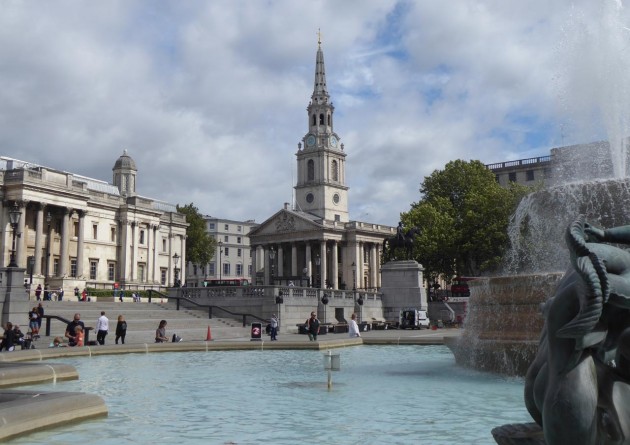
The church of St Martin in-the-Fields. Trafalgar Square (in the foreground) was laid out in the 1820s and levelled in the 1840s. The National Gallery (constructed 1832–8) can be seen to the left. Photo: August 2020
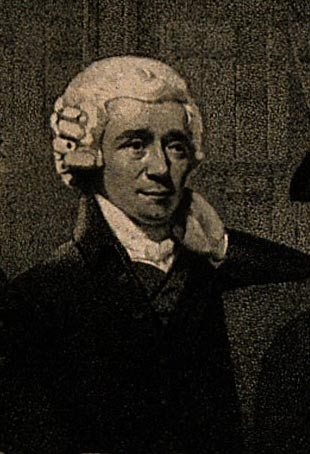
Pond's father-in-law, Thomas Bradley. Detail from The inaugural meeting of the Medical Society of London in the Society's Council Chamber, 1788. Engraving by N.C. Branwhite, 1801, after S. Medley, 1800. Copyrighted work reproduced courtesy of Wellcome Library, London under the terms of a Creative Commons Attribution only licence CC BY 4.0 (see below)
‘His retired habits in early life did not fit him for the great stage of the Metropolis, to which he proved unequal, rather from diffidence than from want of professional knowledge. He was in truth, more read in books than in men, and therefore disdained to pursue the arts which ensure success; and as he always hesitated like a genuine mathematician, to draw conclusions from uncertain premises, he appeared to less advantage in the sick chamber, than bolder and less conscientious practitioners who possessed but a small portion of his knowledge.’
It seems that Pond and his father-in-law both had quite a lot in common!
In March 1802, Thomas Taylor (1772–1843), married Susanna Glanville (1774?–1820) in Devon. In 1807, he was appointed by Maskelyne as his Assistant at Greenwich in succession to Thomas Firminger. He remained in post until 1835.
Taylor’s will shows that he had four children who survived him. They were Susanna Taylor (1803– ) ,who married William Richards; Thomas Glanville Taylor (1804–1848); Henry Taylor (1810–1874) and Harriett Taylor (1813–1869), who appears to have been unmarried at the time of her father’s death.
In 1822, Thomas Glanville Taylor was taken on by Pond as one of two new assistants. He was appointed Director of the East India Company’s Observatory in Madras in 1830 and elected a fellow of the Royal Society in 1842.
Born in 1810/11, six years after his brother Thomas, Henry Taylor is recorded as having gone to the University of Oxford to study. His entry in volume 4 of Alumni Oxonienses (which is said to have been compiled from the University’s matriculation register) records that he matriculated at All Soul’s College at the age of 17 on 21 April 1828. Other sources have him supposedly attending St. Mary Hall (Essex Standard, 2 December 1839), and Magdalen Hall. He is said to have graduated with the degree of Bachelor of Civil Law (B.C.L.) in 1832. At about the age of 21, Henry got married, the wedding taking place at St James’s Piccadilly on 28 July 1832. Intriguingly, his bride, who was ten years his senior, was Mary Ayrton Ellen Bradley, sister of Anne Pond, the wife of the Astronomer Royal. In other words, John Pond’s sister-in-law was also the daughter-in-law of Thomas Taylor. When Henry’s first child Mary Gordon Taylor was baptised at St Mary's Lewisham on 24 November 1833, his address was given as Dartmouth Cottage. By 1836, Henry must have taken Holy Orders as after the death of John Pond in 1836, he swore the truth (as the Reverend Henry Taylor) of an affidavit stating that Pond’s will appeared genuine (transcript below). Henry became curate of Christ Church Marylebone at the start of 1839. In December 1839, he was appointed incumbent of All Saints’ Church, Stepney, and it was there on 5 January 1840 that he performed the baptism of his second(?) child, Thomas Henry Sanderson Taylor. The notice of his appointment at Stepney in the Gentleman’s Magazine, also stated that he was one of the domestic chaplains of the Earl of Powis, a position that he held throughout his life. This particular appointment probably came about because the Earls of Powis were descendents of Margaret Maskelyne, wife of Clive of India and crucially, sister of Nevil Maskelyne, his father’s first employer at Greenwich. An announcement of the appointment was made in July/August 1839.In 1840, Thomas Glanville Taylor was back in England on leave from Madras. The following year, Henry Taylor was appointed Chaplain to the East India Company. When Thomas Glanville Taylor returned to India at the end of 1841, Henry travelled with him. Henry remained in the service of the East India Company and later the Colonial Office (after the reorganisation of 1858) until1860. The 1851 census shows him back in England (presumably on leave), and apparently living on the Isle of Wight with both his wife and with Anne Pond. Further confirmation that he was on the Isle of Wight at this time comes from a press report in the 29 March 1851 edition of the Southampton Herald:
‘Propagation of the Gospel.– The Rev. Henry Taylor B.C.L., chaplain to the Hon. East India Service at Madras preached and excellent and impressive sermon at Trinity Church Ryde, on Sunday morning the 16th inst; ...’
When the 1861 census was taken, Ann[e] was staying with her friend Harriet Elizabeth Russell, (née Woodhouse), the widow of Major General Lechmere Coore Graves Russell, at Ashford Hall, Ashford Bowder, Shropshire. Russell’s husband served in India so that may be where the two women first met.
The 1871 census shows Henry and Mary Taylor together with Anne Pond and two servants as the sole occupants of South Lodge in Broadstairs, a house that the electoral register shows had been in Taylor’s occupation since at least 1867. When Anne Pond and the Taylors first came to Broadstairs in unknown. Nor is it known if they came together or if Anne was already living in Broadstairs. Guildford Barker Richardson (1817–1895), whose reminiscences of old Greenwich were republished in W Howarth's Greenwich Past and Present (1885), describes meeting Anne Pond in Broadstairs (p.140) and confirms that one sister moved in with the other, but is unclear as to which one moved in with which. The probate records show that both Anne Pond and Henry Taylor died at South Lodge; Anne on 17 April 1871 and Henry three years later on 26 June 1874. Mary Taylor died in the same parish on 23 February 1878. It is not presently known if Anne Pond or his wife and children accompanied Henry Taylor to Madras. Neither child is mentioned as living with him in the 1851 census suggesting that they both may have died young.
The question arises as to how it was that the Ponds and the Taylors became so close and what bearing did this have on the working relationship between them?
When Thomas Taylor was taken on by Maskelyne in 1807, he was already married with two Children (Susanna and Thomas G). Henry was born a few months before Pond arrived at the Observatory in 1811 as Astronomer Royal. At that time, Thomas Taylor was the only Assistant. As mentioned above, although accommodation was provided for him at the Observatory, it would appear that the rest of his family resided not there, but down the hill in Greenwich (UKHO LP39/209). The new apartment rooms completed in 1815 seem to have been initially shared between Taylor and the Second Assistant, Belville (RGO6/44/9), however a plan from 1831, indicates that by then, one of the rooms had been divided and that the whole suite of about 400 square feet was in use by Taylor (RGO6/45).
Taylor’s wife Susanna died in 1820, leaving him with four children between the age of seven and seventeen to bring up on his own. Given the hours he seems to have been required to work, it seems likely that the whole Taoylor family moved into the Observatory, a view supported in a note about the assistants that Pond wrote for Airy in 1835 that states that ‘his [Taylor’s] eldest son was brought up at the Observatory and is now astronomer at Calcutta – to the East India Company’ (RGO6/72/233). It seems highly likely that from an early stage that the Ponds took an interest in the welfare of the children and also their education. How else would Henry have got to meet Mary Bradley let alone to marry her?
Although Henry Taylor was never employed as a member of the Observatory staff, he made a significant number of the published observations with the transit instrument in 1830 and 1831 and also several occultations. He was conversant with the process of reducing the observations for publication as both he and his brother were involved in the production of Groombridge's Catalogue of Circumpolar Stars, the production of which was being funded by the Board of Longitude. Of the two brothers, it was initially only Thomas Glanville Taylor who was involved. After his departure for India, it became necessary to appoint a new superintendant of the computations;
‘and Pond, apparently in his official character as Astronomer Royal, nominated Mr. Henry Taylor, [who was then aged just 20], brother of Mr. T.G. Taylor above mentioned. The calculations it appears, were first put into his hands in about June, 1830 [around the time he made his first transit observation]. Computers were employed by Mr. H. Taylor; the reductions were completed; the Catalogue in every respect prepared for press; and, after the necessary sanction from the Board of Admiralty, the Catalogue and Introduction were completely printed [in 1832?] at the expense of the Government.’
To cut a long story short, before the volume was actually published, aspects of the work were found to be erroneous. According to Airy, the errors were of such a nature that no system of cancelling or errata could remove them and it was decided that the work ought to be suppressed. Following a significant amount of extra work by Airy and others (Sheepshanks in particular), the volume as edited by Airy was eventually published in 1838. An account of the Taylors’ involvement in its production (from which the above quote is taken) was given in the Preface to the Catalogue. It is worth spending a few minutes reading it. The account given in the History of the Royal Astronomical Society, 1820–1920 differs slightly, and is reproduced below:
‘After 1830 June this work was done by a Mr. Henry Taylor, a brother of the well-known astronomer at Madras, and a son of Pond’s First Assistant. He felt aggrieved at the account given of the work in the obituary notice of Groombridge in the Annual Report of 1833 (written by Sheepshanks), though his name was not mentioned in it. His complaint, that statements in the obituary were “totally inaccurate and essentially wrong,” was investigated by a Committee, who reported to the Council that his charge was “ frivolous and unfounded “ ; which report the Council adopted. Upon which Mr. Taylor, deeply offended, resigned his fellowship of the Society. But he would have been much wiser if he had let Sheepshanks alone. For that indefatigable worker, who was now put on his mettle, at once proceeded to make a thorough examination of the reductions and of the printed catalogue, which only wanted the introduction (which was in type) to be printed off in order to be published. This examination led him to find so many errors, that he pronounced the catalogue unfit for publication. At the request of the Admiralty, the matter was next investigated by Airy and Baily, who decided that the errors were of such a nature that no system of cancelling or list of errata could remove them; so that the catalogue ought to be suppressed. Eventually a new catalogue was prepared under the superintendence of Airy, the main bulk of the reductions being found to have been well done; and this was published in 1838.’
When Airy arrived at Greenwich as the new Astronomer Royal, he seems to have found no formal records relating to the structural changes that happened during Pond’s tenure (funding, reconstituted board of Visitors, minutes of the Visitors etc.). Nor could he find any record of how the site and instruments had evolved since Flamsteed's time. Time being of the essence, in 1837, Airy wrote to Anne Pond who roped in Maskelyne's daughter Margaret and Thomas Taylor to help fill in the details.
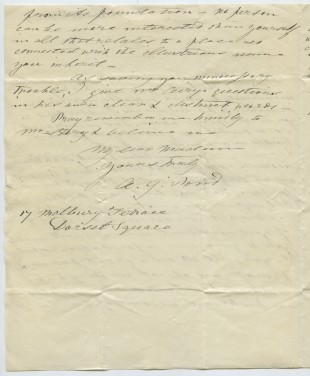
The second page of a letter from Anne Pond to Margaret Maskelyne . It was written on 12 June 1839 at 17 Melbury Terrace. Reproduced under the terms of a Creative Commons Attribution-Non-Commercial 3.0 Unported License (CC BY-NC 3.0) courtesy of Cambridge Digital Library (see below)
A second letter to Airy (RGO6/44/20), dated 17 June 1839, was sent from 17 Melbury Terrace (Marylebone), the same address from where Thomas Taylor had written to Airy the previous week (RGO6/44/17 – exact date needs confirmation) and also the address given on his last will and testament which was signed in October 1839. It is also the address given for Henry Taylor when the birth of his son (Thomas) was announced in the January 1840 edition of The British Magazine and Monthly Register of Religious and Ecclesiastical Information.
Intriguingly, in his book The Madhouse System which was published in 1841, Richard Paternoster states (p.72) that Thomas Taylor (who was described as John Taylor, deputy-astronomer of Greenwich Observatory) had been confined to Finch's Madhouse (The Kensington House Asylum) ‘by his son the Rev. Mr. Taylor of 17, Melbury Terrace, Dorset Square’, but since removed. Regrettably, no further details were given except that he was there in 1838 at the same time as Paternoster. Taylor must however have been readmitted to Kensington House as that is the address given by the General Register Office on a certified copy of an entry of death. It records that Taylor died of inflammation on 23 January 1843.
On the face of it then, it appears that by 1837 if not before, Anne Pond had moved in with Henry and Mary Taylor in Elm Tree Road and that the three of them subsequently moved in with Thomas Taylor (and Harriett?) at Melbury Terrace. Court records held by the National Archive (HO 17/47/144) suggest that he (Thomas) had been living there since 1835.
As well as getting information via Anne Pond, Airy also had sight of a private journal kept by John Belville for the years 1811–1825, from which he made copious notes. The undated notes made from the journal (but not the journal itself) are preserved in the Observatory archives (RGO6/1).
For reasons unknown, in March 1847, Belville gave Airy sight of a bundle of private letters Pond had written to him from Hastings whilst on sick leave and recuperating. A page and a half of notes consisting of 41 lines of text and about 300-400 words that Airy made from them are also preserved in the Observatory archives (RGO6/1/58) under the heading: Remarks on a bundle of letters addressed by Mr. Pond to Mr. Henry during his long absence from the Observatory in 1831. There was also an accompanying letter from Belville (RGO6/1/57).
Airy’s notes give the impression that there were eleven letters from Pond in total, the first having been written on 27 July 1831 and the last four months later on Tuesday 29 November when Pond said he hoped to be back home by the following Monday or Tuesday. Airy transcribed sections from eight of the letters. Together, they show that Pond was in a seriously bad way both physically and mentally and that at one point, he feared that he would never return to Greenwich.
Also in Hastings in 1831, was Thomas Campbell (the Scottish poet who in 1805 had moved to a house in Sydenham, some four miles from the Observatory at Greenwich). In a letter dated 22 September to his sister in Edinburgh that was later published (Life and Letters of Thomas Campbell) he wrote of his encounter with the Ponds:
‘It seems to me, however, at this period – like a gift from Providence – to have formed a most interesting and instructive acquaintance with Mr. Pond, the Astronomer Royal, who is here with his accomplished and amiable wife. The philosopher seems really to like the poet – so does the philosopher's wife; and I am sure there is no love lost. I have spent every evening with them since their arrival in Hastings. They have brought a considerably magnifying telescope with them, through which we look at the planets; and Mr. Pond’s remarks make this amusement very interesting. I had lately been dabbling in the astronomical relics of the Greek Alexandrian school, and had the idea of embodying my notes on ancient geography into a regular history, when this ‘Life of Mrs. Siddons’ suspended my attention. But I have of late been so interested in the subject, that I revised my mathematics, the better to understand the histories of ancient science given by Ideler and Delambre. Mr. Pond’s conversation has been, therefore, eagerly sought by me, – and he is most affably communicative.
We have just been gazing on Jupiter and his moons, through a glass that makes Jove appear as large as the sun’s disk, and his satellites like ordinary stars! The moon appears through it as large as a church. His opinion of her ladyship is, that she is not inhabited – there being no atmosphere – and the whole region, probably, only ice and snow. Strange enough that a body, which creates such lively crotchets in so many human brains, should itself be cold and lifeless! Mrs. Pond – and her opinion is always worth hearing – thinks it diffuses positive cold; and I am sure I have sometimes thought the night colder for moonshine. This is the second time that I have spent many delightful hours with a great astronomer [The first was with Herschel].
Mrs. Pond is among the most agreeable and enlightened women I ever met with. It is now many and many a day since I first saw her, when she was walking – shortly after their marriage – a young, fair, graceful woman, arm and arm with her very plain and elderly husband. She was pointed out to me by M. There was an epigram in the newspaper about them. Mr. Pond had published some remarks on the planet. ‘Venus,’ – and the wit asked him, ‘Why he troubled himself about Venus in the skies, when he had got Venus beside him on earth?’ She is now no Venus – but winningly, unaffectedly courteous in her manners, – deep read in both science and literature, and yet as humble as a modest child. I really love this worthy pair; and it grieves me that this is, probably, the last day I may ever enjoy their society, for any definite time.’
Apart from anything else, this account gives a rare insight into the character and personality Anne Pond – so much so, that following her death in 1871 it was published under the following heading: ‘In memory of Anne Gordon Pond, who died April 17, 1871, aged 82 years’, a copy of which was discovered by Daniel Belteki in RGO6/382 (a file of miscellaneous correspondence and obituaries).
In the absence of the originals letters from Pond to Belville, it is not possible to tell either the original context of the copied extracts nor why Airy recorded these sections and not others. Two extracts (about 20% of the text that was copied) make reference to the Taylors. Taken at face value, they are exceedingly damning.
Letter 1. ~ 27 July 1831
‘Rely on it that whatever becomes of me you will be comfortably provided for at the Observatory with proper diligence. I have been ill used by the Taylor family, but do not notice this or pretend to know it’
Letter 2. ~ 31 July 1831
‘I hope to have no intercourse any more with the Taylor family, but do not pretend to know this. Nothing can equal the ingratitude of their conduct.’
But what was it that the Taylor family was supposed to have done to bring on this outpouring at this time? The answer is not at all clear. And what did Pond mean by ‘but do not notice this or pretend to know it’ and ‘but do not pretend to know this’. Was it that he, Pond, was pretending not to know it, or was it an instruction to Belville not to share with the Taylors his (Pond’s) thoughts on them? And if, as seems more likely, it was the second of these, it suggests a somewhat divided workforce.
At the time when Pond was writing, Thomas Glanville Taylor was off the scene having departed for Madras more that a year before, and the Groombridge / Henry Taylor incident was still more than a year away as was Henry’s marriage to Mary Bradley.
1831 was certainly a stressful year for Pond. The newly constituted Board of Visitors was not slow in getting off the mark, holding seven lengthy meetings between 19 January and 13 June. Of these, the minutes imply that the only meetings that Pond is known to have been summoned to attended were the second meeting of the Board (which was held on 21 January) was the Visitation which was held on 4 June (ADM190/7/1). In his Autobiography, Airy says of what is presumed to have been the January meeting:
‘Mr Pond, the Astronomer Royal, was in a rather feeble state, and South seemed determined to bear him down: Sheepshanks and I did our best to support him.’
In a long letter to John Quincy Adams of the Harvard Observatory in 1839, Airy made a similar comment:
‘On the first appointment of the new Board there was exhibited in it a rather vexatious spirit towards the then Astronomer Royal (Mr. Pond). Since my appointment as Astronomer Royal, the Board has scarcely interfered in anything, except in matters which I have myself suggested.’
It is difficult to imagine how stressful things must have been for Pond moving from a system where for twenty years, as a member of Council of the Royal Society, he had been able to attend all the meetings at which the Observatory business was discussed to one at which he had no automatic right to attend.
Most of the Board’s discussions in1831 related to printing the observations in a revised format and also re-separating the posts of Astronomer Royal and Superintendent of the Nautical Almanac. Although the latter would potentially reduce Pond’s workload, the former increased it with immediate effect. At the Visitation, Pond made a lengthy statement of which the following is an extract from the minutes:
‘... only one assistant is lodged at the observatory, and that only on sufferance, and that it is his [Pond’s] opinion that the Royal Observatory never can be fully effective until all the assistants are enabled to reside in it or in the immediate vicinity of the same. ... ... That, the Astronomer Royal is satisfied with his present power over the assistants, but thinks that more might be desirable ... The Astronomer Royal also stated that it is his decided opinion, that provided the above arrangements [about pay and housing] are carried into effect, no assistant should be allowed, on any account whatever to undertake any other business than that connected with the immediate duties of the observatory [see below]’ (ADM4/62)
The reference to the assistant lodged at the Observatory is presumed to be a reference to Taylor. However, the reference to him residing there ‘under sufferance’ can be read in at least three different ways.
1. Taylor and Pond’s relationship had broken down.
2. After nearly 25 years of doing so, Taylor was fed up with both working and living under the watchful eye of the Astronomer Royal in the same immediate environment.
3. That the accommodation provided at the Observatory was too small and too basic especially in comparison to the off-site accommodation of Belville and Richardson that was being paid for by the Admiralty.
Nothing is known about how or where Pond met his future wife. Nor is anything known about their relationship. Given that he made no provision for her in his will (transcribed below), and that she apparently got on well with her sister, brother-in-law and Thomas Taylor, one does have to wonder just what it was that had upset Pond so much about the Taylors.
The Ponds and the Bradleys
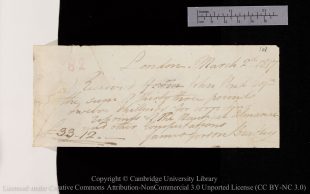
Receipt, dated 2 March 1817, for £33. 12s. paid by John Pond on behalf of the Board of Longitude to James Gordon Bradley (RGO14/19/103). Reproduced under the terms of a Creative Commons Attribution-Non-Commercial 3.0 Unported License (CC BY-NC 3.0) courtesy of Cambridge Digital Library (see below)
James and Thomas were both baptised on 24 November 1799 at St Margaret’s Church, Westminster. Their parents are recorded as Thomas and Sarah Bradley, the same as the parents of Anne and Mary. James was born on 16 January 1795 and Thomas on 23 October 1796. Not only did both men do work for Pond, but James’s middle name, Gordon, is the same as that of Anne. This all suggests most strongly that Anne and Mary were their sisters and that Pond was their brother-in-law.
Thomas senior’s obituary states that he died in 1813 aged 62 in St George’s Fields in Southwark. This may have been a kind way of saying that he died in the King’s Bench Prison which was located in their eastern corner as his ODNB entry states:
‘Marianne Ayrton recorded in her journal that ‘Poor Dr Bradley died in the King’s Bench’, a debtors’ prison (26 Nov. 1813, BL Add ms 60372, fo. 32). He was buried at St Margaret, Westminster, on 27 November 1813.’
At the time of their father’s death, Mary was about 12, Thomas was 17 and James was 18 years old. This raises the possibility that Mary, James and Thomas all came to live at the Observatory with their sister. If she was still alive, it is possible that their mother came as well, but no evidence has been found for either her or any other siblings being there.
On 14 April 1810, at the age of fifteen, James was admitted to draw in the Townley Gallery at the British Museum. Although records from the 1840s record him as an artist and drawing teacher, he was given temporary work correcting reprints of the Nautical Almanac in 1817 (Surviving records show that he was paid a total of £53. 12s (RGO14/16/380)). He also worked at the Observatory on at least two occasions. The first was in 1820 when he was paid £15. 15.s for correcting Greenwich Observations (RGO6/22/106). The second was when he is worked for a couple of months in 1825 prior to the arrival of the two assistants William Rogerson and Thomas Ellis (RGO6/1/56). No record of any payment for this late work has been located. Generally known by his middle name (at least in later life), he appears in the Observatory records as James Gordon Bradley, Mr G Bradley and Bradley. He was declared bankrupt in 1842.
Notices relating to his bankruptcy appeared in The London Gazette and can be viewed via the links below:
16 December 1842
17 January 1843
29 December 1846
Thomas was also an artist and later an engraver as well. He was employed by Pond in 1813 to draw the new mural circle for publication in the first volume of his observations which came out in 1815. On this occasion, the engraving was done by James Basire, who was engraver to the Royal Society and had earlier engraved the image of the Westbury Circle (above). Four different plates were published in Greenwich Observations between 1811 and 1835. The second plate does not record either the artist or the engraver, but it is suspected that the person involved was Thomas. The third and fourth plates were both signed as being drawn and engraved by him. Although there is a record from January 1815 of Basire being paid £26. 5s for engraving work (RGO6/22/81), no record has been found for any payments to Bradley.
Plate 1. Frontispiece to volume 1 (published 1815). T. Bradley delin. Js Basire sculp.
Plate 2. From 1816 volume (published 1818). No information given as to artist or engraver
Plate 3. Fronispiece to the 1820 Volume (published 1821). T. Bradley delin & sculp
Plate 4. Frontispiece to the 1826 Volume (published 1826). T. Bradley del: and scup:
Plates 3 & 4 were republished in the 1832 volume.
It is not known where Thomas learnt his trade as an engraver, but given that he was only sixteen or seventeen years old when he drew the first of the four plates, it is not impossible that Pond paid for him to be indentured to Basire to train as an engraver. According to the Royal Museums Greenwich website, a letter from Thomas to R. H. Major tells us that ‘no likeness whatever exists of my late brother in law Mr Pond except perhaps a small silhouette in black paper but whether that remains or where it is I know not’. Unfortunately, no archival reference is given.
The working hours enigma
According to a four page document dated 20 April 1825 that was specially printed for Pond under the title A memorial relative to the appointment of new assistants at the Royal Observatory, the hours of attendance of his four assistants were as follows (RGO6/1/51&52):‘The 1st assistant [Taylor] attends from 9 A.M. to 9 P.M., with the exception of one hour, and occassionally earlier; and from one to three hours later in relieving the night assistants, in observing eclipses, and other incidental duties.
The 2nd assistant [Belville] attends from 9 A.M. to 9 P.M., with the exception of one hour, and occassionally later for eclipses, &C.
The two night assistants [Thomas Glanville Taylor & Richardson] attend from three to four hours during the day, for computations, from nine to about twelve at night, and from between three and four in the morning till about nine.’ (RGO6/1/51)
Despite the long working hours, the assistants still seemingly had time to take on other work.Thomas Glanville Taylor (as mentioned above), was involved in preparing the Groombridge Catalogue. He also did computations for the Nautical Almanac (RGO14/19/189) prior to being appointed as an assistant and is believed to have continued to do so afterwards. Likewise, Thomas Taylor senior did computations for the Nautical Almanac (at least in the time of Maskelyne) and was paid five guineas on the recommendation of the Visitors for arranging the manuscripts in the library (RGO14/16/379 & RGO6/22/76) . William Richardson was responsible for computing the data for A catalogue of 7385 stars: chiefly in the southern hemisphere, prepared from observations made ... at the observatory at Paramatta, New South Wales ... which was published for the Admiralty in 1835.
William Rogerson also found time to continue publishing editions of his Almanack, Temporis Calendarium after he was taken on in 1825. First published in 1820 (for the year 1821), the last volume to be published was in the year 1850. Likewise Simms (taken on in 1830) supplemented his income by giving lessons in navigation to officers in the merchant service, and by surveying iron steam-ships for the adjustment of their compasses. In 1834, he also published his first book: A treatise on the principal mathematical instruments employed in surveying, levelling and astronomy.
It seems that the only assistant not to have taken on extra work was Thomas Ellis.
Comments about Pond’s mathematical skills from his obituarist and George Peacock
In 1855, George Peacock (1791–1858), (Airy’s tutor at Cambridge who was appointed Lowndean Professor of Astronomy in 1837), published his book The Life of Thomas Young, in which he made the following comment about Pond (p.358). Although Peacock was appointed to the reformed Board of Visitors, in 1830, his comments appear to have been based more on the views of others rather than any direct observations of his own:
‘He was an observer of remarkable tact and delicacy, with a very clear understanding, which enabled him to reason correctly upon the general instrumental results of his observations; but his mathematical knowledge was very limited, and he was not equal to that larger and more philosophical discussion of his observations which was requisite to give them their complete astronomical interpretation.
Schumacher, in his correspondence with Dr. Young, makes frequent references to Mr. Pond’s want of sufficient theoretical and technical knowledge to enable him to treat his observations properly: such also would appear to have been the opinion of Bessel and the other astronomers of Germany. Mr. Sheepshanks, however, a most competent judge, and other English astronomers, have been accustomed to speak of him with great respect as not merely a skilful, but an eminently philosophical observer.’
His obituarist (MNRAS) said something similar, but in a rather more gentle way:
‘It has already been mentioned, that Mr. Pond’s attention to mathematics when at Cambridge was not equal to his opportunities, nor such as might have been expected from his talents and early education. This was a subject of regret to him in after life; but it must be remembered, that, at that time, mathematico-physical research was almost unknown in this country, and that the then course of reading at Cambridge (though it might and did, in Brinkley and Woodhouse, lead to better things), was not such as to give any immediate grasp upon the physical constitution of the universe. Mr. Pond had, from early youth, all the mathematics strictly necessary for a practical astronomer, and was perfectly well acquainted with plane astronomy, in distinction to physical. This was quite sufficient for the branch of astronomy to which he particularly devoted himself, viz. the determination of the places, corrections, motions, &c. of the fixed stars, – the basis on which all ulterior progress must be founded. He was perfectly free from that narrowness of comprehension which too often marks the dexterous manipulator. He always felt and expressed the highest respect for those who were to take up the subject where he laid it down, and were destined to pierce into the future by the knowledge which he could afford them of the past.’
Pond’s comments on of his Assistants, the Brisbane and Groombridge catalogues and Airy’s accusations against Thomas Taylor and William Richardson
Before he resigned in 1835, Pond provided Airy with a spreadsheet titled: Statement respecting the assistants at the Royal Observatory (RGO6/72/223&226). The eight columns are headed: Name, Age, Length of Service, Salary, Other Emoluments, Total of Salary & Emoluments, Duties, and Remarks. The remarks column occupies just under half the width of the table and typically contains about five lines of text on each assistant, brief extracts from which are reproduced below:
Thomas Taylor
‘... he has been a most faithful servant. He may now be considered as quite superannuated; his sight is imperfect; he has grown petulant and has latterly taken to drinking’
John Henry [Belville]
‘He is steady tho’ not clever – is a good computer; but when much exertion is required he requires exciting’
William Richardson
‘He is a first rate observer with the Circle, and he keeps the Circle computations in a very masterly manner – His ability as an observer is shown by the observations made with the circle on the star γ Draconis, in the paper of Mr. Pond. ... He is a very able clear headed man and rather above his work and salary – Accordingly he has been allowed to undertake computation for others; for instance those required for the catalogue of Sir Thos Brisbane – and some for the astronomical society by these means he has improved his salary – He gave instructions to the assistant employed by Mr. Airy at Cambridge [Glaisher] to fit him for that situation.’
Thomas Ellis:
‘He is a very useful, well behaved respectable man’
William Rogerson:
‘very well behaved, honest and trustworthy; though less able than Mr. Ellis’
Frederick Simms:
‘has been very able and diligent ... But in consequence of his having committed a great irregularity regarding the rates of chronometers [unspecified], it is expected he will retire’
A proposal to reduce Brisbane’s observations (made at the Paramatta Observatory in Australia) was first mooted by the President and Council of the Royal Society. The proposal (together with one for reducing the observations of the Sun Moon and Planets during the past 10 to 12 years) was discussed at the meeting of the Board of Longitude held on 7 February 1828 (at which Airy was present). The Board concurred with the proposal and asked Pond to give directions for the computation of the Greenwich Observations and the three Resident Commissioners (Kater, Colby and John Herschel) ‘to consider the most effectual means of effecting the reductions of those of Sir Thomas Brisbane’ (RGO14/8/52). The Board’s secretary then sent a letter to the Royal Society which was read at the meeting of Council held on 12 February confirming that instructions had been given for turning the proposals into effect (RGO6/24/187). When the Board was dissolved later that year, the three Resident Commissioners were replaced by three scientific advisers, one of whom was Young.There are several letters in the Board of Longitude files written between 1822 and 1829 that relate to the Brisbane reductions (RGO14/48/216-234). They include one from Herschel, dated 8 Jan 1829, endorsing William Richardson, who the year before had published his paper on the Constant of the Aberation of Light (for which he was awarded the Gold Medal of the (Royal) Astronomical Society in 1830), as the person to be responsible. Approval for the work to proceed was granted by the Admiralty on 20 February and on the strength of this, Young appointed Richardson to superintend the reductions. How much Richardson was paid for his external duties is unclear. His estimate (dated 24 February 1829 and sent to Thomas Young) for completing the Paramatta Catalogue was £1020 (by contrast, his salary at that time was just £120 a year) and included an unspecified amount for him to employ the services of two computers (RGO14/48/230-231). Of these he wrote:
‘Although I do not doubt my general accuracy in computing, I shall employ as many means of checking and preventing systematical errors, and where I should have reason to apprehend any errors either in the computations or in the original observations I did intend to employ the two junior assistants whome I recommended here [the two assistnats Rogerson and Ellis, who were taken on by Pond on Richardson's recommentation] to xxxall [illegible] my computations, as being convenient and close at hand if you should have no objections to this, and for their services in this respect I would reward them.’
Likewise, the file contains two letters regarding the reductions of Groombridge’s observations, with estimates for carrying out the work that still needed to be done, that were sent to Young by Thomas Glanville Taylor. (RGO14/48/234-6). From these, it would appear that Taylor had been assisting Groombridge with this work for some time and that the work was now entirely in his hands. In the first of the letters he wrote:
‘At the prices I have hitherto been paid, the expense of finishing the Catalogue which will contain about 4,500 Stars allowing for two computers &c is about £450 certainly not more.’
When Thomas Glanville Taylor was appointed Director of the East India Company’s Observatory in Madras in 1830, the superintendence (as mentioned above) passed to his brother Henry Taylor.
When first sounded out about the post of Astronomer Royal in 1834 (see below), Airy indicated that he would like Taylor to be removed from his post (RGO6/1/145). In the letter dated 15 June 1835 and written in confidence to Lord Auckland (First Lord of the Admiralty) before finally accepting the post, he listed the changes he would want to make at the Observatory (RGO6/1/158). His list began as follows:
‘The first, which I consider absolutely necessary, is the removal of the present first assistant Mr. Taylor. He is a drunkard, he has lost his authority over the other assistants by having recourse to them (as I believe) for the assistance of his son Henry Taylor in a scandalous business, and he is under the accusation (printed as I have heard, in some periodical) of receiving bribes from chronometer makers.’
Whilst Pond was aware of the drink problem, he didn't warn Airy of anything relating to the other accusations (which are unsubstantiated). The Henry Taylor business is a reference to the Groombridge Catalogue mentioned above of which a fuller explanation of is given in the paragraphs immediately below.
Airy also made chares against Richardson. Like the charges against Taylor, they were made while he was negotiating the terms on which he would take up the post of Astronomer Royal. The scandal relating to Henry Taylor's superintendence of the Groombridge catalogue was seemingly more serious than anything that Airy or anyone else was prepared to put into print. The earliest inkling that something was amiss comes in a comment made by James South in his reply to a letter (dated 1 July 1834) from Francis Beaufort about a pension for Pond (UKHO LP1857 52/S). South was most scathing about Pond writing:
‘The Observatory at Greenwich during his AstronomerRoyal-ship has been an object of pity – and but for the prop it has had in the person and acquirements of one of the Assistants would have been one of despised contempt –
You know, how at the instigation of a Reverend Slanderer [Richard Sheepshanks] that assistant [Richardson] has been recently treated by the Astronomer Royal in his Official Capacity – You are not ignorant of the Correspondence which resulted from it – nor can you have forgotten, having given me your positive assurance that if I transmitted that Correspondence to the Admiralty as I threatened to do, and which yourself acknowledged Mr. Pond would deserve if he did not make the reparation he was called upon for, the Lords Commissioners of the Admirably instead of giving him his whole salary (which you were then endeavouring to pursue for him in case of retirement), would not give him a single shilling – ’
Sheepshanks and South were sworn enemies and Pond was no longer flavour of the month with South, partly on account of his alleged treatment of Richardson (as referred to above) and partly on account of the fact that Pond was supporting Troughton in a lawsuit that he was bringing against South (more on this below).
Airy’s correspondence helps fill in the details. Writing to the First Lord of the Admiralty, Lord Auckland, on 11 August 1835 (the day that he was appointed as the new Astronomer Royal), Airy said of Richardson (RGO6/1/174):
‘It is notorious that (a year or more ago) he was dismissed by Mr. Pond; and in the course of an investigation undertaken by Mr. Baily and myself at the request of Sir James Graham there appeared good reason to think that he (Mr. Richardson) had assisted Mr. Henry Taylor in an attempt to defraud the Government (by unjust claims for the reduction of Groombridge's observations).’
In response, Airy received a reply form Charles Wood (Secretary to the Admiralty) dated 18 August (RGO6/1/177) in which Wood stated:
‘I have reason to think that you have been misinformed as to Richardson's character; & that he is an able man - I shall however in a few days be in possession of further information about the subject.’
Airy replied to Wood the following day stating (RGO6/1/178):
‘With respect to Richardson, allow me to explain a statement that may have been not clearly expressed. I have no doubt that Richardson is the ablest man at the Observatory. But I have very great doubts of his moral rectitude. The two grounds upon which I stated that he had smaller claims to consideration than the others, are
1st., that he was dismissed by Mr Pond for misconduct.
2nd., that I had seen evidence of his having lent himself to support a fraudulent claim on the Government.
With regard to the 1st, it is certain that he was actually dismissed, as I saw in confidence a letter from Mr Pond to a friend [Mr Sheepshanks] requesting him to name an assistant in his place. The reason, as Mr Pond informed me, was that he had grossly neglected his duty and at last had made a regular system of absenting himself and hiring the other assistants at a certain sum per observation to do the work belonging properly to himself.
With regard to the 2nd. the reduction of Mr Groombridge’s observations undertaken by the Admiralty at the recommendation of the Board of Longitude, had in the course of events fallen into the hands of Mr Henry Taylor (son of the 1st. assistant at Greenwich). When the work was ready for publication he claimed a large sum for certain calculations and examinations which he asserted to have been made by himself. It would be tedious to explain how it was at last referred to Mr Baily and myself to examine whether Mr H. Taylor had mad or could have made these calculations: our report to the Lords of the Admiralty was that he had note: and I may now state plainly that he had attempted to support his claims by fraud and indubitable forgery. From written evidence it appeared that in that in this fraud he was assisted by Richardson. The report above alluded to was sent to the Lords of the Admiralty in February 1834, and acknowledged by Sir J. Barrow Feb. 25. 1834.’
Although Airy didn’t explicitly ask for Richardson to be dismissed, his letter was worded in such a way that it was clear that this is what he wanted the Admiralty to agree to. Wood’s reply to Airy (RGO6/1/180) was written on 29 August. In it he said:
‘Since I received your letter I have made further inquiries as to Mr Richardson & I cannot learn from any one any sufficient confirmation of what you had heard to justify the Adm[iralty]. in removing him. I enclose a letter of Mr Ponds stating the circumstances under which he once thought of applying for his removal, but as nothing whatever was done, we can hardly notice it now. It would be quite right to frame the strictest regulations to prevent any such practices in future: and I am sure that the Admiralty will be ready to support you in them, & remove any xxx [illegible] assistant; but Mr Pond speaks most highly of his talents & abilities.
With regard to the other transaction; the report alluded to by you makes no mention of Richardson; & I understand that the extent of his doings was aiding Taylor in some of the calculations.’
going on to say, that Richardson would not be removed and that Airy would need to find a way of working with him. At this point, Airy accepted that as far as the Admiralty was concerned, that Richardson would not be removed and that he would have to work with him. None the less, in his letter of reply (dated 30 September), after writing:
’I shall endeavour to make such arrangements as will secure the advantages of Mr. Richardson’s abilities and will guard against the ill effects of his imperfect perception of honesty: arrangements in which I expect to have some trouble.’,
Airy felt compelled to elaborate further on the charges he had made against Richardson and Henry Taylor (RGO6/1/183). That he did so was because he wanted to ensure that the Admiralty were aware of all the facts so that there would be no repercussions for Airy if Richardson stepped out of line in the future – Airy’s father had been dismissed from his post as Collector of Excise due to an irregularity in the accounts, an event which had a lasting impact on Airy who as a result always strived to be absolutely scrupulous and beyond any possible reproach.
‘I beg to be allowed to state that the Report concerning Mr H. Taylor makes no mention of Richardson, mainly because the investigation into his share in the transaction was not proposed by the Board of Admiralty. I beg further to state that the information “that Richardson had aided H. Taylor in some of the calculations” is correct, but it is imperfect: the calculations were expressly made for the support of a false claim and to assist in forging some papers, and from their nature Richardson must necessarily have been aware of this. For confirmation of this allegation I beg to refer to Capt Beaufort, to whom the principal facts of Mr. H. Taylor’s affair are well known.’
Airy then went on to say
‘I think that I understood W. Simms to be exculpated from the graver part of the accusation against him. May I request to be informed of he is likely or not to retain the situation.’
What is not clear, is if this was Simms involvement (previously unrecorded) in the Groombridge affair or if it was a reference to the business with the chronometers.
Although Airy has a reputation as a meticulous record keeper, there are no copies of the supporting documents that both he and the Admiralty refer to in the archives. How much weight that should be placed on Airy’s accusations is difficult to judge not only because of this, but also because the voices of Pond, the two Taylors, Richardson or Simms are nowhere to be heard. South was clearly incensed at what he saw as the mistreatment of Richardson who had once spent time working for him at his observatory in Blackman Street, but by this stage he had fallen out with Pond and what he says needs to be treated with caution. Given that Young on behalf of the Admiralty appears to have been happy for Richardson to pay others at the Observatory to assist him with the Brisbane reductions, there is no reason to suppose that the Observatory staff might think it odd or unethical to help Henry Taylor. Their thoughts about Henry Taylor continuing the work on the Groombridge Catalogue in place of his brother rather than one of them being asked to do so are not known, but it is hard to believe that there was not some degree of resentment. The Admiralty clearly thought that there were no grounds for removing Richardson, though they were quite willing to support Airy in should the need arise in the future. What is certainly true is that the mud slung by Airy seems to have stuck, particularly in the case of Thomas Taylor who seems to have been given no right to defend himself, particularly against the unsubstantiated charge of taking bribes.
The later rubbishing of Pond and his assistants
As Astronomer Royal, Pond’s actions were open to a degree of public scrutiny and as mentioned in the introduction, allegations were all too often played out in a very public arena. The assistants however were another mater and we hear very little mention of them until the later assistants started digging into the Observatory archives. Two such individuals were E Walter Maunder and Henry Hollis who were appointed in 1872 and 1881 respectively. Their position was a privileged one, as the archive was not open to the public. Hollis was the first of the two men to write about Pond, which he did in his paper titled The Astronomers Royal which was published in 1899. His piece was short and complementary, ending with the comment:
‘and it seems hard that his latter years should have been embittered by a factious clique who wanted his post for their own disposal’.
The following year, Maunder took a rather different view. In his book The Royal Observatory Greenwich p.100 he wrote (without quoting any source):
‘His [Pond’s] personal skill and insight as an observer were of the highest order; but either from lack of interest or failing health, he absented himself almost entirely from the Observatory in later years, visiting it only every ninth or tenth day.’
He then went on to completely misunderstand the context of Pond’s letter of 5 April 1826 to Wollaston about the type of assistants that he wanted ... perhaps because the only reference to it that he had seen was the quote in Babbage’s book, Reflections on the Decline of Science in England, which was published in 1830 (see below) and perhaps because he himself had originally found life at the Observatory difficult and felt that people might regarded him as a mere drudge.
In 1906, writing in The Observatory, Vol. 29, p.140, W.T.Lynn, a former Assistant at the Observatory, repeated the allegation about Pond’s absences:
‘May we reconcile the different views about Pond’s observations by remembering (what is dwelt upon in Mr. Maunder’s interesting book on the Royal Observatory) that, after his early years, his absences from the Observatory were long and frequent, the consequences of which may well have been serious.’
In 1925, Hollis published an innocuous article about the assistants under the title The Greenwich assistants during 250 years. It is clear from this, that the archives remained largely unexplored at this time.
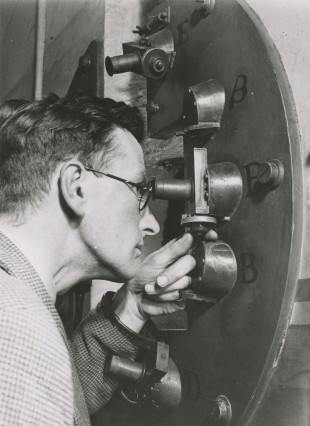
Philip Laurie posing at the microscopes of the Airy Transit Circle in about 1948. Humphry Smith Photographic Archive
‘The Astronomer Royal’s ill-health and prolonged absences convalescing at Hastings, combined with the burden of chronometer rating undertaken a decade before and the lack of control exercised over the staff by an alcoholic First Assistant, caused the Royal Observatory to fall into such a chaotic state that drastic action had to be taken to save the establishment.’
He said much the same thing (without references) in July 1975, at a symposium at the National Maritime Museum (Conference texts, later published in Vistas in Astronomy, Vol 20, part 1, 1976) :
‘Although the Astronomer Royal, John Pond, was an able astronomer and had introduced many instrumental innovations, he suffered from chronic ill-health and was, in later years, absent from the Observatory for considerable periods. On these occasions, he left in charge his First Assistant (of a staff now increased to 6) who was a drunkard without any control over his subordinates.’
A search of the archives has found no evidence that Taylor was an alcoholic; the only identified references to his drinking being those indicated in the section immediately above. Likewise, no evidence has emerged of Pond having ‘absented himself almost entirely from the Observatory in later years visiting it only every ninth or tenth day’’ nor of his having been convalescing at Hastings other than in 1831. Assuming that no actual evidence exists for the statement, one can only speculate on why Maunder wrote what he did.
Although the statements made by Maunder and Laurie are seemingly unsubstantiated, this has not prevented them from being quoted in whole or in part by others and in some cases embroidered and distorted on the way. In the process, they have become more and more embedded. Some of the subsequent variants are reproduced below. None reference the source of their information.
‘Thomas Taylor became an incurable alcoholic, while his family abused Pond’s kindness and ineffectual control over his staff until the whole institution degenerated into a state of inefficiency from which it had to be rescued ...’ (Forbes, Greenwich Observatory, 1975)
‘His deteriorating health resulted in his frequent absence from the observatory, and in 1835, a year before his death, he was forced to resign.’ (Henry King, Vistas in Astronomy, Vol 20, part 1, 1976)
‘Under Airy’s predecessor, the hard-drinking John Pond, the organization and discipline of Greenwich had seemingly sunk into disarray’ (Ashworth, John Herschel, George Airy, and the Roaming Eye of the State 1998)
‘When John Pond became Astronomer Royal one of his first acts was to appoint Thomas Taylor as First Assistant [Not true]. Of course, this was a non-resident appointment.[Not true] … Unfortunately, Pond had serious deficiencies as a disciplinarian and his control over the activities of his staff was lax. … Pond made a partial recovery [from his illness in 1831] and returned to work, but he was absent from the RO on more days than he was present and was harassed into retirement in 1835.’ (Hunt, The handlers of time, 1999)
‘During his last years Pond was afflicted by ill health, which caused his absence from the observatory for long periods. Discipline among his staff became lax, and he resigned on 30 September 1835.’ (Murray, ODNB, 2004)
‘...the Observatory was left in control of his first assistant, Thomas Taylor, whose alcoholism did little to secure the good management of the Observatory’ (Higgitt, RMG blog, 2011)
‘The First Assistant, Thomas Taylor (b. 1772) suffered severe and chronic alcoholism.’ (Perkins & Dick, The History of Celestial Navigation: Rise of the Royal Observatory and Nautical Almanacs, 2020)
In more recent years, Pond’s assistants have come under attack by Allan Chapman, (who is regarded as an authority on Pond’s successor Airy). In his somewhat misleading and only partially researched paper, Airy’s Greenwich staff (2012), Chapman references Pond’s spreadsheet titled: Statement respecting the assistants at the Royal Observatory (RGO6/72/223&226) but has been highly selective in what he has chosen to quote. Emphasising the negative but ignoring the positive, especially with regards to Taylor of whom he is quite disparaging, Chapman has then magnified the unsubstantiated charges made by Airy which are outlined in the section above. Chapman was clearly not aware of the fact that Henry Taylor had received a university education at Oxford nor was he aware of the marital bond that existed between the Ponds and the Taylors and its potential ramifications for the Observatory (but to be fair, neither was anyone else at this time). Ignoring the praise heaped on Richardson by Pond, Chapman chose instead to concentrate on the circumstances that lead up to his loosing his job, stating, in a somewhat dismissive manner, that after Richardson was acquitted following his subsequent trial at the Central Criminal Court – the Old Bailey, (which Chapman misstates as the Maidstone Assizes), Richardson ‘instantly vanished from the historical record’, speculating that he might have taken the next ship to America rather than establishing that he moved back to Pocklington in Yorkshire where he had been born. Nor does Chapman choose to mention, (let alone discuss the implications of), the financial losses unfairly imposed on Belville and Richardson firstly by changes made to the system of incremental pay rises in November 1835 and then by the imposition of a new allowance system in 1836.
The unfortunate mistake of Hollis and Maunder
When Hollis published his article The Astronomers Royal in 1899, he included an illustration of all the Astronomers Royal who had held the post, along with the following footnote:
‘Our portrait of Pond is believed to be rare. It is copied from a print in the possession of a Greenwich townsman, whose family have lived in the neighbourhood for some generations.’
The following year, when Maunder published his book The Royal Observatory Greenwich, he used the same image of Pond, thanking his colleague William Bower for procuring it.
Prior to the Hollis’s, paper, no likeness of Pond had ever been published. Hollis’s mistake was to use an image of the wrong John Pond. An unfortunate consequence was that the Observatory acquired an original copy of the same image in June 1925 (RGO39/4/158) it was also widely published, both in the terecentenary volumes produced by Howse and Macrea in 1975, but also in various museum guides. When the Royal Observatory was closed down in 1998, the portrait was transferred to the National Maritime Museum. It was only when someone at the National Maritime Museum came to catalogue it, that it was realised that the image was of John Pond the livery-stable keeper of Newmarket and compiler of the Racing Calendar. An examination of the portrait in the Museum’s collection shows that the bottom edge has been trimmed and as a result is missing the following inscription:
‘Pub:April 10 1787 by Benjm. Smith No.27 Great Pultney Street.’
It therefore could not possibly have been of the Astronomer Royal who was aged just 19 at the time. To add insult to injury, the Hollis/Maunder image appears to be a mirror image of the earlier one. It is not known if Hollis or Maunder sought verification from their former colleague, William Ellis, who was living nearby and had probably met Pond as a child since he was the son of Pond’s Assistant, Thomas Ellis. It also has to be supposed that when the Observatory bought the portrait in 1925, it did so on the basis of the attribution made by Hollis and Maunder. Had proper due dilligence been carried out, it would have been easy enough to establish that the print was trimmed and was the wrong John Pond.
So as not to detract from this page, the image is not reproduced here, but can be seen as published by Hollis here, and as published by Maunder here.
The National Portrait Gallery holds an untrimmed copy of the original 1787 image (Object ID: NPG D8563). The copy bought by the Royal Observatory can also be viewed online (Object ID:ZBA0663),
The misjudged manouverings of Stephen Lee
At the end of 1824, Stephen Lee took Pond to task in two letters that he wrote in a personal capacity that were published in the Philosophical Magazine and Journal. The subject matter was inconsistencies and errors that he had found in the recently published volumes of Greenwich Observations for the years 1821 and 1822.
As mentioned above, Stephen Lee was no ordinary member of the public or astronomical community. Elected a fellow of the Royal Society in 1798, he had been appointed the Society's Clerk, Housekeeper and Librarian towards the end of 1810 and as a condition of taking up the post had had to resign his fellowship. Retitled Assistant Secretary in 1823, his duties would have meant that he would have been privy to the ongoing discussions regarding the establishment of a new well paid class of Assistant at Greenwich (see above). As Assistant Secretary, Lee had both access to and made use of the original manuscript observations which had been deposited with the Society (as required under the Warrant of 1820 that had reappointed the Board of Visitors on the accession of George IV).
Pond’s Second Assistant (John Belville) believed that Lee wrote the letters as an act of revenge because Pond had not nominated him for the post of H.M. Astronomer at the Cape of Good Hope (RGO6/1/59). However, according to a letter from John Herschel sent to James South on 8 January 1824, Lee was in the running to be appointed as the new First Assistant. Given that the contents of the letters were unlikely to result in a good working relationship between Pond and himself, perhaps Lee wanted to topple Pond and aspired to become the new Astronomer Royal in his place. The question that has to be asked is: did Lee send the letters in a misguided attempt to enhance his prospects or did he genuinely send it for the reason he set out in the opening paragraph of his first letter as set out below?
‘Being lately engaged in the investigation of a question which requires a reference to the most accurate astronomical observations that can be procured, I naturally turned to those of the royal observatory at Greenwich; but the results which I obtained from them, were by no means satisfactory to my purpose. The first impression on my mind was, that I must have fallen into some mistake in respect to the conclusions which I had supposed could be drawn from them, and under that impression I gave up the inquiry. A hint however, which I shortly afterwards received from a friend, to whom I accidentally mentioned the circumstance, led me to suspect that my disappointment was occasioned, not by any false reasoning in the investigation alluded to, but by errors in the observations; and a careful, though not yet complete examination of those for 1821, have fully confirmed my suspicions. ...’
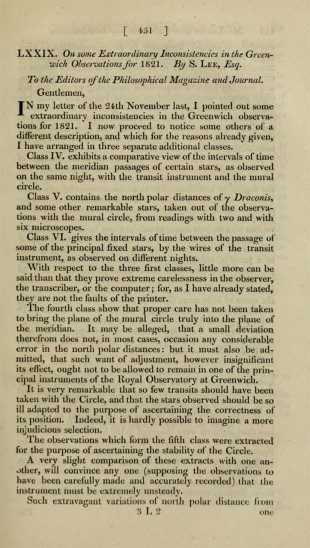
The first page of Lee's second letter. Image courtesy Natural History Museum, London, via Internet Archive
1824, Nov 30. First letter from Lee, dated 24 November, published in Philosophical Magazine and Journal (Click here to read).
1824, Dec 31. Second letter from Lee, dated 20 December, published in Philosophical Magazine and Journal (Click here to read).
1825, Feb. On about the 25th? Lee had a conversation with the President of Royal Society (Humphry Davy) about the subject of his two papers. Davy told him that he should address any remarks on the matter to the Council of the Royal Society, ‘who as Visitors of the Royal Observatory ... were the proper authority to appeal to on such an occasion’ (RGO6/22/144).
1825, Feb 28. Lee writes the letter as Davy had suggested. (RGO6/22/140 & 144-151).
1825, Mar 3. Lee’s letter read to the Council (at which Pond was present). Pond asked to repond to it at the next meeting of the Council (RGO6/22/137). Pond either did not respond at the next meeting on 17 March, or if he did his response was not minuted.
1825, Mar 17, Lee asked at a meeting of the Council to provide Pond with a copy of his remarks on the Greenwich Observations for 1822 (RGO6/22/138).
1825, May 5. At a meeting of Council, Pond presented statement on the 1822 observations (RGO6/22/139 & 151-160). Committee set up to examine Lee’s claims (Baily, Colby, Gilbert, Herschel, Kater, Wollaston & Young) (RGO6/22/139).
1825, Jun 16. The committee formed on 5 May, (having met on 25 May and 1, 4 & 16 June) delivered its report, the findings of which were unanimous. In a statement they said that Pond was ‘acquitted of any culpable inattention to the immediate duties of his important office ... but that a certain degree of negligence is too apparent on the part of some of the assistants especially with regard to the registers of the heights of the Barometer and Thermometer in consequence of which an error of nearly a second had been introduced into the single results of some few of the observations ...’ (RGO6/22/162-168). Despite Pond’s vindication, since the 1970s, there has been a tendency for historians to give equal or greater weight to a remark Pond made in the written evidence that he submitted to the Committee (RGO6/22/153):
‘... In these cases the causes of the errors are obvious and a fair & intelligent critic would have pointed out those causes he would have shown that the inconsistencies were but apparent and that the worst fault that he laid to my charge under this head was a little want of vigilance as an editor.’
Highlighted by Forbes (1975) and requoted by Murray in ODNB in 2005 the comment has subsequently been requoted by several others. As Rebecca Higgitt commented in the National Maritime Museum blog in 2011, mud has a habit of sticking, so much so, that in her Longitude essay: John Pond, Sophie Waring applied the quote to the Nautcial Almanac writing:
‘His [Pond’s] neglect of the Nautical Almanac, along with his own admission that he was not vigilant enough as an editor, resulted in the superintendency of the publication being handed to Thomas Young in 1818 at the same time he became secretary for the Board of Longitude.’
Perkins did much the same thing in 2020, in chapter five of The History of Celestial Navigation: Rise of the Royal Observatory and Nautical Almanacs. Like Forbes before him (who he quotes), Perkins is also wrong about the timing of events as the comments about the Jovian satellites and comets had been considered at the meeting of the Committee that had been held on 4 June (RGO6/22/166). The error on the part of Forbes arose due to the non-chronological arrangement of some of the minutes and his misreading of the dates. However, Lee did not raise any issues regarding the accuracy of the Nautical Almanac as Perkins (but not Forbes) has stated: This is what Perkins wrote:
‘ ... and the Royal Society’s committee appointed to assess Lee’s criticisms found that Pond was not wanting in “culpable inattention to the immediate duties of his important office”. Lee was not satisfied and continued with his complaints, drawing further attention to inaccurate observations of the Jovian satellites and to a comet that had been entirely ignored, as well as problems with the Nautical Almanac tables, but the Admiralty simply took the view that the Observatory was understaffed and proposed an increase to the establishment of four assistants. Pond himself put it to the committee of the Royal Society that he had some “want of vigilance as an editor”, which is perhaps, by omission, putting too rosy a hue on matters.’
For the sake of clarity, the first paragraphs of the committees report are transcribed below:
‘The Committee of the Royal Society appointed to consider of the errors pointed out by Mr Lee in the Greenwich Observations have examined the most important of the remarks with great care and have unanimously agreed to adopt for their report a Copy of the Minutes which have been made at their several meetings.
Considering however the erroneous impressions which might possibly arise in the mind of a hasty observer from the length and minuteness of detail into which it has been found necessary to enter they think it right to express in the first instance their decided opinion that the Astronomer Royal stands acquitted of any culpable inattention to the immediate duties of his important office
2. But that a certain degree of negligence is too apparent on the part of some of the assistants especially with regard to the registers of the heights of the Barometer and Thermometers in consequence of which an error of nearly a second had been introduced into the single results of some few of the observations
3. That notwithstanding these occasional inaccuracies the Greenwich Observations still appear to remain as much unrivalled for their utility and they have always been hitherto esteemed and that those which relate to the Transits remain free from the slightest imputation.
4. The Committee cannot help remarking at the same time that a very great majority of the cases pointed our are so manifestly unimportant that the merely enumerating them as requiring serious notice is in itself a sort of misrepresentation’
This was then followed by eleven pages of minutes relating to the four sessions of the Committee.
1825, Jun 17. Day of annual Visitation.
1825, Jul 2. Lee wrote to Admiralty on the matter, assuming that they had received a copy of the committee’s report. In it he said: ‘It contains besides some expressions respecting myself which is utterly impossible for me to endure in silence, one or two Egregious Mistakes ...’ going on to say ‘before I appeal to public opinion which I wish if possible to avoid ...’ whether if he wrote ‘to the Lords of the Admiralty on the subject, leaving out everything of a personal nature’ if it was likely that any attention would be paid to it. RGO6/22/169&170)
1825, Jul 4. Admiralty replied telling Lee to take the matter up with the Royal Society. (RGO6/22/170)
1825, Sep 17. At a meeting of Council, Lee’s letter to the Admiralty discussed. ‘Ordered that Mr Lee be called in and informed by the President that the Council feel extremely indignant at the expressions theirin contained which they consider highly improper and indecorous & they expect Mr Lee to offer some explanation of or offers some apology for the same at the next meeting of the Council’. (RGO6/22/172)
1825, Dec 15. At a meeting of Council the following was minuted: ‘A letter having been read from Mr Lee it was Resolved that the Council do not consider his explanation relative to his correspondence with the Admiralty as at all satisfactory & that they cannot admit of its insertion in the minutes of the Council in consequence of the offensive expressions which it contains.’ (RGO6/22/173)
1826, Mar 9. James Hudson appointed as new Assistant Secretary pending Lee’s resignation (Hall, 1992)
1826, Apr 6. At a meeting of Council, Lee’s letter of resignation read and Hudson’s appointment made permanent (Hall, 1992)
Interestingly, it was only the fact that Lee wrote to the Admiralty that put him in bad odour with Council, not the fact that he published his findings in the Philosophical Magazine (albeit in a personal capacity). Rather than wash the dirty lined in public via the Philosophical Magazine, one might have thought that a better approach in the first instance would have been take the matter up directly and in person with the Royal Society. Lee's motives for publishing remain unclear. Whatever his aim, the way he went about things backfired spectacularly.
The minutes consulted for this section were those transcribed for Airy from the books of Council minutes. What would be interesting to study in the future, (but Covid-19 has prevented at the time of writing), would be the original volumes of minutes and rough minutes to see whose hand they were written in. It is hard to imagine that Lee would have minuted the meetings mentioned above.
The story of Stephen Lee has been told, by both Eric Forbes (1975) and Marie Boas Hall (1992). Both accounts are flawed because neither author was aware that Lee's two letters had been published. In his letter to Davy dated 28 February 1825, Lee referred to the Philosophical Magazine and Journal as the Philosophical Journal. Forbes appears to have taken this to mean the Philosophical Transactions of the Royal Society. Since he couldn't find anything in those volumes, he seems to have concluded that Lee's complaints were never published. This was despite the fact that the minutes clearly state that they were. Hall, who seems to have relied at least in part on Forbes in her account fails to mention the fact either.
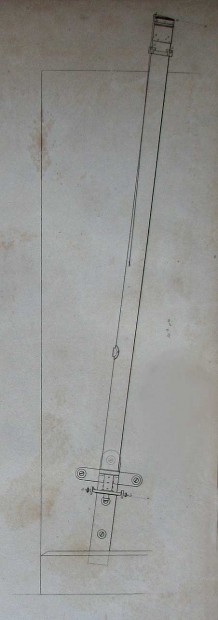
Pond's Alpha Cygni Telescope. It was mounted in front of Halley's 8-foot Iron Mural Quadrant (not shown) which remained in place on the wall behind it. From an engraving published in Volume 2 of Pond's Greenwich Observations
‘A silly attempt was made in England in 1823 (Phil. Mag., LXIII) to annoy and discredit Pond, by allegations of inordinate discordances and errors recorded in his observations, While the frivolous nature of these criticisms was easily exposed [at the time] by Bessel (A.N,. IV, 209), it is proper here especially to note the surprisingly small percentage of such mistakes which I have been able to detect in the prosecution of this work.‘
John Brinkley and a dispute over parallax
The α Aquilae and α Cygni Telescopes were conceived by Pond, in an attempt to settle a difference in view that had developed between him and John Brinkley (the Royal Astronomer of Ireland and a former Greenwich Assistant under Maskelyne), over whether or not Brinkley had measured a parallax for α Aquilae (Altair), α Cygni (Deneb) and a small selection of other bright stars. Brinkley’s Observations were made with an 8-foot reversible vertical circle at the Dunsink Observatory near Dublin. The paper that triggered what turned out to be a decade long argument was published by Brinkley in 1815. On checking his own Mural Circle observations at Greenwich, Pond found that although there was a discordance between his summer and winter observations, it was much less than that which Brinkley had measured. To try and settle the question by an independent means, Pond commissioned two identical 10-foot achromatic telescopes of four-inch apperture from Dollond. Each was to be mounted rigidly on a meridian wall, one angled at about 6.5º from the zenith for observing α Cygni as it crossed the meridian; the other angled at about 43º for similar observations of α Aquilae.
Pond and Brinkley were both awarded the Royal Society’s Copley medal: Pond in 1823 for ‘his various papers and observations communicated to the Royal Society’, and Brinkley in 1824 for ‘his various communications printed in Philosophical Transactions’. At the time, there was no fixed view as to who had won the argument about parallax as was made clear when the medals were presented.
Click here to read the speech made by the President of the Society on awarding the medal to Pond.
Click here to read the speech made by the President of the Society on awarding the medal to Brinkley.
Click here to read more about the telescopes and the published papers.
Problems with the Nautical Almanac
‘And whereas the Publication of Nautical Almanacks constructed by proper Persons, under the Direction of the said Commissioners, would greatly contribute to make the said Lunar Tables more generally useful; be it further Enacted, by the Authority aforesaid, That it shall and may be lawful to and for the said Commissioners to cause such Nautical Almanacks, or other useful Tables, to be constructed, and to print, publish, and vend, or cause to be printed, published, and vended, any Nautical Almanack or Almanacks, or other useful Table or Tables, which they, or the major Part of them, shall, from time to time, judge necessary and useful, in order to facilitate the Method of discovering the Longitude at Sea; any Law, Statute, exclusive Privilege, private Charter, or other Custom, to the contrary thereof notwithstanding.’
Although the Logitude Act of 1765 authorised the Board of Longitude to publish the Nautical Almanac, it said nothing about how that responsibility should be delegated. Initially, responsibility for overseeing its compilation fell largely onto the shoulders of the Astronomer Royal, Nevil Maskelyne, who was the person who had suggested that it should be produced. This reponsibility however did not automatically transfer to Pond when he was appointed as Maskelyne’s successor as Astronomer Royal.
The meeting of the Board of Longitude on 7 March 1811 was the first to be held following the death of Maskelyne a month earlier. It was also the first meeting that Joseph Banks had attended since March 1806. The minutes (RGO14/7/145) record that Pond
‘offered his services towards carrying on the business of the Board’s Publication of the Nautical Almanac in the same manner as his predecessor had done if it were the wish of the Board.’
And that it was the resloved:
‘That the Astronomer Royal be requested to conduct the business of the Nautical Almanac by superintending & paying the Computers and Comparer in the manner that has been heretofore done & that the Secretary be requested to allow him access to the Minutes of the Board in order that he may collect from them the mode in which that business has been hitherto carried on.’
Given the brevity of the minutes, it cannot be discerned how it was that Pond came to offer his services. Was he asked to do it, was he bounced into doing it, or did he spontaneously suggest that he should do so? Either way, Pond would probably have felt obliged to take on the task due to the presence of Joseph Banks on whose patronage he was dependent as Astronomer Royal.
Pond retained responsibility for organising the production of the Almanac until the passing of the 1818 Longitude Act. The Parliamentary debate proposing the new Act took place on 6 March 1818 and was lead by John Croker. The following is an extract from the record:
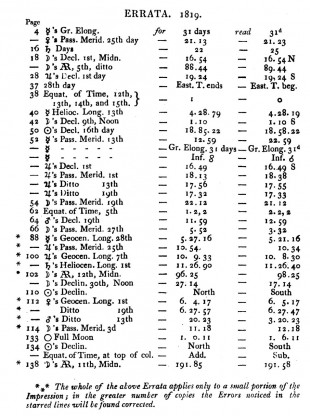
Errata (40 in total) for the 1819 volume. From the reprinted volume for 1819 published in 1818. Image digitised by Google from a copy belonging to the University of California and accessed via HathiTrust
‘ … The intention of the bill which he [Croker] should have the honour to propose was, that the commissioners of the board of longitude should remain just as they were, but that there should be added to them such gentlemen in the scientific world as, by a residence in or near the metropolis, would become useful members and assistants. His object was, indeed, to replace the board in that state of efficiency in which it ought to be – to restore it to that situation in which it was intended to be at its very foundation and commencement. There were many important considerations which would show the necessity of resorting to this proceeding. In the first place, he would beg to state, that, in the year 1767, Dr. Maskelyne, a name which could never be mentioned without the highest respect, projected the Nautical Almanack, a work which was published during his lifetime with the greatest honour to himself, and the most essential service to the country. But, after his death, the reputation of that book greatly declined, and it had latterly fallen to a very low state. Mr. Croker said, he had himself looked into the whole of the almanacks, from the earliest period, and had found only two or three errata in any one volume. The latter publications, however, were very incorrect, and he was sorry to be obliged to say, that the volume for the present year did not contain less than eighteen grave errors, and the publication for the next year not less than forty. In fact, the nautical almanack was a by-word among the literati of Europe. He would mention, however, that, generally speaking, they were not scientific, but typographical errors: but the mischief that must arise from such a publication was an injurious in the one case as in the other. From this consideration, it would be part of his measure, that the House should select a proper person, with moderate but adequate salary, to superintend the publication of that work. Another object which deserved great attention …’
‘Mr. Davies Gilbert said, that ... . With respect to the Nautical Almanack, he begged to inform the House, that the reputation which that work had acquired was owing to the unremitting care and attention of the rev. Mr. Hitchins, a gentleman whose name had not been sufficiently known, nor his labours duly rewarded. Since his death, the publication had fallen into other hands, and was not so well conducted. Another clergyman, the rev. Mr. Edwards, had greatly distinguished himself by his calculations on these subjects, in which his wife and daughter frequently assisted; but Mr. Edwards was now dead, and his widow and daughter had not met with that degree of attention which they deserved. In point of fact, they were no longer employed.’
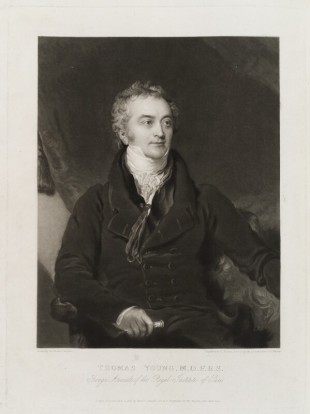
Thomas Young by Charles Turner, published by Colnaghi, Son & Co, after Sir Thomas Lawrence. Mezzotint, published 6 April 1830. © National Portrait Gallery, London. Reproduced under a Creative Commons Attribution-NonCommercial-NoDerivs 3.0 Unported (CC BY-NC-ND 3.0) licence (see below)
Prior to the debate in Parliament, concerns about the Almanac had been publicly aired in The Philosophical Magazine and Journal. Starting soon after Pond became Astronomer Royal, they built up to a climax in a letter published in the December 1817 edition. Written by an individual hiding behind the pseudonym Astronomicus, shortly after he had obtained a copy of the volume for the year 1820, it was later described as ‘a severe critique on the Commissioners of the Board of Longitude and the conductors of the Nautical Almanac’. Astronomicus began his attack on the fact that the hoped for inclusion of additional material had not materialised. He then went on to attack the two prefaces included with the volume, in particular the one written by Pond (more on this below) and ended by mentioning various errors that he had identified relating mainly to occultations and eclipses. A letter in defence of the Almanac was published in the February 1818 edition. Its author, writing as Manchestriensis, concentrated solely on the question of the supposed errors mentioned by Astronomicus. Manchestriensis demonstrated that the claims made were erroneous and attempted to turn the tables by suggesting that they were the result of his ignorance and unskilfulness. This annoyed Astromicus whose letter in reply was published in the March 1818 edition and made reference to Croker‘s recent comments in the House of Commons. Astronomicus ended his letter on this occasion with a long list of reforms that he would like to see introduced into the Almanac by the new Commissioners. The following year, Astronomicus supplied the Magazine with an extensive and unauthorised list of well over 150 ‘corrections of errors‘ for the volume of the Almanac for 1819. Possibly compiled because of a comment made by a certain Ptolemy in the December 1818 edition, they were published in the March 1819 edition along with a critical letter about the Almanac from someone writing as Philaster.
Astronomicus‘s comments in 1817 and Croker‘s widely reported comment in parliament about the state of the Almanac appear to have seeded the tendency for historians to pin or appear to pin, the blame for the greater number of errors onto Pond’s shoulders – this is despite the fact that Pond was not mentioned during the Commons debate.
In his Life of Thomas Young, which was published in 1855, George Peacock wrote of Pond:
‘His feeble health and gentle disposition disqualified him also for the task of sufficiently controlling the subordinate parties employed in the preparation of the Nautical Almanac, and the consequence was, that errors were allowed to creep into it, which seriously compromised the character of a publication which had hitherto been deemed to be altogether unimpeachable.’
In the History of the Royal Astronomical Society, 1820–1920, following an earlier reference to Astronomicus‘s letter (p.39), Dreyer went on to write (p.53):
‘The Nautical Almanac and Astronomical Ephemeris had appeared since the year 1767. It was “published by order of the Commissioners of Longitude,” but Maskelyne was responsible for it from the beginning till his death in 1811. During the next seven years nobody in particular seems to have looked after it (though the Astronomer Royal was still supposed to be the editor), and it lost the character for accuracy which the work had hitherto enjoyed.’
About thirty years later, in 1954, in an appendix to Alex Wood’s Book Thomas Young. Natural Philosopher 1773–1829, Edmund Dews wrote the following (without specific references, but which he based on ‘a study of the Longitude Papers in the library of the Royal Greenwich Observatory’):
‘For a time the Board enjoyed a high reputation among men of science, on the continent as well as in Britain; but after the partial withdrawal of Sir Joseph Banks in 1806 and the death of Maskelyne in 1811, the leadership of the Board failed, and it fell into inefficiency and decay. John Pond, Maskelyne’s successor as Astronomer Royal, was an excellent practical observer, but he lacked Maskelyne’s administrative talents, and was inadequate to perform Maskelyne’s duties as treasurer of the Board and editor of the Nautical Almanac. When members of Maskelyne’s team of Almanac computers and comparers retired, Pond failed to establish a competent new team working to a proper system. Mistakes in the Almanac became too frequent, and Pond’s accounts for the Board were hopelessly muddled.’
For the sake of clarity, it should be added at this point that neither Maskelyne nor Pond were ever treasurer to the Board. Each however had an imprest account from which money was paid to the computers, comparers, printers and paper suppliers for the Almanac. Nor is it true that Pond’s accounts were hopelessly muddled. What had become muddled was the accounting practice and workings of the Board itself, which was one of the things that the 1818 Longitude Act attempted to address – more on this below. The only treasurer associtated with the Board was the Treasurer of the Navy, who the various Longitude Acts authorised to make payments on behalf of the Board.
The many criticisms of Pond made from the 1970s onwards (all unreferenced) appear to have morphed from Dews’s comments and three further comments made in 1949 and 1967 (two of which were made by members of the Observatory staff and all three of which are unreferenced). The first was made by the Astronomer Royal, Sir Harold Spencer Jones in 1949 in his lecture about the Royal Observatory that was subsequently published in the Proceedings of the Royal Society of London (Series A, Mathematical and Physical Sciences Vol. 198, p.166):
‘Pond, who succeeded Maskelyne as Astronomer Royal, did not take the same interest in the Nautical Almanac, though he remained nominally responsible for it. The Almanac lost its reputation for accuracy, and eventually in 1831 a separate Nautical Almanac Office was established with its own Superintendent and having no formal connexion with the Observatory.’
The second was made by Donald Sadler, the then Superintendent of the Nautical Almanac, who, in his booklet Man is not Lost, (which was published in 1967 to coincide with the Almanac’s bi-centenary), wrote :
‘On Maskelyne’s death in 1811 the system gradually deteriorated – whether because of the Astronomer Royal’s (John Pond) lack of personal interest, or changes in the computers and comparers (during this period they successfully petitioned for greater remuneration) need not be perused – and the Nautical Almanac lost its character for accuracy and fell into disrepute.’
The third was made by Colin Ronan in his book Their Majesties’ astronomers (1967).
‘Moreover, Pond took little interest in the Nautical Almanac, and it was in 1818 that the post of Superintendent had to be created ...’
In 1975, McCrea wrote in The Royal Greenwich Observatory (an historical review):
‘Pond had inherited the responsibility for producing the Nautical Almanac but apparently not his predecessor’s staff for this work. He was also much more taken up with instrumental developments than Maskelyne had been. In consequence, the Almanac fell into disrepute. As the result of an Act of 1818, the Almanac was then removed from the responsibility of the Observatory.’
In 1975, at a symposium at the National Maritime Museum, George Wilkins (Vistas in Astronomy, Vol 20, part 1), Sadler’s successor as Superintendent said in his paper The expanding role of H.M. Nautical Almanac Office, 1818–1975, that:
‘The fifth Astronomer Royal (John Pond) did not share Nevile Maskelyne’s enthusiasm for the Almanac, which then became notorious for the number of errors it contained.’
Given what Wilkins said, it is somewhat ironic that Pond was described as the fifth Astronomer Royal rather than the sixth and that Maskelyne’s first name was misspelt. At the same symposium, Henry King said of Pond:
‘ At first he had one assistant, Thomas Taylor, appointed during Maskelyne’s regime, and eventually six assistants, but he was a poor administrator, found the responsibility of preparing and publishing the Nautical Almanac irksome, was unable to control his staff, and disliked the burden of rating chronometers offered by government purchase.’
Some 20 or so years later in his paper that was read at the Nautical Almanac Office sesquicentennial symposium at the U.S. Naval Observatory in March 1999, Wilkins was to write:
‘Maskelyne continued to be responsible for the production of the Nautical Almanac until his death in 1811, when he was succeeded as Astronomer Royal by John Pond. Unfortunately, Pond failed to exercise proper control over the work of preparing the Almanac, and so Thomas Young was made Superintendent of the Nautical Almanac in 1818 at the same time as he was made Secretary of the Board of Longitude. It seems surprising that the Almanacs continue to indicate that they were to be printed according to the directions of John Pond.’
In 2002, in her paper Providing longitude for all, Mary Croarken wrote:
‘Maskelyne’s successor as Astronomer Royal, John Pond, did not take as much care supervising the computing of the Nautical Almanac as Maskelyne had done and consequently the quality of the work decreased.’
Pond’s ODNB entry written in 2004 by Andrew Murray (who had held a senior post at the Observatory) states:
‘It cannot be said, however, that his [Pond’s] general management of the affairs of the observatory was entirely successful. The quality of the Nautical Almanac deteriorated in his earlier years, and…’
HM Hydrographic Office’s Archive Catalogue of Collections (V1, 22.05.2019, p.143) states:
‘In the first part of the nineteenth century, during the time of the Astronomer Royal John Pond (1767–1836) the Almanac fell into disrepute and became notorious for its errors.’
As mentioned above, Sophie Waring, who was a researcher for the Board of Longitude Project, whose Principal Investigator was Simon Schaffer and which ran from 2010–2015, wrote in an essay that was published alongside the digitised papers of the Board:
‘His neglect of the Nautical Almanac, along with his own admission that he was not vigilant enough as an editor, resulted in the superintendency of the publication being handed to Thomas Young in 1818.’
On a similar vein, P. Kenneth Seidelmann in his A history of western astronomical almanacs (2019) writes:
‘The Nautical Almanac fell into disrepute due to many errors in the early 1800s, when John Pond (1767‒1836) and Thomas Young (1773‒ 1829) were responsible’
More recently, Adam Perkins (the Observatory’s former archivist), who co-wrote a chapter of The History of Celestial Navigation: Rise of the Royal Observatory and Nautical Almanacs, (2020) stated:
‘Pond’s striving for the excellence we have read of in the observations came at a cost in respect to the ancillary responsibilities of the Royal Observatory. Maskelyne’s team doing all the detailed ground-work for the Nautical Almanac were active until his death in 1811 and it seems that then the procedures he had laid down, though continuing, suffered from the loss of his careful management.’
Meanwhile back in 2014, Croarken repeated her criticism of Pond in a chapter she wrote in Maskelyne Astronomer Royal (Ed. Higgitt):
‘When Maskelyne died leaving the Nautical Almanac in his [Thomas Brown's] hands (as John Pond, the subsequent Astronomer Royal, had little interest in the work), the quality declined rapidly to the point of complaints being raised in Parliament some years later.’ (p.147)
‘On Maskelyne's death in 1811, John Pond was appointed as sixth Astronomer Royal, a post held until 1835. Pond had good observational skills and updated the Observatory equipment, but he was a poor manager as well as suffering from recurrent ill health. This was coupled with his lack of interest in computational astronomy and the management of the Nautical Almanac fell to Thomas Brown ...’ (p.157)
But who was really to blame for the loss of reputation of the Almanac? Was it Pond? Was it the Comparer, Thomas Brown and the nepotism that allowed him to be appointed? Was it Maskelyne or was it the Board collectively? Or was it perhaps the fault of Government for having failed to give sufficient guidence in the various Longitude Acts or through Orders in Council as to how the business of the Board was to be conducted? There are good grounds for believing that although on the face of it the fault lay primarily with the Comparer; Maskelyne, the Board and Government were equally if not more to blame.
Prior to 1818, although superintended by the Astronomer Royal, most of the work that was done in preparing the Almanac for the press was done by other people – a team of Computers and a Comparer. Each calculation was done independently by two different Computers and if the results were different they were done again by the Comparer.
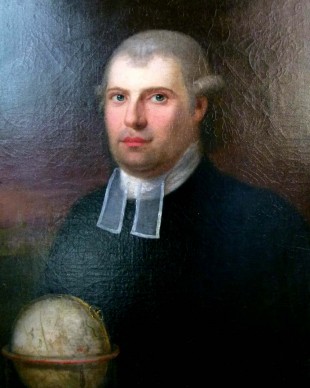
Rev. Malachy Hitchins (1741-1809). Oil painting by John Opie, 18th century. Image courtesy of Andrew Maden
The Diary also lists all the Computers and Comparers employed at different times between 1791 and 1811. Hitchins is the only Comparer listed for all the volumes up to and including the volume for 1814, which he appears to have just completed when he died on 28 March 1809. Given that Hitchins was in his late sixties and the lynch-pin of the whole organisation, it seems rather remiss on the part of Maskelyne and the Board that there had been no succession planning. With no suitable candidate trained up, Maskelyne spread the work of the Comparer between the existing Computers (RGO4/424/30). There were five Comparers for the 1815 volume (Henry Andrews, Nicholas James, Rev. Thomas Brown, Mary Edwards and her daughter Eliza Edwards) and two for the 1816 volume (Thomas Brown and Mary Edwards), which was the last complete volume to be prepared ready for the press before Maskelyne died on 9 February 1811 at the age of 78. In addition to this, Andrews was asked to examine the proofs for the 1814 volume that had not already been checked by Hitchins (RGO4/149/43). As can be seen from the page of Maskelyne’s Diary reproduced below, the use of Mary and Eliza Edwards for the 1815 volume breached the principle that had been in place since 1765 that computers and comparers should work independently of one another.
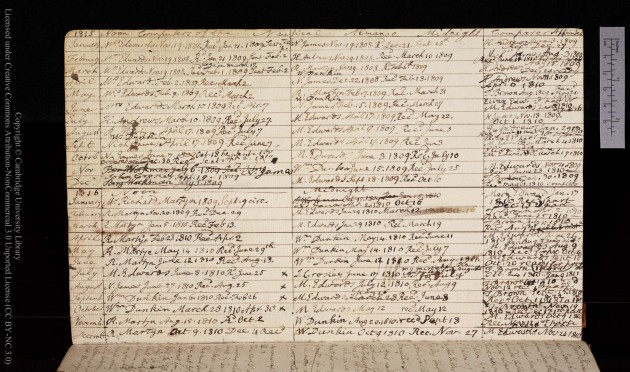
Table compiled by Maskelyne showing work assigned to the Computers and Comparers for the 1815 and 1816 volumes of the Nautical Almanac. Reproduced under the terms of a Creative Commons Attribution-Non-Commercial 3.0 Unported License (CC BY-NC 3.0) courtesy of Cambridge Digital Library (see below)
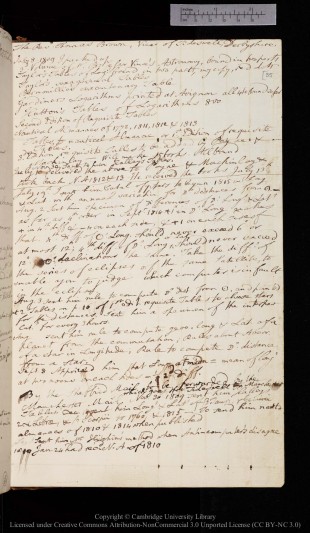
Page 35 from Maskelyne's 'Diary of Nautical Almanac work' (RGO4/324) showing the books, tables, information and instructions he had sent to Thomas Brown. Whilst meaningful to Maskelyne, the notes would have taken some unravelling by Pond. The second to last line for example states: 'Sent him Mr Hitchins' method when Anticomputer's disagree. Pond would then have needed to establish what Hitchins' method was, though it is not obvious where he would have found this. Reproduced under the terms of a Creative Commons Attribution-Non-Commercial 3.0 Unported License (CC BY-NC 3.0) courtesy of Cambridge Digital Library (see below)
‘That the Astronomer Royal [Pond] be requested to conduct the business of the Nautical Almanac by superintending & paying the Computers and Comparer in the manner that has been heretofore done & that the Secretary be requested to allow him access to the Minutes of the Board in order that he may collect from them the mode in which that business has been hitherto carried on.’
What is striking is that Pond wasn’t handed a dossier by the Secretary setting out how the Almanac had been managed and what the present state of play was. He was required instead to extract this information from the Board’s minutes. This would have been an all but impossible task since the minutes, of which 800 pages had been accumulated since the Almanac was conceived in 1765, did not contain the information in the detail that Pond would have needed. Indeed, he would probably have been better off reading the preface to the 1815 Almanac which Maskelyne had written in September 1810. But this too would have been insufficient to understand the formulae and procedures used in the Almanac’s construction. Nor would it have provided him with the names of the individuals involved in producing it. The most useful documents for Pond, would have been Maskelyne’s Diary of Nautical Almanac work (RGO4//324) and Account Book for Computers and Comparers (RGO4/325). Given that the Almanac was the responsibility of the Board of Longitude rather than the astronomer Royal, it should perhaps come as no surprise that Maskelyne’s widow left neither a handover document nor these or any of the papers relating to the Almanac for his successor at Greenwich (NMM Reg/9/37). Even if the Diary and Account book did eventually fall into his hands, Pond would have struggled to work out the detail of how the Almanac was put together, not least because of the way that Maskelyne had ordered the pages.
What the resolution seems to show, is a remarkable degree of ignorance on the part of the Commissioners about the detail of the way in which Maskelyne had conducted the business on their behalf. Given the disruption that Hitchins’ death had caused and given that Maskelyne was 76 years old when Hitchins died, it seems somewhat remiss that neither he nor the Board put steps in place to ensure that a smooth handover could take place when he died. Part of the reason for this failure could be down to the fact that the Board normally only met three times a year, did not have a nominated person to act as its chairman and in 1810 suffered from a change in Secretary as the result of the death of George Gilpin. In light of all this, it is perhaps no surprise that no one had taken proper ownership of the situation.
Gilpin (who had once been one of Maskelyne’s assistants) was buried in the churchyard of: St Mary Le Strand on 2 May 1810 and replaced as Secretary by Thomas Hurd. According to Adrian Webb, Hurd was appointed on 26 April 1810 (Adrian Webb (PhD, 2010) ref ADM7/819). However, the minutes of the meeting of the Board held on 7 June (RGO14/7/141) record that after the minutes of the previous meeting were read, ‘Captain Thomas Hurd RN and Hydrographer to the Admiralty was elected Secretary.’ Elsewhere in the archives of the Board of Longitude, is a letter that has been highlighted by Katy Barrett in the Cambridge Digital Archive. Sent by Maskelyne to Hurd on 15 November 1810 (RGO14/3/184), it tells him that he needs to obtain the sanction of the First Lord of the Admiralty to call the meeting due to be held on 6 December, and provided him with a list of those who needed to attend, giving him the addresses of some and telling him to obtain the rest from Gilpin’s son whom he then gave contact details for. In the same letter, Maskelyne also asked for the return of his ‘minutes of the last Board’, suggesting that it was Maskelyne who had recorded them. That it fell to Maskelyne to inform Hurd of what he need to do, further emphasises the absence of any formal directives existing in resepect of the organisation of the Board's administrative procedures as well as a lack of leadership withing the Board in its planning for the future.
The table below lists the dates and attendees of the meetings of the Board that took place between 1807 and 1818. The five professors were the Savilian Professor of Astronomy and the Savilian Professor of Geometry from Oxford, together with the Lucasian Professor of Mathematics, the Plumian Professsor of Astronomy and the Lowndian Professor of Astronomy from Cambridge. The individuals were: Hornsby (until 1 March 1810) Robertson, Milner Vince, Lax and Rigaud (from 7 June 1810). The person listed first in the minutes is assumed to have chaired the meeting and is litsted first in the table. Unlike the other Commissioners, Pond and the five professors were paid £25 in expenses (RGO14/2/5) for each meeting they attended (which gave some of them a large salary boost, particularly the Lucasian Professor) and helps explain their good attendance). Banks had stopped attending meetings of the Board in 1806 following a dispute with Maskelyne concerning the watchmaker Thomas Earnshaw and only started reattending in 1811 following the death of Maskelyne.
| Date | Attendees | ||
| 1807 | Mar 5 | Right Hon. Thos. Grenville (First Lord of the Admiralty) + James Cummings (Admiral of the White) + Maskelyne + 5 professors | |
| Jun 3 | Maskelyne + 5 professors | ||
| Dec 3 | Lord Mulgrave (First Lord of the Admiralty) + Maskelyne + 5 professors | ||
| 1808 | Mar 3 | Maskelyne + 5 professors | |
| Jun 2 | Maskelyne + 5 professors | ||
| Dec 1 | Maskelyne + 5 professors | ||
| 1809 | Mar 2 | Maskelyne + 5 professors |
|
| May 8 | Maskelyne + 5 professors | ||
| Jun 1 | Maskelyne + 4 professors | ||
| Dec 7 | Maskelyne + 5 professors | ||
| 1810 | Mar 1 | Maskelyne + 5 professors | |
| Jun 7 | Right Hon. Charles York (First Lord of the Admiralty) + Maskelyne + 5 professors + Thompson (Comptroller of the Navy) + Croker (Sec to the Admiralty) |
||
| Dec 6 | Maskelyne + 5 professors | ||
| 1811 | Mar 7 | Sir Richard Bickerton (Admiral of the Blue) + Joseph Banks + 5 professors + Pond |
|
| Jun 6 | 5 professors + Pond (Robertson in the chair) | ||
| Jul 16 | Sir Richard Bickerton + Banks + Croker + 5 professors + Pond | ||
| Dec 5 | Banks + 5 professors + Pond | ||
| 1812 | Mar 5 | Banks + 5 professors + Pond | |
| Jun 3 | Banks + 5 professors + Pond | ||
| Dec 3 | Banks + 5 professors + Pond | ||
| 1813 | Mar 4 | Pond + 5 professors | |
| Jun 3 | Pond + 5 professors | ||
| Jun 9 | Right Hon. Lord Viscount Melville (First Lord of the Admiralty) + Pond + 5 professors | ||
| Dec 2 | Banks + Pond + 5 professors | ||
| 1814 | Mar 3 | Banks + Pond + 5 professors | |
| Jun 2 | Banks + Pond + 5 professors | ||
| Dec 1 | Banks + Pond + 4 professors |
||
| 1815 | Mar 2 | Banks + Pond + 4 professors | |
| Jun 1 | Banks + 4 professors | ||
| Dec 7 | Banks + Pond + 4 professors | ||
| 1816 | Mar 7 | Right Hon. Lord Viscount Melville + Banks + Pond + 4 professors + Croker |
|
| Jun 6 | Right Hon. Lord Viscount Melville + Banks + Pond + 5 professors | ||
| Dec 5 | Pond + 5 professors | ||
| 1817 | Mar 6 | Pond + 5 professors | |
| Jun 5 | Right Hon. Lord Viscount Melville + Banks + Pond + 5 professors | ||
| Dec 4 | Pond + 5 professors | ||
| 1818 | Mar 5 | Right Hon. Lord Viscount Melville + Pond + 5 professors + Croker + Barrow |
|
| Nov 5 | First meeting of the new Board: Right Hon. Lord Viscount Melville + Sir John Colpoys (Gov. Greenwich Hospital), Right Hon. Sir William Scott (Judge of the High Court of the Admiralty) + Croker + Barrow + Davies Gilbert + Pond + 5 professors + Wollaston + Kater + Mudge |
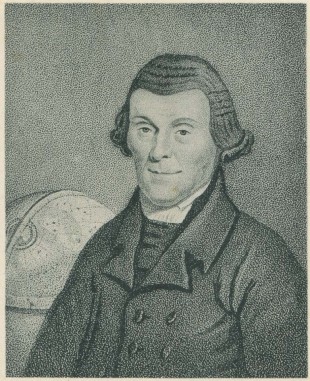
Henry Andrews (1744–1820), who worked as a computer on the Almanac from 1768 to 1815. Reproduced from a photograph of an original etching in the possession of Queen Victoria and published in the form of a postcard by The London Stereoscopic Company in the early twentieth century
We do not know how Pond obtained the information he needed or how he organised things on behalf of the Board as unlike his records relating to chronometers, most of his records relating to the Almanac have not survived (they were possibly destroyed in 1935 along with many of the other records of the Nautical Almanac Office by Leslie Comrie, (Superintendent from 1930–1936), in order to create more office space or by bomb damage to Airy’s New Library where some of the records of the Nautical Almanac Office were stored during the Second World War(Sadler, Personal History p.25 & 55 ). What we do know from the minutes of the Board, is that the key decisions as to who to employ or not to employ were taken by the Board rather than Pond.
Omitted from the minutes of the Board’s meeting held on 7 March, was the fact that a petition (RGO14/11/136) from Mary Edwards was read having been forwarded on her behalf by her friend John Simeon (the member of parliament for Reading) to Charles Yorke, the First Lord of the Admiralty. In it, she asked for her employment as a Computer and Comparer to be continued and also came clean about the fact that Maskelyne had ‘wished her two daughters to assist’ following his introduction of new tables to compute from. We know that the letter was read, because on 8 March, the Board’s Secretary, Thomas Hurd, wrote to Simeon. His letter began as follows:
‘By the desire of Mr Yorke I have to inform you that the Petition of Mrs Mary Edwards was yesterday read at the Board of Longitude and that I am directed to inform her there is no intention of removing the present Computers and Comparers of the Nautical Almanac.’ (RGO14/11/138).
That Edwards thought it necessary to petition the Board at this point does seem rather odd. But perhaps she had been unsettled because she may have received letters from Maskelyne’s daughter Margaret similar to the ones that she had sent to Andrews. In the first of the letters sent to Andrews, (dated 7 February) Margaret said that her father was very ill and ‘and consequently the business of the Nautical Almanac must stand still for the present’ (RGO4/149/51). In the second, which was written two weeks after Maskelyne had died (and which made no mention of what anyone’s future plans were for progressing work on the Almanac), Andrews was asked to send his account so that it could be settled by her mother (RGO4/149/52).
At an extraordinary meeting of the Commissioners held on 16 July 1811, Pond informed the Board that he had received a letter from Mary Edwards
‘who wished to be continued in the role of comparer, to which she was appointed on the death of Mr Hitchins ’till a more sufficient person could be found’ (RGO/14/7/151).
Despite the reassurances she had been given by Yorke just four months previously, her request was rejected (no reason being given) and it was resolved instead to appoint Thomas Brown to the office of Comparer on a full time basis. What the discussion was is not recorded, but what is clear, is that it was the Commissioners collectively rather than Pond who made the decision. Likewise, it was the Commissioners collectively who authorised the printing of the Almanac (this information being printed at the start of each volume (click here to view). Unlike Edwards who had worked on the Almanac for many years, Brown had less than two years experience, having been taken on a part-time basis as a Comparer in July 1809 following his recommendation to Maskelyne by his fellow Commissioner, William Lax. The minutes suggest that the decision to employ him was a personal decision of Maskelyne rather than a Board decision (RGO14/7/135). What is not stated anywhere in the minutes is that Lax was Brown’s brother-in-law. Nor (unsurprisingly) is there any reference to the fact that Lax was Pond’s private tutor at Cambridge. What is stated is that Lax was one of the Commissioners present at the meeting that appointed Brown in favour of Edwards.
Not prepared to take no for an answer, Edwards petitioned again, saying that Maskelyne had promised her that she would continue to have the job of Comparer for half the Almanac, but also confessing that she was not a well woman and that her daughters could do the work assigned to her if illness prevented her from doing so. When her letter (RGO14/11/143) was read to the Board at its next meeting on 5 December 1811, the Board decided that they could not comply with her request, but did agree to give her an extra half years work as a Computer and to pay her for this work at the higher rate paid to the Comparer (RGO/14/7/153). Edwards’ response was to write again and the letter was read at the next meeting, which was held on 5 March 1812. Although its contents were not recorded in the minutes, the minutes (RGO14/7/158) show that the Board resolved:
‘that in consideration of her former services and of an implied promise on the part of the late Astronomer Royal she shall be permitted to compute eight months of each year & to receive for the same 190£ instead of 200£ for computing the whole year.’
The letter is presumed to be the undated petition filed as RGO14/11/147, which was rather more expansive than the two that had been read before and contained many more details of the work she had done and promises that she had made. She also stated that following the letter sent to her on behalf of Yorke on 8 March saying her employment was secure, she had received a letter dated 22 April from Pond saying much the same thing. Following her signature at the end of the petition, Edwards added:
‘Your petitioner [h]as been very ill since February last, whether she will ever be well again God only knows.’
There was no further reference to the Almanac in the Minutes (other than Pond being provided with funds for paying the Computers and Comparer) until the meeting held on 4 March 1813 when a petition (RGO14/11/156) was read from Edwards that had been transmitted to the Board by Simeon, who informed them that he planned to petition the House of Commons on her behalf for a pension (RGO14/7/173). This petition having been read, the Board resolved:
‘that the Secretary be desired to inform Mr Simeon that his Petitioner Mary Edwards has been many years a Computer of the Nautical Almanac and has during that time discharged her duty to the satisfaction of the Board and likewise to add that the Board were ready when called upon to give any further information in their power relative to her merits.’
At the meeting held on 9 June 1813, the Board was asked for its views on the merits of Edwards case (RGO14/7/180 & RGO14/11/163). Although they agreed that she had served the board well, they made the point that in consideration of this,
‘the Commissioners now employed here two daughters in computing the Nautical Almanac even at an extra price.’ (RGO14/7/180 & RGO14/11/163).
They then made the following point:
‘But as it is stated in this Petition that no precedent can be drawn from this single case the Board think it their duty to inform their Lordships that there is another Computer Mr. Andrews who has served them a greater length of time & who from age & infirmity is entirely incapacitated from following his occupation as a Computer and who having no family to assist him might appear to have a stronger claim to remuneration than the present Petitioner.’
Exactly when Edwards died is unclear. Mary Croarken has given two different dates for her death. In 2002, she gave her death year as 1817. In 2003, she wrote that it had proved impossible to trace her exact birth, death, and marriage dates but it was believed that Edwards was born around 1750 and died in September 1815. In 2014, in the chapter that she wrote in the book Maskelyne, she inadvertently gave the year of death as both 1815 and 1817 .
There are very few further references in the minutes to the Nautical Almanac prior to the restructuring of the Board in 1818. They are listed below apart from those authorising the transfer of money to Pond to enable him to pay the Computers and Comparer:
1813 December 2. Agreed that Pond should have Burkhard’s tables of the moon translated for the use of the Computers (RGO14/7/185)
1814 March 3. £50 paid to Thomas Taylor for tables of the moon's places for the years 1790 to 1812 (RGO14/7/189)
1814 December 1. Total pay of Computers increased from £700 to £800 to be paid for by increasing the price of the almanac by one shilling (RGO14/7/194)
1815 March 2. A petition from Henry Andrews dated 25 February (RGO14/11/5) is considered by the Board who recommend that he be considered for an award (RGO14/7/195). An award of £150 was given. (RGO14/1/203)
1815 December 7. Letter received from Mr Becker pointing out errors in the 1814 and 1815 Almanacs for which he is thanked (RGO14/7/205). Following the meeting, the Secretary (Hurd) wrote to Melville, the First Lord of the Admiralty, asking his permission to call an additional meeting of the Board on 28 December in order to furhter investigate what was described as ‘a very considerable error ... in all the printed tables’ (RGO14/3/200). Although there is no mention of the fact in the minutes, it was the Board who had asked Hurd to write. The request was presumably declined since there are no minutes of this date in the Minute Book. Up to this point in time, Melville had only attended one meeting of the Board, and this was on 9 June 1813. He did however attend the next scheduled meeting of the Board on 7 March 1816. There is no mention of the errors in the minutes of that meeting, suggesting either that the matter was not discussed, or that it was asked not to be minuted or that Pond had identified the problem in the meantime. The 1814 and 1815 volumes were both prepared under the superintendence of Maskelyne and published in 1810 and 1811 respectively. The 1814 volume is also known to have been republished in 1814. The two volumes can be viewed here: 1814 volume published in 1810: 1814 volume republished in 1814. Although Becker’s letter does not seem to have survived, the archives do contain copies that he resent of two letters relating to the volumes for 1814, 1815 and 1816 (RGO14/22/73).
1816 December 5. Proposal for an improvement in the construction and arrangement of tables proposed by Garrard (RGO14/7/220). Brinkley’s memoir for clearing the moon’s distance to be printed and annexed to the Nautical Almanac and the salary of the Comparer to be increased (RGO14/7/222)
1817 March 6. Resolved that:
‘the Astronomer Royal be empowered to advance Mrs Edwards [Mary or her daughter Eliza?], one of the Comparers and Calculators of the Nautical Almanac, any Sum not exceeding One hundred pounds, on account of the pecuniary Difficulties under which she laboured’ (RGO14/7/225)
1817 December 4:
‘The Astronomer Royal also Represented that the business of the Royal Observatory had of late so greatly increased that the present Assistants [Taylor & Belville] are unequal to make the required computations many of which are necessary for the Calculations & corrections of the Nautical almanacs;
Resolved that the Board considers this representation highly deserving attention, and requests the Astronomer Royal do to seek an interview with the First Lord of the Admiralty on the subject.’(RGO14/7/238)
According to the minutes for 3 March 1818 (RGO14/7/245), this meeting did not take place. The 3 March meeting was the last to be held by the old Board and was rather curious in that the First Lord, Croker and Barrow were all present, (Croker also attended the meeting on 7 March 1816). The 1818 Longitude Act was introduced in parliament three days later on 6 March.
Pond did not write a preface to the first three volumes produced under his stewardship, but he did write one on 1 January 1817, which was included in those editions of the volumes for the years 1819 and 1820 that were published in 1817 or 1818. In it, he gave a history of the changes that had taken place in the way that the Almanac had been produced since he took over from Maskelyne, suggesting that many of the complaints being levelled against the Almanac and him in particular were erroneous. However, some of what Pond wrote is not entirely consistent with what the Minutes and Maskelyne’s Diary record. Click here to read it.
What is striking is that there is only the one reference (December 1815) in the 1811–1818 minutes to suggest that the Board was aware of problems relating to the accuracy of the Almanac. That nothing more appears to have been done other than to thank Becker for bringing the errors he had identified in the 1814 and 1815 Almanacs (which by then were time expired) to the notice of the Board, suggests that in 1815, neither the Board nor the Admiralty regarded the matter as serious. Nor was there any indication that the Board knew it was about to be reformed – though the presence of the First Lord, Croker and Barrow at the 3 March meeting would surely have signalled that something was amiss. What we don't know is what discussions were taking place behind the scenes (such records may never have existed) nor what communications Pond might have received from the Admiralty on the subject (any records of which appear to have been destroyed).
To get a proper overview of the errors that occurred under Maskelyne and Pond, it would first of all be necessary to analyse the number and nature of the errors corrected by errata in later volumes and then to recompute the data entirely to find the errors not previously identified. Regrettably, this work is beyond the scope and resources of this website.
When Croker introduced the 1818 Act in Parliament, he stated that his object was ‘to replace the board in that state of efficiency in which it ought to be’. We have already seen some of the issues that arose because of the way the Board had been constituted under the earlier acts. Another problem was the absence of any prescribed method of keeping, recording and analysing the accounts so that they could be easily scrutinised and audited by the Board.
At the first meeting of the reconstituted Board, which took place on 5 November 1818, a Committee of Accounts was appointed 'to whom all matters of account' were to be referred. It consisted of three people: the President of the Royal Society, Wollaston and Barrow, and was asked to report the present state of all accounts to the next meeting of the Board on 4 February 1819 (RGO14/7/257).
The Committee met for the first time on 14 November at Banks’ house in Soho Square with Young in attendance as Secretary (RGO14/16/714). What becomes immediately clear from the minutes is that during the period that Hurd had been Secratary to the Board (1810–1818), he had not kept a record of the accounts in a way that was easy for the Board to audit and more importantly, nor had he been asked to. One consequence of this, was that there was no proper review mechanism in place for checking that invoices and accounts had been paid and cleared. As well as finding an apparent failure to minute the clearing of Pond’s accounts for the years 1814 and 1815, Young was also unable to find vouchers from him for the later years. As a result, one of the resolutions the Committee passed was:
‘That the Astronomer Royal be requested to furnish this committee with a statement of the whole of his accounts from the time of his appointment up to the present, with the necessary records as speedily as convenient to him, and that he will inform the secretary how soon he can complete them at the present time’.
The Committee met a total of four times prior to giving its report to the Board. As well as Pond searching though his own records, both he and Young seem to have independently written to most (if not all) of the surviving computers and comparers asking them to send a statement of their account. Of the various replies, just four seem to have survived:
- Brown's reply to Young, dated 10 December, which is a copy of the reply he sent to Pond (RGO14/22/106–107)
- William Dunkin's reply to Young (Sent via Davies Gilbert), dated 9 December (RGO14/22/132)
- Nicholas James' reply to Pond, dated 23 November (RGO14/22/179)
- Richard Martyn's reply to Young, dated 14 December (RGO14/22/189).
The Committee found the accounts to be in order and their report was duly 'approved and confirmed and ordered to be entered on the minutes [of the Board].' At Young's suggestion, the Board agreed that in the future 'all balances for each year should be reported to the meeting of the Board in February and that the Impress should be cleared at that time if possible, the accounts having previously been examined by the committee'. It was also agreed that the committee should be made permanent and that for clarity, the accounts should be presented in a new format that Young had devised (RGO14/7/264). The original copy of the Committee's report is filed as RGO14/2/341.
Additional papers relating to the payments made by Pond to the computers and comparers of the Almanac can be found in RGO14/16/713–740. See also RGO14/19. Although the records are incomplete, there is a sense that Pond did not keep or file his financial records in an entirely systematic manner. But Pond was not unique here. Maskelyne's accounts can be difficult to follow and even Airy failed to keep a list for his own reference of the salary rises awarded to his assistants and the date they had been made. In the 1860’s, he had to resort to combing through the accumulated records of correspondence in order to compile an aide-memoir to assist him in developing his plans for reforming the assistants’ pay. His use of the phrase: ‘1846 Nov 28 seems to be the same’, suggests this was easier said than done. (RGO6/76/31&32).
The precise wording of Clause xxi of the 1818 Longitude Act was as follows:
‘And whereas it is necessary to continue the Appointment of a Secretary to the Board of Commissioners for discovering the Longitude: And whereas it is highly expedient to the Interests of Navigation, and the Honour of this Country, that the said Nautical Almanack should be accurately computed, compared, and published, and that the Method of finding the Longitude by Timekeepers should also be encouraged; and that the Timekeepers belonging to His Majesty for the Use of His Ships of War should be carefully examined and regulated; be it further enacted, That some Person of competent Skill and Ability shall be nominated and appointed by the Lord High Admiral or Commissioners of the Admiralty to be Secretary to the said Board of Commissioners, and for superintending, under the Directions of the Board in general, and the Astronomer Royal in particular, the due and correct Publication of the Nautical Almanack, and for taking care of and regulating such Timekeepers as may be intrusted to his care by the Lord High Admiral or Commissioners of the Admiralty.’
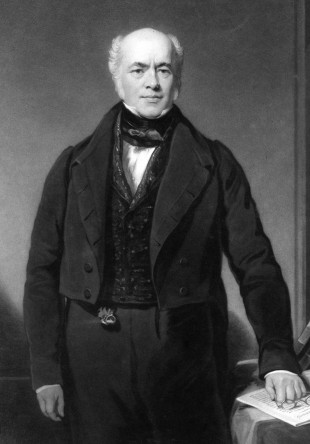
Francis Baily, c.1829. Engraving by Thomas Lupton after Thomas Phillips. Cropped and reproduced under the terms of a Creative Commons Attribution 4.0 International (CC BY 4.0) license courtesy of the University of Cambridge, Institute of Astronomy Library
Yet Young was not a free agent. Under Clause xxi, he was to work ‘under the Directions of the Board in general, and the Astronomer Royal in particular’. Whatever Young may or may not have thought, control of the Board of Longitude was very much in the hands of the Admiralty and the Royal Society, both of whom resisted change. Indeed, the 1818 act had strengthened the role of the Royal Society by appointing additional fellows of the Society as Board members. More importantly, although the number of Commissioners who needed to attend for the meetings to be quorate remained at five, clause xxvii specified for the first time:
‘that at every such Board one of the following Commissioners at the least shall be present; this is to say, the First or one of the Commissioners [of the Admiralty], or One of the Secretaries of the Admiralty; and also Three of the following Commissioners at the least shall be present, this is to say, the President of the Royal Society, the Astronomer Royal, the Professors and Observer at the Two Universities, and the Three Commissioners annually elected and receiving Salaries as aforesaid.’
In other words, the real power of the reformed Board lay with the Admiralty, and more specifically with its Secretaries, one or other and sometimes both of whom were present at all the meetings of the reformed board with the single exception of the meeting held on 1 June 1820. As for Pond, whatever his feelings, as in so many things, he seems to have kept quiet and gone with the flow.
On 15 July 1828, the Board of longitude was dissolved by Parliament with the passing of An Act for repealing the Laws now in force relating to the Discovery of Longitude. Clause ii of the act began as follows:
‘And whereas the Publication of the Nautical Almanack, constructed by proper Persons for the finding of the Longitude at Sea, is of great Importance to the Safety of Ships and Persons, and highly conducive to the general Interests of Commerce and Navigation; be it therefore, enacted, That it shall and may be lawful to and for the Lord High Admiral, or the Commissioners for executing the Office of Lord High Admiral of the United Kingdom of Great Britain and Ireland, for the Time being, to cause such Nautical Almanacks, or other useful Table or Tables, which he or they shall from Time to Time judge necessary and useful in order to facilitate the Method of discovering the Longitude at Sea, to be constructed, printed, published, and vended, free of all Stamp Duty whatever, in the same manner as the Commissioners under the said act of the Fifty-eighth year of his late Majesty’s Reign...’
When Young died suddenly on 10 May 1829, Airy sensed an opportunity not only to push though the reforms desired by the astronomers, but to increase his income as well. In his autobiography he records:
‘In a few days after Dr Young died: I applied to Lord Melville for the superintendence of the Nautical Almanac: Mr Croker replied that it devolved legally upon the Astronomer Royal’.
On what basis it was supposed to devolve legally upon the Astronomer Royal is unclear, since the 1828 Repeal Act made no mention of the Post of Superintendent, but did say the following about the Almanac:
‘And Whereas the Publication of the Nautical Almanack, constructed by proper Persons for the finding of the Longitude at Sea, is of great Importance to the Safety of Ships and Persons, and highly conducive to the general Interests of Commerce and Navigation; Be it therefore enacted, That it shall and may be lawful to and for the Lord High Admiral, or the Commissioners for executing the Admiral may Office of Lord High Admiral of the United Kingdom of Great Britain and Ireland, for the Time being, to cause such Nautical Almanacks, or other useful Table or Tables, which he or they shall from time to time judge necessary and useful in order to facilitate the Method of discovering the Longitude at Sea, to be constructed, printed, published, and vended, free of all Stamp Duty whatever, in the same Manner as the Commissioners under the said Act of the Fifty-eighth Year of His late Majesty’s Reign …’
And so, whatever the legal position, Pond was again tasked with having to oversee the production of the Almanac. That the responsibility was handed back to Pond should come as no surprise. Young was only 55 when he unexpectedly died. There had been no succession planning and time was of the essence. We do not know how the Admiralty came to their decision, but things that were taken into account are likely to have included the following:
- Pond was familiar with the procedures necessary to produce the Almanac.
- The wants of the astronomers calling for reform could no longer be resisted.
- Those most vocal in campaigning for reform of the Almanac had been so vicious in their attacks on Young that appointing one of them was only likely to lead to further division as the reformers argued amongst themselves about what should be included and why they hadn’t been offered the post.
- Airy was still a relative unknown, having only attended his first meeting of the Board of Longitude in 1827 and having been appointed the Director of the Cambridge Observatory in 1828. He was in any case associated with the reformers and therefore not a wise choice at this time.
- The Computers and Comparers lacked the astronomical and mathematical knowledge to take on the post, were scattered around the country and were not figures who were generally known in scientific circles.
That the responsibility was handed to Pond does suggest that the Admiralty considered him a competent person, reinforcing the view that the problems that arose between 1811 and 1818 were not ones of his making.
The Navy Estimates for 1830 indicate that Pond was not paid the allowance of £300 that Young had been paid. They include the following note against the Salary of the Superintendent: ‘Omitted in the Estimates for 1830 p Admiralty order 23rd. Dec. 1829’. Nor was the salary allowed for in the 1831 estimates (ADM181/39&40). Why the allowance was withheld is not known.
Amongst the papers of the Board of Longitude is a short letter, dated 22 October 1829, from John Barrow to Edward Sabine (RGO14/22/103). Its contents were as follows:
‘My Lords Commissioners of the Admiralty having charged John Pond Esqr the Astronomer Royal with the superintendance of the Nautical Almanac and to keep a regular and separate Account of the Receipts and disbursements regarding the Publication thereof which Account is to be transmitted for examination at the end of each year, I am commanded by their Lordships to acquaint you therewith and to request that you will in conjunction with myself examine this account of the Astronomer Royal from time to time, on receiving notice thereof.’
Sophie Waring, who, as quoted above, charged Pond with neglecting the Almanac when he had previously been responsible of overseeing its production and considered him a poor administrator, had the following to say about Pond’s reappointment and the above letter (Cambridge Digital Library ES-LON-00018/1):
‘the choice of superintendent of the Nautical Almanac after the death of Young was debated in correspondence between John Barrow and Edward Sabine when Barrow expressed concern over Pond’s suitability for the task and askes for Sabine’s help in the periodic examination of the accounts of the Nautical Almanac produced by Pond. The Nautical Almanac did pass back to Pond as Astronomer Royal in 1829; this was a piece of political manoeuvring to keep the Nautical Almanac close to the Admiralty Board and The Royal Society, perhaps even at the cost of Pond regaining the editorship.’
Since there appears to be only the one letter on the subject preserved in the archive (and it was not sent until five months after Young’s death (RGO14/22/103)), it seems fanciful to believe that any discussion about Young’s successor took place between Barrow and Sabine. During the existence of the Board of Longitude, the Commissioners were tasked with examining the accounts relating to the Almanac. That the accounts still needed to be scrutinised after the abolition of the Board should come as no surprise. The choice of Sabine to assist Barrow is also not surprising, since Sabine was one of three salaried scientific advisers appointed to advise the Admiralty when the Board of Longitude was abolished. He had also carried out pendulum experiments at the Observatory in 1828 and was shortly to start a new series of observations there. Whilst it is true that Pond’s reappointment kept the Almanac close to the Admiralty Board and Royal Society, it is a matter of conjecture as to whether this was the reason that he was reappointed.
Meanwhile, in a letter dated 28 July 1830, the Admiralty had invited the (Royal) Astronomical Society to advise on introducing the reforms that the astronomers wanted. It began as follows (RAS Council Minutes, Vol.II, pp.191–192 via Waring PhD (2014)).
‘My Lords Commissioners of the Admiralty having given directions to the Astronomer Royal, who for the present is charged with the Superintendence of the Nautical Almanac, to insert certain additions proposed by their late Hydrographer, Sir Edward Parry, and not objected to by certain members of your society to whom they were communicated by Lord Melville. I am now commanded by their Lordships to send for your inspection a copy of the proposed improvements for one month of the year 1833 …’
Rather than quote the letter directly, on page 60 of the History of the Royal Astronomical Society: 1820–1920, (1923), Dryer summarised the contents, saying that it:
‘stated that directions had been given to the Astronomer Royal, who was in temporary charge of the Nautical Almanac, to insert certain additions proposed by the late Hydrographer ...’.
No evidence has yet emerged that Pond’s appointment was intended by the Admiralty to be only temporary, though the Admiralty did have form in this area for stripping individuals of posts and reassigning them to others (the post of Secretary to the Board of Longitude was transferred from Hurd to Young in 1818 and the post of Superintendent of Chronometers from Hurd to Pond in 1821). The events that occurred during the six months following his appointment give no cause to believe that it had been intended to be anything but permanent ... or at least more permanent than it turned out to be.
Following the receipt of the Admiralty letter a committee consisting of 40 members of the (Royal) Astronomical Society was formed to consider the matter. Its report, which was adopted by the Council of the Society on 19 November 1830, ended with the following paragraph:
‘They [the committee] likewise consider it their duty to notice the constant attendance of the Astronomer Royal at their meetings; the readiness with which he afforded them every information relative to the various subjects that came under consideration; and the zeal with which he entered into all their views for improving this national work.’
The report’s recommendations were accepted by the Admiralty who ordered Pond to make certain changes to the Almanac. There are two letters from Pond in relation to this preserved in the archives of the UK Hydrographic office. In the first (LP 1857 15/P), which is dated 7 Dec 1830, Pond said he was endeavouring to ascertain how much of the Nautical Almanac could be accomplished with the present resources. In the second, (LP 1857 18/P), which is dated 13 Jan 1831, he sought the Hydrographer’s advice about reorganising the arrangements for producing the Almanac.
Exactly what happened next is unclear. The new Board of Observatory Visitors containing fellows of the Royal Astronomical Society met for the first time on 19 January 1831 and immediately began to flex its muscles. At the third meeting of the Board, which was held a few weeks later on 4 March, a letter, dated 1 March, from John Barrow at the Admiralty to the Chairman was read, together with a copy of an enclosed memorandum to which it referred (ADM190/4/18–23). The key message of the memorandum (which was dated 17 February and had been sent to Barrow) was that because of the considerable extra work now required in preparing the Almanac, it seemed impossible that Pond could conduct it consistently with his duties as Astronomer Royal and that a separate Superintendent should be appointed. The accompanying letter from Barrow asked for the Board’s views on the matter and prompted the following resolution to be passed (ADM190/4/23).
‘That it is the opinion of this Board that the duty of Superintendent of the Nautical Almanac should be separated from the office of Astronomer Royal.’
Although the minutes give the full text of the memorandum, they do not state who the author was, nor who had sent it. It seems highly probable however that it came from certain fellows (the Council?) of the Royal Astronomical Society, in an attempt to install a man of their own into the post. The evidence for this is contained in two letters sent, just before the 4 March meeting of the Board, by the Society’s Secretary, William Stratford, to John Herschel. In the first, dated 2 March, Stratford asked Herschel to join with James South in recommending him (Stratford) for the post (RS:HS 17.84). In the second, dated 3 March, he asked Herschel to send a letter recommending him for the post to the Duke of Sussex, (who was President of the Royal Society and Chairman of the Board) (RS:HS 17.85). Soon after, Stratford was appointed as the new Superintendent on a salary of £300 and Pond was relieved of this responsibility once again. For a further description of these manoeuvrings, see Sheepshanks: A letter to the Board of Visitors p.47, (1854)
The volume of the Almanac for 1833 was the last volume to be published while Pond was still acting as Superintendent. It is also the only volume, apart from that for the year 1820, for which he wrote a preface. The preface to the volume for 1834 (which runs to eleven pages) sets out in some detail, information about the tables used at different periods when computing the earlier volumes of the Almanac.
The story of the Almanac under Thomas Young is complex and has been looked into many times over the years. For a general overview from the reformers perspective see:
History of the Royal Astronomical Society: 1820–1920, pp.55–63 (1923)
Other sources include:
Remarks on the present defective state of the Nautical Almanac. Francis Baily (1822)
Practical Observations on the Nautical Almanac and Astronomical Ephemeris. James South (1822)
Reply to a letter in the Morning Chronicle ... . James South (1829)
Further Remarks on the present defective state of the Nautical Almanac. Francis Baily (1829)
Visitors of the Royal Observatory at Greenwich Minute Book, (entry for 3 March 1831)
Life of Thomas Young. George Peacock (1855)
Thomas Young. Natural Philosopher 1773–1829. Alex Wood (1954)
Thomas Young as a Civil Servant. Edmund Dews (1954) – this is Appendix 2 of Wood’s book above
The Bicentenary of the Nautical Almanac. Sadler, D. H. QJRAS, Vol.8 pp.167–168 (1967)
Thomas Young, The Board of Longitude and the age of reform. Unpublished PhD. Sophie Waring (2014)
The Board of Longitude in the early nineteenth-century: negotiating authority and expertise. Sophie Waring, Journal of Maritime Research (2014)
An 18th-century astronomical hub in west Cornwall. Carolyn Kennett, Antiquarian Astronomer, 2017, Issue 11, p. 45–54
As a postscript to this section, a comment from Airy's 1839 Repot to the Board of Vistitors is reproduced below. In it he makes the often overlooked point that a considerable amount of time was spent comparing the observations of the Sun and Planets, but more particularly those of the Moon, with the existing tables, and the special investigations founded on them for the improvement of particular points of the tables. Thomas Glanville Taylor was employed by Young to do this prior to him becoming an Assistant at the Observatory in 1822 (RGO14/19/190 & RGO14/20/525):
‘I am, however, extremely glad that I have thus been compelled to become acquainted with the system and general practice of my predecessors: and my estimation of their judgment and order, as well as of their industry, has been greatly raised. During the whole, or nearly the whole of Dr. Maskelyne's time, the daily observations of stars are reduced in Ledger, and the solstices and equinoxes of each year are discussed, with as great regularity as at the present time: and the same is done with equal regularity, and on a more extended scale, through Mr. Pond's time. The observations of the Sun and Planets, but more particularly those of the Moon, are, through a great part of Dr. Maskelyne's time, most laboriously compared with the existing tables, and special investigations are founded on them for the improvement of particular points of the tables. The computations last mentioned probably belonged rather to the Board of Longitude than to the Royal Observatory. The impression which the perusal of these papers has left on my mind is, that from these the true state of the heavens as regards the main points of the Sun's path, the Moon's path, and the places of the fundamental stars - may be gathered more accurately and more certainly than from any system of interpolation like that pursued by the illustrious author of the Tabulæ Regiomontanæ [Bessel].’
The pulping of volumes of Greenwich Observations and a diatribe from Charles Babbage
Due to a precedent set in Maskelyne’s time, 60 copies of the annual observations were distributed to those named on a list maintained by the Royal Society, the remainder being delivered to Pond as Astronomer Royal to do with what he wished. In Pond’s case, it appears that this was to eventually sell some to a shop in Thames Street (Greenwich) as waste paper for pulping and conversion into pasteboard. The matter first came to light at a meeting of Council of the Royal Society on 21 December 1826 (RGO6/22/181). When the Board of Visitors was reformed in 1830, Pond’s right to the remaining copies was removed under a clause in the Royal Warrant (RS MS371/68) that stated:
‘And when our said Astronomer and the Council of Our Royal Society and of the Astronomical Society shall have been supplied with as many copies as they may desire to distribute for the benefit of Science the remainder shall be sold at such price as the Lord High Admiral or the Commissioners for executing the Office of Lord High Admiral shall fix’
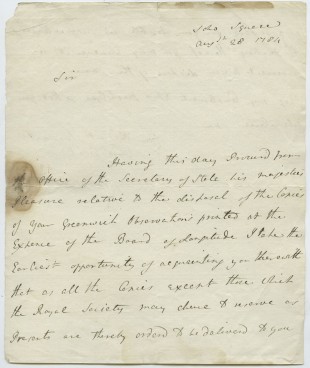
Letter (dated 28 August 1784) from Joseph Banks to Maskylene giving him possession of all the printed and future copies of Greeenwich Observations except those earmarked for the Royal Society. (See also RS MS600/32)
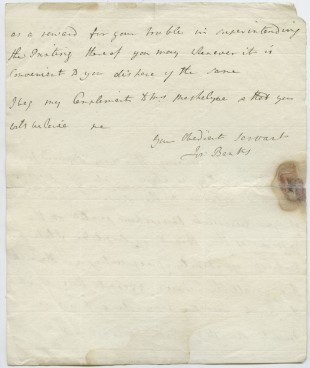
Collection of papers relating to Nevil Maskelyne. REG09-000037. Reproduced under the terms of a Creative Commons Attribution-Non-Commercial 3.0 Unported License (CC BY-NC 3.0) courtesy of Cambridge Digital Library (see below)
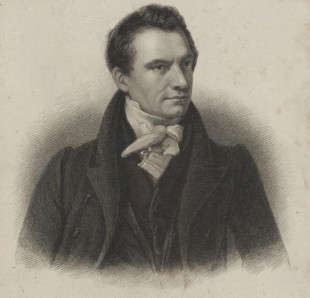
Charles Babbage, Lucasian Professor of Mathematics at Cambridge. Engraved by Roffe from an original family painting and published on 1 May 1833 by M Salmon, Mechanics Magazine Office. Cropped, cleaned and reproduced under a creative commons Public Domain Mark 1.0 licence courtesy of Llyfrgell Genedlaethol Cymru – The National Library of Wales
Another of Babbage’s complaints was about the vesting of several offices in one person. To illustrate the point, he chose as one of his examples (p.100), the case of Pond, who through no fault of his own, had simultaneously held the three posts of: Astronomer Royal, Superintendent (misstated as Inspector) of Chronometers and Superintendent of the Nautical Almanac.
Babbage also turned his fire on the way that the Copley Medal was awarded. Particularly damaging to Pond in the centuries that followed was Babbage’s decision to quote in a footnote part of Pond’s 1826 letter to Wollaston that he had found transcribed (in full) into the Council minutes:
‘But to carry on such I want indefatigable hard-working and above all obedient drudges (for so I must call them, though they are drudges of a superior order), men who will be contented to pass half their day in using their hands and eyes in the mechanical act of observing, and the remainder of it in the dull process of calculation.’
This particular sentence has been much quoted ever since, but rarely (if ever) in the context of the whole of the letter of which it formed a part.
Babbage also made the point that although the list of the Officers, Council and Members was printed annually (p.193), it was never bound with the volumes of Philosophical Transactions. This was, and remains an unfortunate omission as even today in the age of the internet, it is not easy to find out who these individuals were at different times. As an appendix to the book, Babbage produced a table listing those fellows who had contributed to Philosophical Transactions (up to 1830) or those who had served on the Council (up to 1827). While most Council members had served for periods of three years or less, a small handful were listed as having served for 10 years or more. Pond stands out as the second longest serving member at 17 years. On this, Babbage commented (p.151)
‘Another situation, in the patronage of which the President is known to have considerable influence, is that of Astronomer Royal; and it is to be observed, that he is kept in the Council as much as possible, notwithstanding the nature of his duties.’
Babbage became one of the Observatory’s Visitors in 1830 when the Board of Visitors was reformed. Despite his earlier criticisms, Babbage remained on the Board for 41 years until his death in 1871.
Click here for a transcript of what Babbage wrote about the pulping of volumes of the Greenwich Observations.
Click here for The Royal Society list of those entitled to a copy of Greenwich Observations in 1828. The Royal Astronomical Society (formed in 1820) also maintained a separate list of those entitled to a copy.
Click here for the Royal Astronomical Society list of list of those entitled to a copy of Greenwich Observations in 1833.
James South, friend or foe?
Seemingly an admirer and supporter of Pond in the 1810s and 20s, James South turned against him in the 1830s.
Born in 1785, South was the eldest son of a prosperous dispensing chemist in Southwark. Trained as a surgeon, South also had an interest in astronomy. Following his marriage to an heiress in 1816, he was able to abandon surgery and pursue his interests in astronomy full-time. Between 1821 and 1823, he collaborated with John Herschel in a joint observing programme of double stars at his observatory in Blackman Street. Their subsequent catalogue of 390 double stars won them various medals, including the gold medal of the Royal Astronomical Society in 1826.
South used his wealth to acquire trophy instruments that had once belonged to other astronomers including the Westbury Circle which he acquired in late 1822 (more on this below) and the Groombridge Transit Circle which he acquired soon after. The Westbury Circle, which came from the Garnet Hill Observatory in Glasgow, required considerable repair to bring it back to working order and during its restoration was inscribed with a tribute to both Troughton and Pond (more details on this below).
On 15 February 1821, South was elected a fellow of the Royal Society amongst his proposers were Pond, Troughton and Groombridge (click here to view his nomination form). Five years later, in 1826, he was awarded the Society’s Copley Medal for observations made in France. Such was his prestige, that on 10 July 1830 he was offered a pension of £300 a year from the civil list and also a knighthood which was conferred two weeks later on 21 July (The Times, 1830).
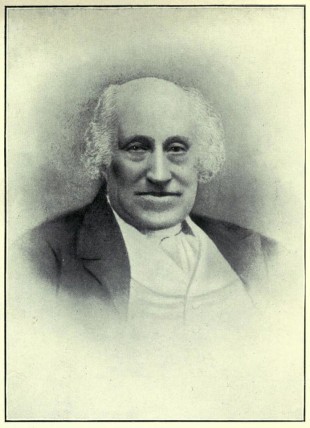
Sir James South (1785-1867). By the early 1830s South had managed to fall out with most of his peers, attacking both Pond and his successor George Airy. From History of the Royal Astronomical Society, Volume 1 (1923)
South was one of the founders of the (Royal) Astronomical Society and as we have already seen, a vocal proponent for the reform of the Nautical Almanac throughout the 1820s. In this matter, his ire was directed not at Pond, of whom he seems to have been supportive, but at Thomas Young. In a series of letters about the state of the Almanac that were published in the Morning Chronicle at the end of 1828 (and then published in book form in early 1829), South was to write:
‘I challenge him, to name me one man, at that time, in His Majesty's dominions, who had more claim to the vacant post, than he, whose Observations at Westbury, made with his own instrument, and at his own expense, without any Government aid, or subsequent gratuity (for this has of late come into fashion), demonstrated what foreign astronomers had long suspected, but could not prove, namely, that an alteration of figure had impaired the accuracy of the Greenwich Mural Quadrant. Ill health, disinclination, or perhaps inability, to mix in the instructive eating and drinking parties of the [Royal] Society, and a determination to resist an Admiralty scheme (of providing gentlemen Observers with salaries of 400l. or 500l. a year), which, in his opinion, if carried into effect, would have destroyed the practical utility of the Observatory, has, among a certain set, and in certain quarters, perhaps rendered him somewhat unpopular; he has, however, the satisfaction of knowing, that he has averted from our Observatory, a calamity similar to that of which the Observatory of a neighbouring country has long felt the curse.
…
.... I envy not the generous feeling of any one, be he who he may, who can designate 600l. a year, and a little hovel to live in, with no retiring pension, no provision for an unprovided widow, as a handsome salary for the Astronomer Royal of Great Britain. It is a niggardly provision, and justifiable only on the grounds, that were it larger it would more likely be bartered for Parliamentary Interest than be given, as it hitherto has been, to distinguished merit.’
When the Observatory's Board of Visitors was reconstituted at the end of 1830, South became a Visitor for the first time. Airy records in his autobiography that at a meeting of the new Board in January 1831 (presumed to be the second meeting held on 21 January, to which Pond is known to have been invited (ADM190/7/1):
‘Mr Pond, the Astronomer Royal, was in a rather feeble state, and South seemed determined to bear him down: Sheepshanks and I did our best to support him.’
Writing seemingly about the same incident in 1854, Sheepshanks wrote:
‘I was defending my friend the Astronomer Royal, Pond, who was worn out and in delicate health, from the attacks of a person who had not the least notion of Pond’s merits and services, and who could no more have given an account of the system of observation pursued at Greenwich, than he could compute a place of the moon.’
Despite this, Pond and South cooperated that same year in rocket experiments to determine the difference in longitude between South’s new Observatory in Kensington, and the Observatory at Greenwich (RGO5/216 & RAS: Observations and papers of Sir James South),
Meanwhile, back in February 1829, South had been elected president of the Astronomical Society and Richard Sheepshanks its Secretary. Like South, Sheepshanks was both independently wealthy and not afraid to speak his mind. Their election marked the start of a lifelong and bitter war of words between the two of them.
During his Presidential Address in 1830, when presenting William Richardson with the Society’s Gold medal, South alluded to the fact that before joining the staff of the Royal Observatory in August 1822, Richardson had spent time working for him at his observatory in Blackman Street. South also described Richardson as Pond’s right hand man and referred to ‘the miserable pittance’ paid to him by the Government as being insufficient to maintain his family.
Things turned really sour between South and Sheepshanks when a delay in securing a Royal Charter for the Astronomical Society, which had been initiated by South, led to a constitutional crisis which Sheephanks exploited to effectively hound him out of the Society. The feuding got even worse when dissatisfied with the mounting that Troughton had made for the Cauchoix objective, South refused to pay the bill and Sheepshanks encouraged Troughton to bring an action against him. The case eventually went to arbitration in 1834 with Pond appearing as an expert witness and making an examination of the instrument on 25 July that year.
A couple of months earlier, the Admiralty had begun taking soundings on replacing Pond as Astronomer Royal (see below). Part of the discussion seems to have centred on the size of any retiring pension that Pond might be offered if he were willing to go. At the end of June, Captain Beaufort, the Hydrographer of the Navy and a member of the new Board of Visitors, wrote to South (though in what capacity is unclear) seemingly to solicit his views as to whether Pond should be retired on his full pay in the light of ‘His Efforts in the Cause of Astronomy’. Replying on 1 July, South declined to lend his support, going on to say ‘The Observatory at Greenwich during his AstronomerRoyal-ship has been an object of pity’ as well as making an allegation of misconduct by Pond in regard to one of the Assistants. Although South alluded to letters on this matter that he had previously sent to Beaufort, he declined to include either the name of the Assistant, or repeat any details of the supposed misdemeanour by Pond. He did however mention that the ‘Reverend Slanderer’ was behind it, which is presumed to be a reference to Sheepshanks (who had been ordained) (UKHO LP 1857 52/S).
South and Sheepshanks were complex individuals and to date, nobody has made an in-depth study of how their feuding impacted the running of the Observatory at Greenwich under Pond and his successor Airy. Pond however was not alone in finding South turning against him as Sheepshanks was to note in 1854:
‘My vehement indignation was first roused by his [South’s] conduct towards Dr. Thomas Young, the most extraordinary man of the past generation. But there is scarcely an eminent astronomer, either English or foreign, whom this person, who cannot solve a plane triangle, has not insulted with his abuse at one time, and his praise at another. Young, Pond, Troughton, Pearson, Fallows, Baily, Stratford, Davies Gilbert, Kater, Woodhouse, among the dead ; Herschel and Airy among the living. His first appearance was in the character of “a British lion,” insisting that all the world should perform kootoo before the Greenwich Observatory and Troughton. He then took a Gallomania, and prated of Laplace, and Arago, and Gambey. Then came a German and Russian fever, and he became the worshipper of Bessel and Struve, whom heretofore he had held in small esteem. What right has a person of Sir James South’s talents and acquirements to express any opinion about such men at all? I do not understand, and I trust shall never practise, the good manners which teach you to sit quietly by, when high and honourable men are assailed; and I think, and shall continue to think, that politeness of this kind arises from moral cowardice, and no better principle.’
Resignation and the appointment of Airy as Astronomer Royal
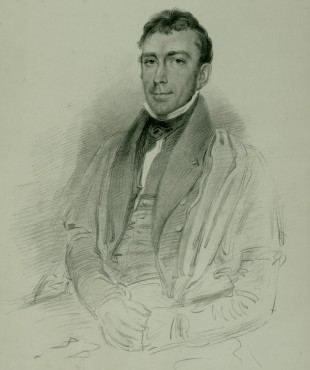
George Airy in 1833 by Isaac Ware Slater, after Thomas Charles Wageman. Lithograph on chine collé published by W Mason, Cambridge & WH Mason, print sellers to the Queen Brighton. Cropped, digitally cleaned and reproduced under the terms of a Creative Commons Attribution 4.0 International (CC BY 4.0) licence courtesy of the University of Cambridge, Institute of Astronomy Library
The resignation of an Astronomer Royal was unprecedented. All five of Pond’s predecessors died in post – Flamsteed at the age of 73, Halley at the age of 85, Bradley at the age of 69, Bliss at the age of 63 and Maskelyne at the age of 78. In 1835, Pond was just 67 years old. There was no established process for an Astronomer Royal to retire, or to be removed from office, or to be awarded a pension.
Pond’s health had never been good. As early as December 1818 there was speculation that his post might soon become vacant. Charles Babbage thought that John Herschel would be a good candidate, but at that time, Herschel did not think himself qualified. Five years later, at the end of 1823, there was again speculation that Pond might resign, partly because of his health and partly because of his resistance to the imposition at the Observatory of a new superior class of Assistant with a university education. At this point, Herschel declared to James South, that were the post of Astronomer Royal to become vacant, he would be ‘anything but disinclined to offer myself for it’. He followed this up by saying that although he would be interested in the post if it were to become vacant, he would not wish to work with Stephen Lee, who was apparently then under consideration for appointment as one of the superior Assistants (RS Herschel correspondence, RS:HS 2.100, HS 16.424, HS 16.425, HS 16.426a (C: 20.173), HS 2.192).
As mentioned above in his letter about the state of the Nautical Almanac published in the Morning Chronicle on 12 December 1828, James South wrote:
‘... the British Government gives the Astronomer Royal 660l [£], a year, and a miserable hovel to live in, without any retiring pension, or any pension to his widow, In case she survives him’.
That South should have made such a statement at this time, does suggest that the speculation that Pond might resign was well founded ... and that perhaps what stopped him was the fact that he would have had to resign without a pension.
Having taken charge of the Cambridge Observatory in 1828, Airy had rapidly gained a reputation for its efficient running, causing Herschel to change his tune. In 1831, he told William Stratford that if the position of Astronomer Royal should become vacant, he believed that Airy would be interested and that he would gladly support such a candidacy (RS:HS 25.1.32).
Also in 1831, when Pond was convalescing in Hastings, towards the end of his stay, he wrote in a letter (dated 9 October) to Captain Beaufort at the Admiralty,
‘I fear my wish for tranquil retirement cann[ot] be indulged in which case I shall stand in need of the support of all my friends, and on none do I rely with greater confidence that in yourself.’ (UKHO LP 1857 17/P).
In the absence of materials that document the events leading up to Pond’s resignation from his own perspective, it is necessary instead to look at events solely from Airy’s. It would appear that the process of recruiting him began in May 1834, more than a year before Pond left office.
That the process took so long was due in most part to the fact that there were several changes of Government between when the process started and when it ended in 1835. The following table is a summary.
| Admin. | Prime Minister | Dates | First Lord of Admiralty | Dates | |
| Whig | Grey | 1830 Nov–1834 Jul | Sir James Graham Lord Aukland |
1830 Nov–1834 Jun 1834 Jun–1834 Jul |
|
| Whig | Melbourne | 1834 Jul–1834 Nov | Lord Aukland |
1834 Jul–1834 Nov | |
| Tory | Wellington (caretaker) | 1834 Nov–1834 Dec | |||
| Tory | Peel | 1834 Dec–1835 Apr |
Grey |
1834 Dec–1835 Apr | |
| Whig | Melbourne | 1835 Apr–1839 Aug | Lord Aukland Earl of Minto |
1835 Apr–1835 Sep 1835 Sep–1839 Aug |
The following extracts are taken from Airy’s autobiography. They are based on notes in his Cambridge journal and correspondence now preserved in the archives (RGO6/1/144 onwards)
‘On May 10th [1834] I went to London, I believe to attend one of the Soirées which the Duke of Sussex gave as President of the Royal Society. The Duke [who was also the chairman of the Observatory’s Board of Vistitors] invited me to breakfast privately with him the next morning. He then spoke to me, on the part of the Government, about my taking the office of Astronomer Royal. On May 19th I wrote him a semi-official letter, to which reference was made in subsequent correspondence on that subject. ... On Aug. 25th Mr Spring Rice (Lord Monteagle) [the Member of Parliament for Cambridge & Secretary of State for War and the Colonies since 5 June & before that Financial Secretary to the Treasury] wrote to me to enquire whether I would accept the office of Astronomer Royal if it were vacant. I replied (from Keswick) on Aug. 30th, expressing my general willingness, stipulating for my freedom of vote, &c., and referring to my letter to the Duke of Sussex. On Oct. 8th Lord Auckland, First Lord of the Admiralty, wrote: and on Oct. 10th I provisionally accepted the office. On Oct. 30th I wrote to ask for leave to give a course of lectures at Cambridge in case that my successor at Cambridge should find difficulty in doing it in the first year: and to this Lord Auckland assented on Oct. 31st. All this arrangement was for a time upset by the change of Ministry which shortly followed.
... in dining with the Duke of Sussex in the last year, I had been introduced to Sir R. Peel, and he had conversed with me a long time, and appeared to have heard favourably of me. On Feb. 17th [1835] he wrote to me an autograph letter offering a pension of £300 per annum, with no terms of any kind, and allowing it to be settled if I should think fit on my wife. I wrote on Feb. 18th accepting it for my wife. In a few days the matter went through the formal steps, and Mr Whewell and Mr Sheepshanks were nominated trustees for my wife. The subject came before Parliament [on 16 March], by the Whig Party vindicating their own propriety in having offered me the office of Astronomer Royal in the preceding year; and Spring Rice’s letter then written to me was published in the Times, &c.
The Ministry had been again changed in the spring [of 1835], and the Whigs were again in power. On June 11th Lord Auckland, who was again First Lord of the Admiralty (as last year), again wrote to me to offer me the office of Astronomer Royal, or to request my suggestions on the filling up of the office. On June 15th I wrote my first reply, and on June 17th wrote to accept it. On June 18th Lord Auckland acknowledges, and on June 22nd the King approved. Lord Auckland appointed to see me on Friday, June 23rd, but I was unwell. I had various correspondence with Lord Auckland, principally about buildings, and had an appointment with him for August 13th. As Lord Auckland was just quitting office, to go to India, I was introduced to Mr Charles Wood, the Secretary of the Admiralty, with whom principally the subsequent business was transacted. At this meeting Lord Auckland and Mr Wood expressed their feeling, that the Observatory had fallen into such a state of disrepute that the whole establishment ought to be cleared out. I represented that I could make it efficient with a good First Assistant; and the other Assistants were kept. But the establishment was in a queer state. The Royal Warrant under the Sign Manual was sent on August 11th. It was understood that my occupation of office would commence on October 1st, but repairs and alterations of buildings would make it impossible for me to reside at Greenwich before the end of the year. On Oct. 1st I went to the Observatory, and entered formally upon the office (though not residing for some time). Oct 7th is the date of my Official Instructions.
I had made it a condition of accepting the office that the then First Assistant should be removed, and accordingly I had the charge of seeking another. I determined to have a man who had taken a respectable Cambridge degree.’
The text of Spring Rice’s letter as recorded in Hansard was as follows. In all material respects it is identical to the original (RGO6/1/147):
Downing-street, August 25, 1834.
MY DEAR SIR.—It is highly probable that a vacancy may take place very shortly in the office of Astronomer Royal. If this event occur[s], it will be of course the duty and the object of the Government to make such a selection as shall be most conducive to the interest of science, and as shall secure to our national astronomical establishment and its observations, the greatest respect and authority throughout Europe. On these principles it is more than natural that the Government should be desirous of knowing whether the appointment is one which you would accept; as it would be most gratifying to us all to have an opportunity of marking the admiration which we feel for your eminent attainments, and the respect which is justly due to your character as an individual. As a Cambridge man, I am fully aware that to our University the loss of one of its greatest ornaments cannot but be felt as irreparable; but we ought not to be selfish, we should think of England as well as of Cambridge; and I trust there is not one of our scientific friends who will not feel that in selecting a new Astronomer Royal, it is towards you that the earliest attention of his Majesty's Government should be directed, less in justice to science, than to the credit and character of the country.
Pray let me hear from you at your earliest convenience, and believe me, &c.
T. SPRING RICE,
To rev. Professor Airy, Cambridge.
Meanwhile, back on 1 July 1834, James South had written scathingly about Pond in reply to a letter from Francis Beaufort in which Beaufort appears to have been seeking South’s support in favour of Pond being awarded a retirement a pension equal in size to his salary (£600 a year) (UKHO/LP 1857 52/S). South declined to lend his support, and seems to imply in his letter that Beaufort had been pursuing a pension for Pond for at least the past few months. South wrote:
‘“His Efforts in the Cause of Astronomy”!!! for the last 23 years may have been considerable; but I declare a knowledge of them has not yet reached me, in a form sufficiently authentic to warrant any certificate from me – That a long Catalogue of his demerits, is well known to me, you are well aware –
The Observatory at Greenwich during his AstronomerRoyal-ship has been an object of pity – and but for the prop it has had in the person and acquirements of one of the Assistants would have been one of despised contempt – You know, how at the instigation of a Reverend Slanderer [Richard Sheepshanks] that assistant [Richardson] has been recently treated by the Astronomer Royal in his Official Capacity – You are not ignorant of the Correspondence which resulted from it – nor can you have forgotten, having given me your positive assurance that if I transmitted that Correspondence to the Admiralty as I threatened to do, and which yourself acknowledged Mr. Pond would deserve if he did not make the reparation he was called upon for, the Lords Commissioners of the Admirably instead of giving him his whole salary (which you were then endeavouring to pursue for him in case of retirement), would not give him a single shilling –’
In summary then, Airy was sounded out about the post in May 1834 and informally offered and accepted the job in August 1834. He was formally offered the post on 11 June 1835, and accepted it on 17 June. Although the news wasn’t officially announced until 11 August (the date the Warrant was issued), the news was circulating in the press by early July. The Bury and Norwich Post carried the story on 8 July:
‘Professor Airy has been appointed to the distinguished situation of Astronomer Royal, vacant by the resignation of Mr. Pond, with a salary of £800l. [£800] a year. It may safely be predicted that the office will derive as much distinction from the occupant, as the occupant from the office.’
When Airy was offered the post on 11 June 1835, Pond had not actually resigned. He had merely indicated to the First Lord of the Admiralty that he was willing to do so (RGO6/1/156). It has to be supposed that by the end of the month he had formally tendered his resignation. Interestingly, in a letter to Herschel dated 19 October 1834, Airy states that Pond had been asked to resign (RS:HS 1.66 (C: RS:HS 1.67)). Further research is required to find out who asked him and on what authority.
The wording of the Warrant by which Airy was appointed as Astronomer Royal harked back to Flamsteed's time. Flamsteed was appointed as ‘Our Astronomical Observator’ and so too were all the Astronomers Royal up to and including Airy. Using words that were almost identical to those used for his predecessors, the Warrant (was signed and sealed by King William IV at the Court of St James’s on the 11 August 1835) stated:
‘We being well satisfied of your learning, your industry and great skill and ability in the science of Astronomy, do by these presents, constitute and appoint you Our Astronomical Observator in our Observatory at Greenwich during Our pleasure; requiring you forthwith to apply yourself with the most exact care and diligence to the rectifying of the tables of the motions of the heavens, and the places of the fixed stars, in order to find out the so much desired longitude at sea for the perfecting the art of navigation; and it is our Will and Pleasure that you forthwith take possession of our said Observatory ...’
Although the Warrant was signed and legally came into effect on 11 August, it was understood by Airy, Pond and the Admiralty that the date on which Airy would take up residence at Greenwich would be 1 October (RGO6/1/169). So who was in charge between 11 August and 1 October? We don’t know for sure. But we do know from a letter dated 23 September that was sent to Airy on behalf of Barrow, that Pond had left the Observatory by that date and that the Admiralty was anxious for Airy to take possession as soon as possible ‘on or before the 1st October’, so that the Observatory was not left in the charge of the assistants (RGO6/1/185). From later correspondence it would appear that Airy arrived on the 1 October as originally agreed (RGO6/1/186) with the intention being for Pond to formally hand over the instruments etc. at this time. The published observations up to the end of September 1835 were published under Pond’s name, further reinforcing the view that Pond was deemed to be in charge up to the 1 October despite the wording of the Warrant. Given that by May 1834, Government thought that it would be to the benefit of the Observatory that Pond should retire, the apparent lack of urgency in getting Airy into post does seem rather odd. Although some of the delay can be put down to the political upheaval of the time, leaving the Astronomer Royal and his staff in a state of limbo for the best part of eighteen months can hardly have been conducive to the efficient running of the Observatory and good staff morale.
And what was the reason for Pond’s departure? Again, we don’t know. Pond died a year after leaving office. His obituarist however recorded that:
‘For several years Mr. Pond was subject to very painful and harassing complaints. He resigned his office towards the close of 1835, when a retiring pension of 600l [£600] was granted him for life.’
The pension offer was generous and equal in size to Pond’s basic salary. Regrettably, the obituarist’s statement is ambiguous. So, did Pond resign because he was made an offer of a pension that was too good to refuse, or did he resign first and then receive the offer a pension? The evidence would appear to suggest the former. ... And were the painful and harassing complaints his medical ones or were they the attacks being made on his character?
Pond was not the only Astronomer Royal who suffered ill-health and whose early departure would have benefitted the Observatory. By the end of the century, established Civil Servants were expected to retire at the age of 65, the size of their pension being dependent on their salary and the numbers of years service that they had completed. In an ideal world, the eighth Astronomer Royal, William Christie, would have been retired early on health grounds. In June 1905, he was ordered by his Doctor to give up his work immediately, leave Greenwich and live in the open air, giving up his duties and responsibilities altogether (ADM190/16). His physician’s report stated amongst other things that his capacity for work was small and for sustained work was nil. Reading between the lines, it seems likely that Christie was afflicted throughout his last ten years as Astronomer Royal. He retired on 1 October 1910 on his 65th birthday. In an ideal world a mechanism would have been found for Pond to retire in the late 1820s or early 1830s and for Christie to retire in the early 1900s.
Pond’s retirement home
We know from a letter Pond sent to Airy on 1 October 1835, that when he moved out of the Observatory, he moved to 2 Valentine Terrace in Blackheath Road (RGO6/53/1). Valentine Terrace was built in the 1830s. Numbers 19 to 15 were on the west side of Egerton Drive and are now numbered as 37 to 45 (odd) Blackheath Road. Numbers 14 to 11 were never built. Numbers 10 to 1 and 1a (which is slightly later) are on the east side of Egerton Road and are now numbered as 55 to 75, Pond’s House being number 71.
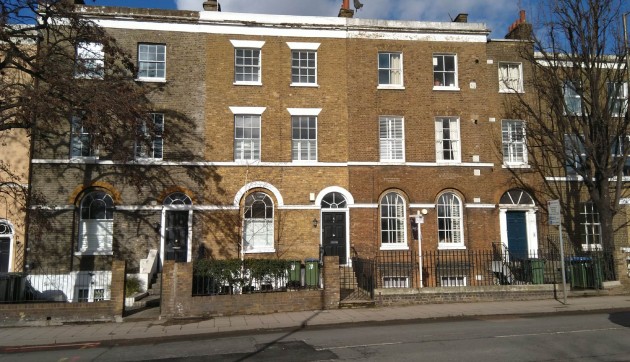
From left to right: 69, 71 and 73 Blackheath Road. Pond's house (number 71) is the one with the white window arches and cleaned brickwork. In Pond's time, it was known as 2 Valentine Terrace. The house to its right was larger and was originally the first house in the terrace. Photo, February 2021
Pond was not the first member of the Observatory staff to move to Valentine Terrace. John Belville had moved there from Park Terrace in 1833 (RGO6/1/56). It is not presently known which house Belville lived in, but according to an article in QJRMS 1888, his house was about 420 yards from Deptford Bridge, suggesting he lived at either number 9 or number 10. If that was indeed the case, his house and Pond’s house would have been separated by just seven or eight other houses. A post covid examination of the Greenwich rate books may shed further light on the matter.
Pond was close to Belville and this together with the fact that the house was available could well explain why he moved to Valentine Terrace. Although the Terrace, particularly the western end, had an air of grandeur, it was located on relatively low ground at about 80 feet above sea level at the foot of Blackheath Hill on the road to Dover (now the A2). According to the 1834 map of the parish of St Alphage by Morris, it was located opposite a terrace known as Cold Bath Row, where according to Henry Richardson, warm, cold and shower baths could be obtained at Mr Barnes’ establishment. The cold baths are understood to have been accessed from Blackheath Road via Ditch Alley which stood almost opposite Egerton Drive. They are believed to have been established in the eighteenth century and to have been located between Cold Bath Row and the River Ravensbourne.
The western end of the Terrace (37–45 Blackheath Road) was listed Grade 2 in 1973 as was number 73. Numbers 71 and 69 were added to the listing in 2011.
Listing entry for 37–45 Blackheath Road
Listing entry for 69–73 Blackheath Road
Burial at Lee
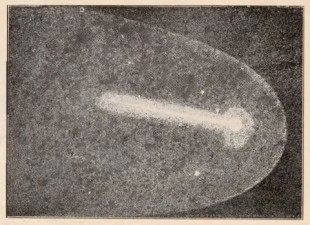
The 1835 reappearance of Halley's comet. Drawing by Sir John Herschel. From the January 1910 edition of The Popular Science Monthly.
Pond died at home a year after he retired on Wednesday 7 September 1836. His obituary in the Morning Chronicle (published on the same day as his funeral) states that his home was in Greenwich. That published later by the Royal Astronomical Society states that it was in Blackheath.
Pond was buried nearby on Tuesday 13 September at St Margaret’s Lee, in the same churchyard as his predecessors Halley and Bliss. But, as can be seen below, the burial plot was not a conventional one. Identical reports of the funeral were published in The Times and The Standard on Thursday 15 September. The first section is transcribed below:
‘On Tuesday last the remains of the late astronomer royal were deposited in the churchyard of Lee, Kent. They were attended to the grave by his successor, Professor Airy, by the three assistants of the deceased, by Mr Henry Warburton, M.P., together with a few relatives and personal friends. Mr Pond having always expressed a desire that the place of his internment should be the beautifully-situated churchyard of Lee, application was made to the rector for his consent to carry the wish into execution, but, on account of the place being small, and already so full that room was with difficulty found for the actual parishioners, permission was not in the first instance granted. On reflection however, the Rev. Mr. Lock, recollecting that the tomb of a former astronomer royal, the celebrated Dr. Edmond Halley, who died in 1743, and was buried at Lee, had never been tenanted by a single individual except that distinguished philosopher himself, and his wife and daughter, and considering that, as 93 years [23 in The Standard] had elapsed since he was therein deposited, it was highly improbable that any claim would be made in behalf of his descendents, with very good feeling directed that the receptacle of Dr Halley’s remains should also become that of one of his successors. Thus, by an accidental and remarkable coincidence, the material part of two philosophers, who held the same appointment, who, while living, inhabited the same dwelling, now rest in the same grave. …’
Whilst some parts of the report are corroborated by Airy, others are not. In his journal (RGO6/24), on 7 September he recorded: ‘Mr Pond died at 7 this morning’ and on the 13 September: ‘Rainy. This morning I attended Mr Pond’s funeral; only Mr Main and Mr Glaisher left at home.’ Main and Glaisher were both appointed by Airy. The remaining four assistants, Belville, Richardson, Ellis Snr. and Rogerson had all been appointed by Pond and Airy implies that all four of them were in attendance. Given that Belville had been Pond’s ward, it is possible that he was included amongst the relatives rather than the assistants in the press report. There is no mention of Anne Pond. Although one might assume that this was because at that time, women often didn’t attend funerals ... there might perhaps have been another reason.
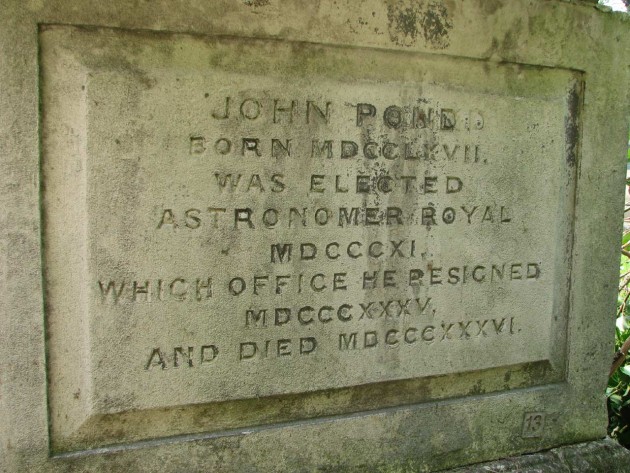
The inscription relating to Pond is on the east end of the tomb. Note the odd wording, particularly the use of the word elected. Note too, the uneven lettering, especially in the top line (particularly the two Ns) and the extra D at the end of Pond’s name. Photo: April 2007
Airy appears to have recorded nothing of the funeral arrangements at the time, but when applying to the Admiralty for funding to restore the tomb in 1854, he wrote: ‘I may mention that my immediate predecessor Mr Pond was (at his own desire) interred under the same tomb.’ (RGO6/74/64)
If Airy is correct, then Pond could be regarded as some kind of Halley groupie who wanted to be as close to his hero as possible. If The Standard is correct, then perhaps he should be considered simply as a cuckoo in the nest. Either way, it seems inconceivable an individual would be buried in this way today. The press reports were incorrect in one important detail. Halley’s grave was constructed to hold six coffins, Although the report above states that the tomb only held three bodies, there were in fact already five bodies in the grave, Halley and his wife, his eldest daughter Margaret and his youngest daughter Catherine and her husband. One thing was for sure, after Pond’s internment, the grave was full and there was no way that Anne Pond was ever going to be buried alongside him.
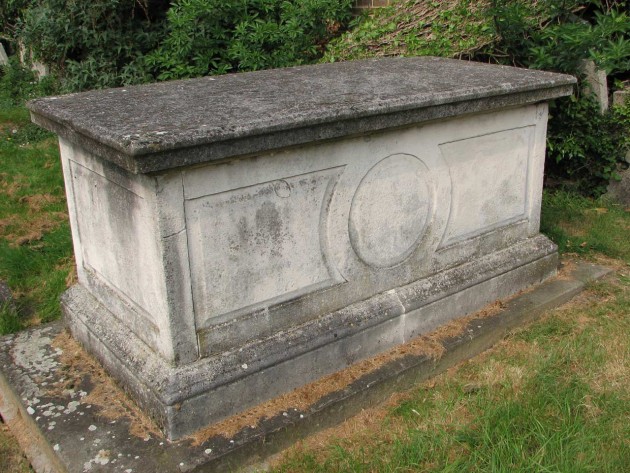
The shared grave of Halley and Pond. The inscription commemorating Halley is inscribed on the horizontal slab on the top of the tomb. Photo: April 2007
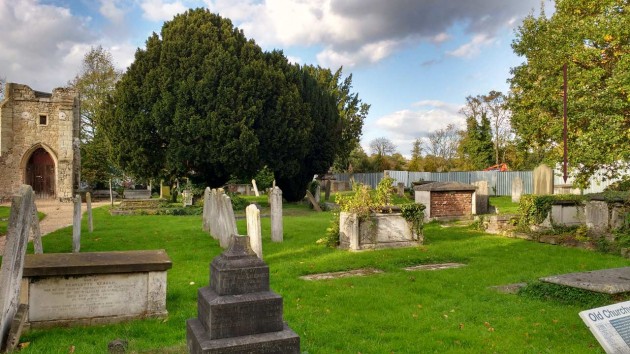
The old churchyard as seen from Lee Terrace on 5 October 2017. The arrow (right) shows the location of the tomb. An information board with a plan of the graveyard can be seen bottom right
The original church of St Margaret was of medieval origin. By the start of the nineteenth century, it was in a poor state of repair. Apart from part of the tower, it was pulled down in 1813 to make way for a new building on the same site. This was designed by Joseph Gwilt and incorporated the original tower in modified form. Gwilt’s church was built on the old foundations and like its predecessor suffered from structural problems. The population of Lee grew rapidly after the church was build and it was soon apparent that a much larger church was needed. Most of Gwilt’s church was demolished on 31 May 1841 having been replaced by the present larger church which was built on the opposite side of the road and constructed between 1839–41 to the designs of John Brown.
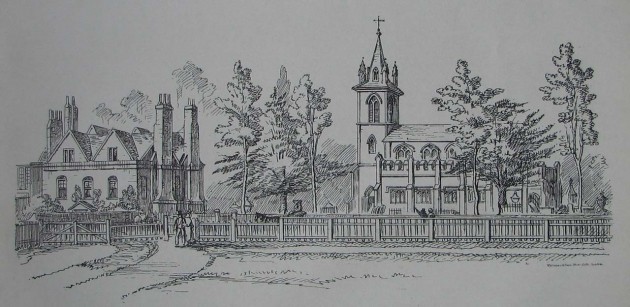
The second Lee Church. This is how the church would have appeared at the time of Pond’s funeral. The building to the left is the vicarage. From Drake’s 1886 revision of Hasted’s History of Kent ... the hundred of Blackheath
Click here to read more about the churchyard and the family grave of Edmond Halley and its restoration by the Admiralty in 1854 and 1909.
Last will and testament
The text below is a transcript of the last will and testament of John Pond, in which he left his entire estate to his friend Henry Warburton. Apparently drawn up at the Observatory by Pond himself, the will seems to have been written in a hurry and was technically void on account of Henry Warbuton being both a witness and a beneficiary. In order to prove the will, a third party was required to swear an affidavit that it was genuine. There were many people who could have done this. In a strange twist, the person selected was Henry Taylor, who had a serious conflict of interest since he was the brother-in-law of the disinherited widow. How and why this happened, we will probably never know. Despite the irregularities, probate was granted on 4 October 1836.
Although Anne Pond is not mentioned in the will, it is possible that she may have been able to claim a third of the estate under widows ‘thirds’ or ‘dower’. It is not known if this was done, nor is it known how large the estate was. Nor is it known why Pond’s ward, John Belville did not receive a legacy, especially as on 27 July 1831, Pond had written:
‘Rely on it that whatever becomes of me you will be comfortably provided for at the Observatory with proper diligence.’ (RGO6/1/58)
What we do know, is that 16 books and pamphlets from Pond’s library subsequently ended up in the Observatory Library due to Warburton’s actions as executor. Further research is required, but on the face of it, at least two, and possibly most of these items had been removed in error by Pond when he vacated Flamsteed House in 1835. At least five of the items are now in the Library of the National Maritime Museum as part of the Airy Library Collection.
When Warburton died in 1858 his estate was large, the entry in the probate register being ‘Effects under £45,000’. By contrast, the probate record for Anne Pond (who died in 1871) was ‘Effects under £300’.
*********
‘Royal Observatory Greenwich Park the eighth of December 1834.
This is the last will of J. Pond Astronomer Royal I give and bequeath the whole of my Property of every description whatsoever to my dearest and excellent friend Henry Warburton Esqr. member of parliament for Bridport in Dorsetshire and moreover appoint him sole Executor and administrator of this my last will. — Signed — John Pond — witness to the above signature William Rogerson (superscribed) Henry Warburton Esqr. M.P. Cadogan Place Sloane Street.
Appeared ~ personally the Reverend Henry Taylor of Elm Tree Road Saint John’s Wood in the County of Middlesex clerk and made oath that he knew and was well acquainted with John Pond late of Greenwich in the County of Kent Esquire deceased for several years before and down to the time of his death and with his manner and character of handwriting and subscription having frequently seen him write and also write and subscribe his name and having now with care and attention viewed and perused paper writing hereto annexed purporting to be and contain[?] the last Will and Testament of the said deceased the same beginning thus Royal Observatory Greenwich Park the eighth of December 1834 This is the last will of J. Pond Astronomer Royal” ending thus “and moreover appoint him sole Executor and administrator of this my last will and thus subscribed “signed John Pond” he the appearer saith he does verily and in his conscience believe the whole body series and contents of the said will beginning ending and subscribed as aforesaid to be all the own proper handwriting and subscription of the said John Pond deceased and of no other person whatsoever — Henry Taylor — On the first day of October 1836 the said Reverend Henry Taylor Clerk was duly sworn to the truth of this affidavit Before me J Haggard sur pres Chas Tebbs Noty Pub
Proved at London 4th October 1836 before the worshipful John Haggard letter of laws and surrogate by the oath of Henry Warburton Esquire the sole executor to whom administration was granted having been first sworn duly to administer.’
Source: Will of John Pond, Astronomer Royal of Greenwich , Kent (PROB 11/1868/180)
A pension for Mrs Pond – the intervention of Henry Warburton
When John Pond died, his pension died with him. Given the provisions in his will, it would seem that Anne Pond was unprovided for and according to Airy’s autobiography ‘left in great distress’. So much so, that on the 29 November, she wrote to Francis Beaufort at the Admiralty seeking a Government pension, stating that
‘Upon the final arrangement of the affairs of the late Astronomer Royal, I find that owing to the expenditure of his private fortune in the pursuit of science, I am left totally unprovided for, & that my only recourse is in appealing to the government for a pension, having no relatives who are in circumstances to afford me assistance.‘ (UKHO/LP 1857 311/P)
Without knowing the size of Pond’s estate, it’s impossible to know if this was true, or a cover for the fact that she had been excluded from the will. It also raises the possibility, given his ‘dislike to every thing like contention’ that for a while at least, Pond may have paid the salaries of his some of his assistants from his own pocket as well as paying the bills for some of the equipment he required. Whatever the truth of the matter, it would seem that Henry Warburton wrote to a number of influential individuals to secure testimonials from them in support of an application for a pension for her. The application
‘was accompanied by testimonials from Professor Airey, Professor Peacock, Professor Challis, Professor Rigaud, the Reverend Richard Sheepshanks, and the Reverend George Fisher, Messrs. Davies Gilbert, Francis Baily, Lubbock, Barlow, Riddle, Captain Smith, Professor Bessel, Professor Schamacher; and further documents were laid before the Treasury from Messieurs Biot and Arago.’ (Parliamentary Papers Vol 23, 1838).
The text of the letter written in support by Airy was published in his Autobiography and is reproduced below. The date on which it was written is currently unknown. It would have made the basis of an excellent obituary and deserves to be more widely known.
‘To Henry Warburton, Esq
The points upon which in my opinion Mr Pond’s claims to the gratitude of Astronomers are founded, are principally the following. First and chief, the accuracy which he introduced into all the principal observations. This is a thing which from its nature it is extremely difficult to estimate now, so long after the change has been made, and I can only say that so far as I can ascertain from books the change is one of very great extent: for certainty and accuracy, Astronomy is quite a different thing from what it was, and this is mainly due to Mr Pond. The most striking exemplification of this is in his laborious working out of every conceivable cause or indication of error in the Circle and the two Circles: but very great praise is also due for the new system which he introduced in working the Transit. In comparing Mr Pond’s systems of observation with Dr Maskelyne’s, no one can avoid being impressed with the inferiority of Dr Maskelyne’s. It is very important to notice that the continental observatories which have since attracted so much attention did not at that time exist or did not exist in vigour. Secondly, the attention bestowed by Mr Pond on those points (chiefly of sidereal astronomy) which he regarded as fundamental: to which such masses of observations were directed as entirely to remove the doubts from probable error of individual observations or chance circumstances which have injured many other determinations. Thirdly, the regularity of observation. The effect of all these has been that, since the commencement of Mr Pond’s residence at Greenwich, Astronomy considered as an accurate representation of the state of the heavens in the most material points has acquired a certainty and an extent which it never had before. There is no period in the history of the science so clean. On some matters (in regard to the choice of observations) I might say that my own judgment would have differed in some degree from Mr Pond’s, but one thing could have been gained only by giving up another, and upon the general accuracy no improvement could have been made. Mr Pond understood nothing of physical astronomy; but neither did anybody else, in England.
The supposed decrease of general efficiency in the last few years is to be ascribed to the following causes:
1. Mr Pond’s ill health.
2. The inefficiency of his first assistant.
3. The oppression of business connected with chronometers.
The last of these, as I have reason to think, operated very far. Business of this nature which (necessarily) is daily and peremptory will always prevail over that which is general and confidential. I will not trouble you with an account of the various ways in which the chronometer business teazed the Astronomer Royal (several alterations having been made at my representation), but shall merely remark that much of the business had no connection whatever with astronomy.
I beg to submit these remarks to your perusal, requesting you to point out to me what part of them should be laid before any of the King’s Ministers, at what time, in what shape, and to whom addressed. I am quite sure that Mrs Pond’s claims require nothing to ensure favourable consideration but the impression of such a feeling of Mr Pond’s astronomical merits as must be entertained by any reasonable astronomer; and I am most anxious to assist in conveying this impression.’
A pension of £100 a year awarded to Anne Pond on 25 February 1837. But in yet another strange twist in the saga of the Ponds, an additional £100 a year was awarded on 16 June 1837 (Parliamentary Papers Vol 39, 1837). The reason for two separate awards being given is unknown. One can only imagine that Anne Pond’s supporters felt the original settlement inadequate and perhaps intervened on her behalf for a second time. Given that only two years earlier a civil pension of £300 a year had been settled on Airy’s wife, Airy himself would have been well aware of the meanness of the original award.
Also in 1837, Anne Pond received the interest of the Royal Astronomical Society’s Lee Fund, which had been endowed with a gift of £100 from John Lee for the benefit of widows or orphans of deceased fellows (RGO6/229)..
Obituary
The first two obituaries below are identical. The formatting of the second makes it an easier read than the first.
Obituary of John Pond by unknown author Monthly Notices of the Royal Astronomical Society, Vol. 4, pp.31-37 (1837)
Obituary of John Pond by unknown author Memoirs of the Royal Astronomical Society, Vol. 10, pp.357-364
Pond’s obituary in the Morning Chronicle was published on the same day as his funeral. The text of his Obituary in The annual biography and obituary, is essentially a verbatim copy.
John Pond, Esq. Morning Chronicle (Tuesday 13 September 1836)
Obituary. The annual biography and obituary (1837)
The fate of the Westbury Circle
The detailed history of the Westbury Circle after Pond finished his series of Observations at Westbury in 1801 is unclear. In 1851, it was in the hands of William Simms (who had entered into partnership with Troughton in 1826). According to an entry in the Official descriptive and illustrated catalogue of the Great Exhibition of the works of Industry of all nations, 1851 (part 2), it was one of the instruments that was on display, having previously been repaired and redivided. In her book Transit Circle (1992?), Eleanor Mennim states (p.56), without quoting a source, that the instrument was repaired and redivided by Simms in 1823.
According to the Encyclopedia Britannica (7th edition,1841),
‘Its fame recommended it to the Glasgow Astronomical Institution, who purchased it and placed it in an observatory; but this scientific project failed, and we regret to say that its funds were reduced to such a state as to induce the institution to accept of fifty pounds for the Westbury circle. It passed into the hands of an eminent English astronomer who knew its value, and who put it into complete repair, and reckoned it a great acquisition. He, however, was rich in other instruments, and was induced to part with it for (as we have heard) four or five hundred pounds.’
In his book, The History of the Telescope p.236 (1955), Henry King states, without quoting a source, that the Westbury Circle was bought by James South for £50 and that it was he who got Simms to renovate it at a cost of £140. King went on to say:
‘Trouble arose over the work and in March, 1833, Simms accused South of selling the instrument to J. Scott, a London physician, for the apparently exorbitant sum of £400. In 1861, according to Charles Babbage, the instrument was sold at public auction for £17.10s.0d.’
That it was in the possession of South seems to be confirmed by an entry in Revue britannique (1833)
‘L'observatoire que sir James South a fait construire en 1827, sur la colline de Campden-Hill, à Kensington, près de Londres, est peut-être le plus splendide de tous ceux qui existent, parle nombre et la qualité des instrumens qui y sont renfermés. C'est là que se trouvent la belle lunette méridienne de Troughton, de sept pieds, avec laquelle M. South a fait des observations du soleil , dont la comparaison avec les Tables a indiqué quelques corrections nouvelles à faire à ces dernières ; le westbury circle, célèbre par les premières observations de M. Pond, et l'équatorial de Troughton, de cinq pieds de distance focale ...’
which translates as:
‘The observatory which Sir James South had built in 1827, on Campden Hill, Kensington, near London, is perhaps the most splendid of all that exist, by the number and quality of the instruments therein. This is where Troughton’s handsome seven-foot meridian telescope is found, with which Mr. South made observations of the sun, the comparison of which with the Tables indicated some new corrections to be made to the latter; the Westbury Circle, famous by Mr. Pond's early observations, and the Troughton Equatorial, five feet in focal length …’
The state of the instrument when purchased by South was not good. Its condition was described in an article in the 6 April 1871 edition of Nature by an individual writing under the initials T.R.R.
‘This [the Westbury Circle] was ultimately established at the old Observatory of the Glasgow University, and in an atmosphere still more sulphurous than that of London. When this University was broken up, and its instruments sold, this circle was purchased by the late Sir James South. But on its arrival at his Observatory it was found to have suffered so much that it actually fell to pieces! Only a few of the more massive parts were entire; and of the rims of the circle nothing remained except that which carried the divisions, which, as I was informed by Troughton, was of “Dutch brass,” and was quite unchanged.’
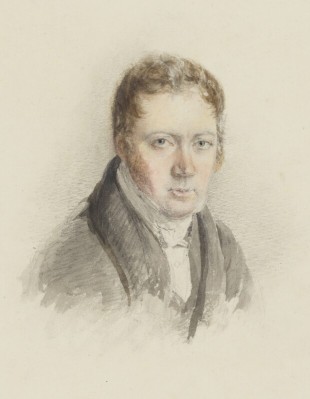
Andrew Ure (1778–1857), the first Superintendent of the Garnet Hill Observatory. Watercolour c.1820 by an unknown artist. © National Portrait Gallery, London. Reproduced under a Creative Commons Attribution-NonCommercial-NoDerivs 3.0 Unported (CC BY-NC-ND 3.0) licence (see below)
‘The Observatory is situated on Garnet Hill, about a mile north-west from the Cross. It was erected in 1810 by the Society for promoting the science of Astronomy. Its architecture is in the Egyptian style, from designs by Mr. Webster of London, and it is divided into three compartments. The centre forms the Scientific Observatory, crowned with a revolving cupola; the eastern division is the Popular Observatory; and the western is fitted up for the observer and other purposes. The situation is admirably chosen; and the institution is completely supplied with all books, instruments, and apparatus, necessary to advance the science for which it is appropriated. Subscribers in the city, and within the distance of six miles, are entitled to introduce their families. The above society having lately dissolved, the property has been purchased by some individuals with a view to place it on a more popular and efficient footing than formerly.’
According to an article in Bibliothèque universelle des sciences, belles-lettres et arts ..., Volume 26 pp.254-256 (1824), the main bulk of the Observatory’s instruments were put up for sale by auction and were due to be sold on 9 January 1823, the Westbury Circle having already been sold.
The most definitive account of the return of the Westbury Circle from Glasgow to London and its subsequent repair comes from The annals of philosophy, new series, Volume 6, p.397 (1823):
‘To most of our astronomical readers it is probably known, that on the return of the Westbury circle to London during the last winter, it was found in a state “unfit for any nice astronomical purpose:” it has, however, under the superintendance of Mr. Troughton, undergone a complete repair; to secure the telescope from flexure, its original object glass of 23 inches aperture, and 43 inches focus, has been replaced by one of the like diameter, but whose focal length is 38 inches only; it separates many of the close double stars, shows distinctly the double ring and belts of Saturn, and was made by Mr. Tully. The artist who has had the immediate management of the repairs is Mr. Simms, of Bowman’s-buildings, Aldersgate-street, and we are glad to know that an instrument which has rendered such essential service to astronomical science is again fit for immediate use. We quote the inscription it now bears with pleasure.
“With this instrument, the work of Edward Troughton, Mr. Pond substantiated the errors of the Greenwich mural quadrant; the observations were made at Westbury, and are recorded in the Philosophical Transactions. The instrument, having suffered from long exposure to the weather, was repaired and redivided for Mr. South, by William Simms, under the direction, and to the satisfaction, of its illustrious maker.”
– Aug. 10, 1823.’
It would appear from an article published in the The Star (London) on 21 August 1810, that the Westbury Circle was amongst the first (if not the first) of the instruments to be acquired by the Observatory in Glasgow. After describing a visit to the Observatory by William Herschel, the article went on to describe how the Westbury Circle came to into the Observatory’s possession:
‘It must be deemed a most fortunate event for the Glasgow Observatory, that the Directors have procured Mr Pond’s magnificent instrument from the heirs of the Hon. Mr. Greville, who had purchased it for a scientific institution analogous to our own, which he had begun to erect at Milford-Haven, when death put an unexpected termination to his patriotic plans. The similarity of the objects induced his executors to part with the astronomical circle for a sum far below its intrinsic value. Indeed, the Directors of the Glasgow Society have reason to believe that a similar instrument could not be obtained, for less than 300 guineas above what they have paid’.
Although Charles Greville (who was a fellow of the Royal Society) had acquired the Westbury Circle for the Hakin Observatory at Milford Haven in Wales (where Maskelyne’s Assistant Thomas Firminger had been appointed Astronomer), it was never erected there. Nor were any of the other instruments he acquired for it. Greville died on 23 April 1809, and according to Lewis Evans (The Monthly Magazine, Vol 41 pp.483–484 (1816), after sitting unopened in their packing cases for about a year after Greville died, they were sent to Troughton for resale in London. Amongst them was the famous Lee Circle (as it came to be known) which is signed Troughton London 1793. Made by Troughton for Gavin Lowe of Islington, it was bought by Greville in 1807 and sold to Evans in 1810. When it was that Pond sold the Westbury Circle to Greville is unknown, but it was clearly no later than 1809.
Some incorrect statements published about Pond
On the location of Westbury
Although Pond clearly stated in his 1806 paper that his Altazimuth Circle was set up at Westbury Somersetshire and gave the colatitude of the instrument, it hasn't stopped people referring to the wrong Westbury since the earliest of times:
‘... he settled himself, on his return, at Westbury, near Bristol, where he resided till his marriage in 1807.’ (Augustus De Morgan, Penny Cyclopedia 1840)
‘In 1800 he settled at Westbury near Bristol ...’ (Encyclopedia Britannica 1885)
‘In 1800 Pond settled at Westbury [link to Westbury on Trym] near Bristol ...’ (Wikipedia, 2003–2020)
‘Working at Westbury, Wiltshire, with a Troughton altazimuth of superior design and construction, Pond found systematic differences between his reduced values …’ (1976)
That Pond settled in Wells
‘By 1799 Pond had returned to England, where he settled in Wells, Somerset, and set up an observatory at Westbury-sub-Mendip.’(ODNB 2005)
On the date of taking up office
As mentioned in a section above, Pond technically took up office when the Royal Warrant appointing him was signed in February 1811. Documentary evidence suggests that he took up residence at Greenwich on 13 April 1811. This has been and continues to be miscommunicated as follows:
‘When John Pond took up his appointment as sixth Astronomer Royal on 13 April 1811, ...’ (1975)
‘John Pond was appointed Astronomer Royal on the 13th of April 1811’ (2011?)
‘...John Pond took up his post as the 6th Astronomer Royal in succession to Maskelyne on 13th April 1811, ...’ (2020)
On the Chingford Obelisk
Ground based marks accurately placed on the meridian were regularly used by the Greenwich astronomers as a quick means of determining the alignment errors of their transit instruments. In 1824, Pond had a granite obelisk erected on Pole Hill at Chingford some 11 miles to the north of the Observatory.
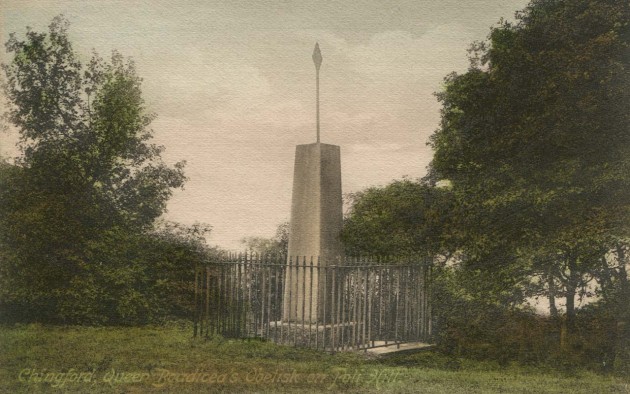
Dating from 1911, this is the oldest known image of the obelisk. Although the obelisk and railings both date from 1824, the vane (the arrow like structure) on top was not added until much later (after 1869). Postcard by F. Frith & Co. Ltd. Reigate
In 1935, the then Astronomer Royal, Spencer Jones, reported to the Board of Visitors that:
‘It [the pillar] is now an object of curiosity to visitors to the site. The pillar is on land vested in the Epping Forest Commissioners (City of London Corporation). The Corporation has agreed to fix an inscription to the pillar, explaining the purpose for which it was erected and used. The Greenwich meridian, as changed in 1850 and adopted by international agreement in 1884 as line of zero longitude, passes 19 feet to the east of the pillar.’
The erection of the plaque coincided with the start of the retriangulation of Great Britain for which the nearby trig point was erected. It was probably a no lesser authority than the Astronomer Royal himself who helped promote the myth that Greenwich Meridian was actually adopted (rather than adopted in principle) as the Prime Meridian in 1884 – a result no doubt of the need for brevity not only on this plaque, but a similar one back at Greenwich that was erected at about the same time. The text on the plaque also contained at least one and possibly two rather more serious errors. It described Pond as the ‘Reverend John Pond, M.A.’ Firstly, unlike most of his predecessors (Flamsteed, Bradley, Bliss and Maskelyne), Pond had not been ordained and was not a Reverend. Secondly, although Pond may have obtained a Cambridge M.A., he is not shown as having been awarded such a degree in Alumni Cantabrigienses from the earliest times to 1900. It is not presently known who was responsible for the wording on the plaque. There is also an incorrect reference to the ‘Revd Pond’ in the autumn 2012 edition of the SHA Journal.
Click here to read more about the Chingford Obelisk
And a case of two typos, (or complete ignorance?)
‘ The tedium of extracting positions in such tables is reflected in the plea of the Astronomer Royal John Bond about 1834 in requesting an increase in his staff of assistants: "I want indefatiguable, hard-working, and above all, obedient drudges ...” ’ (1988/9)
Will of John Pond Senior
The text below is a transcript of the last will and testament of John Pond (1734–1793), the father of John Pond (1767–1836), the Astronomer Royal. It was written in the same year that he died. In order to make it easier to read, it has been punctuated and reformatted.
*********
This is the Last Will and Testament of me John Pond of Dulwich in the Parish of Camberwell in the County of Surry Gentleman.
I first Will that all my Just Debts and Funeral Expenses as also Proving this my Will ar Discharged and Satisfied.
I give and bequeath unto my truly esteemed and beloved Wife Mary Pond all my Household Goods, Linens (?), China, Plate and all my Pictures and Prints, framed and Glazed, hung up in my Dwelling House and Within my Cellar; as also Two hundred volumes of my Books which she shall make choice of out of my Library.
I give unto my said Wife Mary Pond the Sum of One hundred pounds to be paid her out of any Money I have in my hands at my decease or the first Money that shall come into the hands of my Executors after my decease.
And whereas I am possessed of an annuity of Seventy pounds per Annum for and during the life of Mary Slater now Gibson for and during the life of the said Mary Slater and amply secured on several Freehold Estates, and that the life of the said May Slater is insured in the Equitable Assurance Office in Black Friars for the sum of Five hundred pounds, I give and bequeath the said Annuity of Seventy pounds with all the Interest of the Policy of Assurance made thereon with all the arrears that may be due thereon at my decease unto my Wife Mary Pond.
And Whereas at the renewal of the Lease of the Hospital Land at Croydon the (?) Lease[s] by mistake was made in my name, to avoid any Misconstruction or Misunderstanding that may be made thereon, It is my Will and desire that my Wife shall enjoy all the benefits of the said Lease in as full and ample a manner as was the Will of her Father Robert Smith.
I give and devise unto my said Wife the Lease of a small parcel of land at Bromley in Kent granted by Edward Burrow Esquire.
I give and devise unto my son John Pond All my Copyhold (?) Estate situate at Little Baddow in the County of Essex. To hold the same according to the Custom of the said Manor to himself and his Heirs forever. As also all the arrears of rent that may be due thereon at the time of my decease.
I likewise give unto my said son John Pond all my Right Tith and Interest Mortgage thereon with all Arrears of Rent or Interest that may be due thereon at the time of my decease to all that Copyhold Estate at Lambeth now let on Lease to John Pullen and Hammond (?) and late the property of Charles Cleland.
I likewise give unto my said son my Gold Horizontal (?) Watch and my Diamond Cluster Ring.
I give unto my said Son that Annuity of Forty pounds per Annum on the life of Henry Byrne (?) with all the Interest on the policy for Insuring the life of the said Henry Byrne (?) with all the Interest due at the time of my decease.
I likewise give unto my son All the remainder of my Library of Books, Prints and Books of Prints, except those devised above.
I give and bequeath unto my Brothers in Law Robert and Charles Smith all my freehold Ground, Messuages and Tenements situate in Great Queen Street in the Parish of Saint Gyles in the Fields, with all the Appurtenances thereunto belonging. To hold the same in trust only for and during the life of my Wife Mary Pond and pay or cause to be paid unto my said Wife out of the rents and profits of the said premises the Sum of Fifty pounds per Annum for and during the natural life of my said Wife Mary Pond; and to pay the rest Residue and remainder (?) of the produce of the said Estate unto my Son John Pond his Heirs and Assigns. And from and after the decease of my said Wife I give and bequeath all the said Freehold Ground, Messuages or Tenements with the Appurtenances belonging unto my Son John Pond his Heirs and Assigns forever.
And Whereas my Cousin Mary Pond is indebted to me in several Sums of Money for which I have her Notes of Bond, I do hereby release her from all such Sums, both Principal and Interest, and of any other debt she may owe me at the time of my decease.
I give unto my Sister Frances Roberts Fifty pounds and unto my Sisters Deborah Smith and Mary Pistor Ten Pounds each for Mourning.
I give unto my Nephew John Roberts the five Guinea Gold Piece in my possession with the Silver (?) Box wherein it is contained and which were both the [gift?] of his Father to me, as a Testimony of my friendship for him; as also One Guinea for a Ring in Memory of me.
I also give to my Nephew Edward Roberts and to his Sister Frances Roberts One Guinea each for a Ring. I give unto my Brothers in Law Robert and Charles Smith, Felix Smith and Johnson (?) Pistor five Guineas each and that Rings may be given to my Worthy and good Friends Dr Allen Richard Durnford, John Morland (?), Francis Fisher, Mary Morland.
I am in possession of a Policy of Insurance on the life of the Rev. Mr Whetham (?) for Six Hundred Pounds, which by the increase of the Fund of the Society is worth Nine Hundred when claimed (?). It is my wish, And I strongly recommend it to my Executors, to pay the Annual premium thereon that they may receive the full benefit of [it?].
All the rest Residue and Effects, whatever Monies in the Pubclick Funds or what other Securities I may be possessed of at the time of my decease, I give unto my dear Wife Mary Pond and unto my Son John Pond equally, share and share alike; and that my wife do take the aforenamed bequests and accept the same in lieu and in full satisfaction and recompense of all and every the Covenants and Clauses and Agreements mentioned and contained in her Marriage Settlement, and of all claims and demands for her Dower of Thirds of and in my said Estates or either of them.
And I make Constitute and Appoint my Wife Mary Pond and my Son John Pond Executors of this my Will. With respect to my Interment, as my health is very precarious and the Place of my decease very uncertain, I leave that to the Will and discretion of my Executors, only requiring that as little may be expended thereon as is consistent with decency.
Lastly I do hereby declare this to be my last Will and Testament, wrote with my own hand and contained in two Sheets of Paper, to the first of which I have set my hand and to this last Sheet my hand and Seal this twenty third of April One Thousand Seven hundred and Ninety three.
John Pond (Signed by him?)
Signed Sealed and delivered by the aforenamed John Pond and by him Published and declared to be his last Will and Testament in the presence of us who have set our hands as Witnesses thereto in his Presence: John Newberry – Thomas Walker – Elizabeth Spenning
I Give unto my Friends Jeremiah Greenland and Mainwaring Davies to each a Ring. John Pond
This is a Codicil to the last Will and Testament of me John Pond of Dulwich in the County of Surry.
I Will and direct that the first Quarterly payment of the Annuity which I have given to my Wife Mary Pond in and by my said Will and charged on my Estate in Great Queen Street, Lincolns Inn Fields, shall begin and be made on the first Quarter day next after my decease; and that the same shall cease on the last Quarter Day next preceeding the decease of my said Wife.
And I hereby Will and direct that all Expenses Attending the repairs of my Estate at Baddow in Essex shall be paid by my Son John Pond out of the provision which is made for him in and by my said Will.
And I give and bequeath unto my said Son the debt or sum of Money which is now due and owing to me from Francis Slop of Pisa (?).
In Witness whereof I have hereunto set my hand this first day of September 1793.
John Pond
Witness Tho (?) Roberts
This Will was proved at London with two Codicils on the eleventh day of October in the year of Our Lord One thousand Seven hundred and Ninety three before the Worshipful Samuel Pearse, Parson, Doctor of Laws and Surrogate of the Right Honourable Sir William Wynne, Knight, Doctor of Laws and Master Keeper or Commissary of the Prerogative Court of Canterbury, lawfully constituted, by the Oaths of Mary Pond, Widow, the relict of the deceased, and John Pond, the Son of the said deceased, the Executors named in the said Will, to whom Administration was granted of All and Singular the Goods, Chattels and Credits of the said deceased, having first been sworn duly to Administer.
Source: Will of John Pond, Gentleman of Camberwell, Surrey (PROB 11/1238/43)
Transcribed by: Andrew Wells
Further Reading
John Pond. Agnes Clerke. Dictionary of National Biography, 1885–1900
John Pond. C. Andrew Murray. Oxford Dictionary of National Biography (2004)
John Who? the sixth Astronomer Royal. Rebekah Higgitt. Royal Museums Greenwich Blog (2011)
Sketches of the Royal Society, and Royal Society Club. John Barrow, 1849
The Royal Society of London 1800-1835: a Study in the Cultural Politics of Scientific Organisation (David Philip Miller. (PhD thesis, University of Pennsylvania, 1981)
The library and archives of the Royal Society (1660-1900). Marie Boas Hall (1992)
The Role of Patronage in early nineteenth-century science, as evidenced in letters from Humphry Davy to Joseph Banks. Tim Fulford, Royal Society Notes and Records (2019)
The Board of Longitude and the funding of scientific work: negotiating authority and expertise in the early nineteenth century. Sophie Waring, Journal for Maritime Research (2014)
A Place for Managing Government Chronometers’: Early Chronometer Service at the Royal Observatory Greenwich. Yuto Ishibashi. The Mariner's Mirror (2013)
An Age of Expansion. Chapter 8, Greenwich Observatory, Vol 1. Eric Forbes (1975)
Platinum and Palladium in Astronomy and Navigation. The Pioneer Work of Edward Troughton and William Hyde Wollaston. John A. Chaldecott, Platinum Metals Rev., 1987, 31, (2), 91
The church in Madras: being the history of the ecclesiastical and missionary action of the East India Company in the Presidency of Madras in the seventeenth and eighteenth centuries. Volume 3. Frank Penny (1922)
An account of the repeating circle and of the altitude and azimuth instrument. Edward Troughton. From the Transactions of the Astronomical Society of London (1821)
John and Edward Troughton, mathematical instrument makers. Alec Westley Skempton and Joyce Brown. Royal Society, Notes and Records (1973). Appendix [and references]: The dating of Troughton Instruments. Alec Westley Skempton
Libraries and archives
In addition to materials held in the RGO archives at Cambridge and the National Archives at Kew, the following archives are known to hold Pond related materials.
4. Mrs Pond, Royal Observatory, 30 April n.y. [1827], to Dionysius Lardner, 3p. Ms. Testimonial by John Pond, Astronomer Royal
62. John Pond, no place, n.d. [endorsed 'March 1829'], to [Dionysius Lardner], 1p.Ms.l
John Herschel correspondence in various archives (catalogue compiled by the Adler Planetarium)
Royal Astronomical Society, Correspondence of William Herschel / John Pond
7 Aug. 1795, 13.P.56; 29 Dec. 1796, 13.P.57; 22 Aug. 1799, 13.P.59; 22 Oct. [—], 13.P.60; n.d., 13.P.61; n.d., 13.P.62. n.d., 13.P.58; 12 Oct, 1811, 13.P.63.
University of Reading Special Collections, Correspondence to John Pond
MS 1393 1/97/284, Abraham Rees Correspondence (1812)
United Kingdom Hydrographic Office (UKHO) archive
LP 1857 P/15, LP 1857 P/16, LP 1857 P/17, LP 1857 P/18, LP 1857 P/19, LP 1857 P/20, LP 1857 P/21, LP 1857 P/22: Letters from John Pond 1829–1831
LP 1857 52/S. 1 Jul 1834. Sir James South writes in scathing terms of Mr John Pond, saying that "the Observatory of Greenwich during his astronomer Royal-ship has been an object of pity"
LP 1857 311/P. 29 Nov 1836. Letter from: Pond, Mrs A G. Mrs A G Pond, widow of the late Astronomer Royal, seeks a Government pension, saying that Mr Pond had expended all his private fortune in the pursuit of science
Bedfordshire Archives & Records Service
L 30/18/58/1. Letter, From Henry Warburton, London to George Eden, 2nd Lord Auckland. Refers to the proposed retirement of John Pond, from the position of Astronomer Royal; includes a précis of his work, 1 November 1834
L 30/18/3/1. Draft letter from Earl de Grey to Duke of Sussex. recommending the retirement of Mr Pond, Astronomer Royal on a Pension. 2 April 1835?
National Maritime Museum – various papers including:
Chronometer ledgers
NMM/MSK. Papers of Reverend Nevil Maskelyne, 1732-1811, and other members of the Maskelyne family
ADM 359/40B/48: Incremental salary increases for the assistants (NMM/ADM/BP/40B)
ADM 359/45/46: & ADM/359/45/47: Chingford Obelisk (NMM/ADM/BP/45)
ADM 359/47B/60: Housing in Greenwich Park (ADM/BP/47B)
Corbett autograph collection (Cadbury Research Library: Special Collections, University of Birmingham)
MS21/2/2/52. Henry Warburton, undated letter to Mrs Pond arranging a time for a meeting.
Acknowledgements
Special thanks are due to the following individuals for the assistance they have given: Daniel Beltiki, David Rooney, Sian Prosser, John Williams, Philip Taylor, and the owners of Denver House in Westbury.
Image licensing information
The detail from the 1884 Ordnance Survey map of Westbury (Sheet 27. S.E.), is reproduced with the permission of the National Library of Scotland under a Creative Commons Attribution 4.0 International (CC BY 4.0) licence. Click here to view the original.
The following images are reproduced under the terms of a Creative Commons Creative Commons Attribution-NonCommercial-ShareAlike 4.0 Licence (CC BY-NC-SA 4.0) courtesy of The Board of Trustees of the Science Museum.
Sir William Watson’s 7-foot reflecting telescope by William Herschel. Object Number: 1876-1000 Pt1
Sir Joseph Banks (cropped from the original. Object Number: 1982-333/3
The images reproduced courtesy of Cambridge Digital Library have been reproduced under the terms of a Creative Commons Attribution-NonCommercial 3.0 Unported License. Some of the images have been reduced in size, some are have been slightly cropped and all are more compressed than the originals.
Click here to view the original image of the letter appointing Pond to the position of Superintendent of Chronometers.
Click here to view the original image of the kitchen garden.
Click here to view the original image of the letter of 21 March 1811 from Joseph Banks to Margaret Maskelyne.
Click here to view the original image of the note attached to the cover of the inventory of books and manuscripts left for Pond by Margaret Maskelyne and click here for the list of books it contained.
Click here to view the original image of the letter sent by Anne Pond to Margaret Maskelyne (dated 12 June 1839).
Click here to view the original image of the receipt signed by James Gordon Bradley
Click here to view the table compiled by Maskelyne showing work assigned to the Computers and Comparers for the 1815 and 1816 volumes of the Nautical Almanac.
Click here to view Maskelyne’s notes on the books, instructions etc. sent to Thomas Brown.
Click here to view the original image of the letter of 28 August 1784 from Joseph Banks to Nevil Maskelyne.
The following images are © National Portrait Gallery, London and are reproduced under a Creative Commons Attribution-NonCommercial-NoDerivs 3.0 Unported (CC BY-NC-ND 3.0) licence.
Frederick Walter Simms by Maull & Polyblank. Albumen print, arched top, 1855. National Portrait Gallery Object ID: NPG P120(8)
Thomas Young by Charles Turner, published by Colnaghi, Son & Co, after Sir Thomas Lawrence. National Portrait Gallery Object ID: NPG D20338
Sir Humphry Davy. President of the Royal Society, 1820–1827. Oil on Canvas, by Thomas Phillips, 1821. National Portrait Gallery Object ID: NPG 2546
Sir John Frederick William Herschel, 1st Bt by Henry William Pickersgill, pencil, circa 1835. National Portrait Gallery Object ID: NPG 1386
William Hyde Wollaston, by William Ward, after John Jackson. Mezzotint, early 19th century. National Portrait Gallery Object ID: NPG D36339
John Barrow, Second Secretary to the Admiralty. Oil on canvas circa 1810. Attributed to John Jackson. National Portrait Gallery Object ID: NPG 866
William Henry Duke of Clarence. Henry Edward Dawe, after Charles Jagger. Mezzotint, circa 1830s. National Portrait Gallery Object ID: NPG D8125
Andrew Ure. Watercolour c.1820 by an unknown artist. National Portrait Gallery Object ID: NPG 2876
The image of Thomas Bradley is reproduced in cropped and compressed form under the terms of a Creative Commons Attribution only licence CC BY 4.0 courtesy of Wellcome Library, London
The following images are reproduced under the terms of a Creative Commons Attribution 4.0 International (CC BY 4.0) licence courtesy of the University of Cambridge, Institute of Astronomy Library.
Samuel Vince (1749–1821), Plumian Professor of Astronomy. Engraved by R. Cooper, drawn by T. Wageman, published by T. Clay, London 1821. Download original image here.
Francis Baily, (1774-1844) President of the Royal Astronomical Society, c.1829. Engraving by Thomas Lupton after Thomas Phillips. Download original image here.
Lithograph of George Airy by Isaac Ware Slater, after Thomas Charles Wageman. Download original image here. The date of 1833 is taken from Airy’s autobiography p.102.
© 2014 – 2025 Graham Dolan
Except where indicated, all text and images are the copyright of Graham Dolan
